- Skip to primary navigation
- Skip to main content
- Skip to primary sidebar
- Skip to footer
Yacht Cruising Lifestyle
Everything fun you can do from your yacht

Choosing the Best Dinghy for Your Boat
January 7, 2021 by Travis Turgeon 5 Comments
At anchor, a dinghy boat serves as your lifeline to everything from leisurely excursions to provisioning trips. Every captain or crew will use their dinghy differently, so it’s essential to consider what features and functions are important to you.
Do you plan to explore remote areas away from anchor? Do you plan to fish, snorkel, or dive from the dinghy? How many people will you need to carry at once? Every aspect should play into your decision.
Below, we cover the following to help you choose a dinghy that’s right for your boat:
- Key Factors to Consider
- Types of Dinghies
- Outboard Motors
General Information and Tips
What should i consider before buying a dinghy for my boat.
Make the following considerations before purchasing a dinghy for your boat:
- DInghy Storage
- Carrying Capacity
- Use of the Vessel
Dinghy Storage
Storage should be a defining factor when purchasing a dinghy for your boat. There are several common ways to store a dinghy, but not all storage is suitable for every vessel. A rigid dinghy will need enough space to be tied on the deck or at the back of the boat, while you can stow an inflatable dinghy in lockers or lazarettes.
Regardless of where you choose to keep your dinghy on the boat, it should be in a location that does not reduce drag, restrict access to important areas, or prevent easy access for storage and use.
The most common options are:
- Dinghy Davits
- On-Deck
- Locker
Davits: Permanently installed at the stern of the boat, davits are used to store, deploy, and retrieve your dinghy from the water. Davit storage is standard for any dinghy that’s too heavy to manually lift in and out of the water. Although storage on dinghy davits is convenient, it poses a risk when sailing through heavy seas. Large waves and wind can cause the dinghy to flood while in transit, and the weight can damage the stern of the boat or the davits.
On-Deck: Some people choose to tie the dinghy upside-down at the bow, stern, or side of the boat. For this to be an option, you need sufficient unused space on the deck, and you need to be sure that the dinghy is not interfering with any important pathway or area on the boat.
Swim-Step: Boats with an elevated swim-step can accommodate a dinghy at the boat’s stern as long as it’s elevated far enough out of the water. Keep the dinghy tied aerodynamically and tilted so that it doesn’t fill with water.
Locker: Roll-up inflatable dinghies are easily deployed and retrieved from the water by hand, and they can be deflated and stored in a locker anywhere onboard.
Towed: For nearshore journeys in calm conditions, you can easily pull the dinghy behind your boat. Be careful, though, as high speeds and choppy seas can cause a dinghy to flip in the water.
Dinghy Carrying Capacity
If you’re sailing with multiple crew or passengers, you will want a dinghy that can carry the same amount of people. Making numerous trips from ship to shore will not only cost you time, but it will also run up fuel costs. Further, you’ll want extra room for luggage, provisions, recreational gear, and anything else that may find its way onto your boat.
The handling in your dinghy can become problematic when loaded beyond capacity, so use caution – especially in rough seas. Safety should always be a top priority, so the goal is to aim for the biggest dinghy you can get without sacrificing too much storage space.
Dinghy Material
Rigid dinghies are most commonly made of fiberglass or aluminum, but you can opt for a more classic wooden design as well. The material will partially dictate where the dinghy can be stored and the need for equipment such as dinghy davits. While fiberglass hulls are cheaper than aluminum, they also come with the burden of a heavier weight. Alternatively, aluminum hulls will outlast their fiberglass counterparts, but for a higher price. Overall, rigid dinghies can withstand wear-and-tear better than inflatables, although routine maintenance is required.
Inflatable dinghies are kept afloat using tubes surrounding the boat’s hull, commonly made of either PVC or CSE. CSE, or “Hypalon,” is a synthetic rubber material that is highly resistant to chemicals, UV light, extreme temperatures, and abrasion. CSE is a lot like PVC, but it’s lighter and has more UV and water-resistant properties. It’s also more abrasion resistant, making it ideal for taking to shore. CSE offers a longer service life and a more extended warranty, although again at a higher cost. The most common complaint you’ll hear about CSE is the rate at which the air escapes from the tubes. On average, CSE tubes lose about 15% of their air within 24 hours, while PVC loses under 7%.
PVC is an excellent alternative to the more durable CSE, as the material still offers a reasonable service life at a lower cost. PVC is also much lighter, more convenient to fold, and easier to clean than CSE. The biggest potential problem with PVC is simple neglect and lack of maintenance. If cared for properly, modern PVC materials can last long enough to justify not paying the higher costs for CSE.
For some excellent tips on maintaining your inflatable dinghy, check out Sail Magazine’s Tender Choices article , here.
How You’ll Use The Dinghy
The last factor to consider is how you intend to use the vessel. Will you be traveling long distances from anchor? Exploring remote locations? How many people do you need to transport? Do you need special features to accommodate scuba diving and fishing? You should do as much research as you can to ensure that you’re buying a tender that suits your needs while staying within your budget. Below, we discuss the difference between each type of dinghy – and who each is best suited for.
Types of Dinghies
Choosing the right type of dinghy for you and your boat will require some careful thought. Your dinghy is your primary source of transportation between journeys, and you’ll want to make sure that your purchase is fitting for your immediate and future needs.
The three most common types of dinghies are:
Rigid Boats
Inflatable boats, rigid inflatable boats (rib).
Hard-body (rigid) dinghies are among the simplest styles of tender, and they come in a variety of shapes, sizes, and materials. Rigid dinghies are sufficient for those who don’t need to travel long distances or through rough conditions. However, more and more people are moving to inflatables or semi-inflatables for their wide range of abilities when needed.
When considering if a rigid dinghy is right for you, think hard about the material each is built with. For the hull specifically, the materials will affect the price, durability, and cosmetics of the vessel, as well as the weight and ability to transport. Most rigid dinghies are constructed with fiberglass, aluminum, or wood and have a lower carrying capacity than inflatables. They also have less stability when entering, exiting, and moving through the water.
Advantages:
- Easily Propelled
- Puncture Resistant
- Outboard Compatible
- Low-Cost Option
- UV Resistant
Disadvantages:
- Easily Scratched and Blemished
- Adequate Storage Space Required
More popular than rigid dinghies and less popular than RIB’s, inflatables offer a good middle ground for those looking to compromise between cost and functionality. The large PVC or Polyurethane tubes in the front and sides of the boat are more stable than rigid vessels and allow for a higher carrying capacity due to their buoyancy. Compare those benefits with the low costs of materials, and it’s easy to see why inflatables are so popular.
There are numerous variations of Inflatable dinghies, with the most common being:
- Soft Bottom Roll-Up
- Rigid Floor with Soft Bottom
- Soft Bottom with Rigid Transom
Dinghies with soft bottom have the widest variance in configuration. Some have rigid transoms where an outboard motor can be mounted. Some have rigid, removable floors, and some have an inflatable keel that increases the vessel’s stability and planing abilities. Other than the lower-end inflatables, though, almost all will have stable floors and a captain’s seat. Rowing is difficult in rough conditions, so inflatables are most commonly used with a 5-10 horsepower outboard.
Roll-up inflatables are easily stored, don’t take up much space, and are the lightest of all inflatable options. They also have the least to offer in functionality, and since most don’t have a rigid transom, they must be rowed by hand. Unless you only plan to use the vessel in calm conditions, you should consider dinghies with hard floors and transoms.
Soft bottom dinghies with rigid floors and transoms are more ideal, as they can be used efficiently in a wider variety of situations. The ability to mount an outboard allows you to use the vessel in harsher conditions and travel greater distances. The rigid floors allow you to use the vessel for fishing, diving, provisioning, and more without sacrificing stability and comfort.
- Lightest Option
- Easily Compacted and Stored
- Easily Damaged and Punctured
- Consistent Maintenance Required
- Low Efficiency
The RIB design is a cross between a soft bottom and rigid hull and gives you the most bang for your buck in the water. The hard-bodied hull makes for a stable and damage-resistant body, while the inflatable tubes add optimal stability. The RIB design is so efficient that it’s even used by the US Military and Coast Guard. The tradeoff you make with a RIB is portability and storage, as the hull can not be taken apart or broken down. However, this can be overlooked by carefully choosing a RIB that’s right for your boat. If you’re looking to outfit your boat for scuba diving , a RIB should be pretty much your only consideration for a tender.
Rigid Inflatable Dinghies are the most popular type of dinghy for cruising sailors, and it’s easy to see why. RIBs used as dinghies are commonly between 10 and 15-feet long, with anything larger being reserved for massive yachts with dinghy garages or excess storage space. RIBs are typically stored on davits or lashed upside down somewhere on the deck of the boat. For shorter trips near shore and in calm conditions, you can tow the RIB behind the boat.
Typically, RIBs are available with either aluminum or fiberglass hulls. Aluminum is lighter and stronger than fiberglass, although you should expect to see a price tag that matches those benefits.
- Optimal Speed, Handling, and Stability Rugged
- Limited Storage Options
Outboard Dinghy Motors
After choosing the dinghy that’s right for you and your vessel, you’ll need to select an outboard to fit. You’ll want something powerful enough to make the dinghy plane at full capacity but also light enough to transfer to and from the dinghy‘s transom. Before making a decision, check with the manufacturer to determine the recommended power output for your intended use.
Generally speaking, fully inflatable dinghies that measure around 10-feet in length support a 5-8 horsepower outboard, which is sufficient for the basics. For a more capable inflatable, look for a 10-25 horsepower outboard. Just be cautious, as too much power can flip a lightweight dinghy.
Similarly, a 10-foot RIB will support a heavier engine, such as a 10-15 horsepower outboard that provides enough power for the boat to plane while carrying more than one passenger. For more capability, look for an outboard in the 20-50 horsepower range.
Either way, you’ll need to decide your dinghy’s primary purpose and buy an outboard to support it.
If it’s simply used for trips to shore in calm conditions, a lower-powered outboard will likely be sufficient. The more power you can apply, the more capable your dinghy will become. Further, the maximum power output of the engine should always exceed the recommendations for operating the dinghy at full capacity. If you have a powerful outboard, you won’t have to worry as much about overworking the engine when the boat is full.
When determining which motor is right for you, keep in mind the storage and transportation options you have. If you need to lift the dinghy and outboard out of the water manually, it might be safe to say that the lighter the outboard’s weight, the better. If your back can handle the extra weight, though, the 4-stroke engines are far better suited for things like water sports and rough surface conditions.
Dinghy Excursion Checklist
- Check inflation levels and make sure there is no water inside the boat. If there is, look for leaks or damage.
- Ensure the boat is free of all loose lines, flags, or anything that could get caught in the boat propeller.
- Check to make sure the outboard is appropriately and securely mounted to the transom.
- Quickly test both the forward and reverse gears to make sure everything is working as it should.
- Test the lights on the dinghy, even if it’s still light out.
- Check for paddles, lifejackets, first-aid kits, and dinghy repair kits.
Operating the Dinghy
- When operating the dinghy alone, clip the emergency motor stop to your clothing. If you fall overboard, your motor will stop.
- Be cautious when using a powerful outboard. Too much power can cause a lightweight inflatable to flip or overturn.
- Bring the dinghy upwind when returning to your boat for a more controlled approach.
- Always use both front and rear-facing lights when operating the dinghy after dark.
- When towing the dinghy behind your boat, experiment with the length of the tow rope to find the smoothest pull.
- If there is any surf present, do not attempt to beach your dinghy.
- Use a dinghy anchor if there are large tide changes, waves, or swells present.
- Keep a dinghy repair kit on board at all times in case of small punctures or tears.
- Dinghy covers reduce UV light exposure and prolong the life of the dinghy by up to five years.
- Cosmetically, CSE doesn’t wear down for about 10 years. PVC begins to look rough after only a few.
- Consider where you intend to use your dinghy. Will it be in locations with high swells, rocky shores, and cold water? If so, consider a more rugged and damage-resistant material.
- Before purchasing a dinghy, visit a few boat shows, and read user reviews. You want to be comfortable making a purchase, and having first-hand resources to chat with is the best way to feel confident about your decision.
- Keep your dinghy insured separately in case of incidents that happen away from your yacht.
- Dinghies and their outboard motors are common targets of theft, so be sure to lock up both whenever possible.
When choosing a dinghy for your cruising lifestyle, it’s important to know exactly how to buy a new or used boat and what considerations should be prioritized.
Join the #BoatLife community and contribute to our new forum! Get a new conversation started, or use your experience to address existing posts.
If you found this article helpful, please leave a comment below, share it on social media, and subscribe to our email list.
For direct questions and comments, shoot me an email at [email protected]
Sharing is caring!
Reader Interactions
July 3, 2021 at 10:26 am
I have one for my canoe, my dinghy, and my power boat So, the next time you see a 5 year old boat in Seabridge marina in Ventura California, that looks brand new, it’s my boat.
July 30, 2021 at 8:17 am
It is a great article and quite intresting to read too thanks for sharing such good information with us.
August 1, 2021 at 4:15 pm
Thanks for reading, Cassey. We’re always here to help – don’t hesitate to reach out with any questions or comments!
December 14, 2021 at 2:08 pm
Travis – My name is Mark and I am a member of the Great Lakes Cruising Club. We’ve been around since 1934, we have 2,500 US & Canadian members and we are a volunteer driven organization. For the last twelve years we have operated an on-line school, the GLCCSchool.com. Annually we present 35-40 webinars and have an attendance of around 900 people. We really liked your article on dinghies and are wondering if you would consider turning that into a presentation for our school. If you have the slightest interest please check us out and send me an email so we can explore this further. Thanks.
January 23, 2022 at 2:27 pm
Thank you for all of the applicable information. I appreciate how the differences of each type of boat were well defined. This article was extremely helpful.
Leave a Reply Cancel reply
Your email address will not be published. Required fields are marked *
Save my name, email, and website in this browser for the next time I comment.
MB #20512 PO BOX 480 Sevenoaks Kent TN13 9JY
Tel: +44 56 0386 9163
Keep In Touch
Thank you for reading.
Join our online crew and find more about the #boatlife
Sailing Dinghies: The Ultimate Guide for Beginners
by Emma Sullivan | Aug 13, 2023 | Sailboat Gear and Equipment

== Short answer: Sailing dinghies ==
Sailing dinghies are small, lightweight boats designed for recreational and competitive sailing. They typically have one or two sails and can accommodate a few people. Dinghies are versatile and popular for their simplicity, affordability, and ease of transportation.
Exploring the Thrilling World of Sailing Dinghies: A Comprehensive Guide
Sail away with us as we dive deeper into the thrilling world of sailing dinghies in this comprehensive guide. Whether you’re a seasoned sailor or a beginner looking to embark on your first sailing adventure, this blog post promises to be your ultimate companion in navigating the mesmerizing waters of dinghy sailing. So grab your life jacket and get ready for a wild ride!
1. Unveiling the Magic: What is a Sailing Dinghy? Before we set sail , let’s start at the beginning. A sailing dinghy is a small boat that is often single-handed and encompasses everything from simple recreational vessels to high-performance racing boats. These nautical wonders are built to withstand winds and waves, offering an exhilarating experience unlike any other.
2. Picking Your Perfect Dinghy: Choosing the right sailing dinghy can be overwhelming with the plethora of options available. From classic wooden designs to sleek modern ones, each boat has its own unique personality. We’ll walk you through the different types of dinghies and help you find “the one” that best suits your needs and dreams.
3. Rigging Made Simple: Once you’ve chosen your ideal sailing dinghy, it’s time for rigging—setting up all the lines and sails needed for smooth navigation. Fear not! We’ll break down this seemingly complex process into simple steps, ensuring that you’re able to rig like a pro in no time.
4. Learning the Ropes: Essential Sailing Skills: Now that you’re rigged up, it’s time to learn those essential sailing skills. From hoisting sails to adjusting controls, mastering proper tacking and jibing techniques – we’ve got you covered with our expert tips and tricks so that you can handle your dinghy like a seasoned sailor.
5. Racing: The Oceanic Adrenaline Rush: For those seeking an extra dose of excitement, consider dipping your toes into racing! Dinghy racing brings together sailing enthusiasts from all walks of life to compete in thrilling regattas. We’ll delve into the intricacies of race tactics, boat handling, and the sheer adrenaline rush that comes with competing against fellow sailors.
6. Safety First: Safety should always be paramount when setting sail . We’ll equip you with a comprehensive checklist that covers everything from life jackets and safety harnesses to understanding weather conditions and emergency procedures. With our guidance, you’ll navigate the waters with confidence and peace of mind.
7. Exploring Destinations: Dinghies on Different Terrains: Dinghies aren’t restricted to just open waters; they can also venture into lakes, rivers, and even challenging coastal areas. We’ll take you on an exciting journey across various terrains, highlighting the unique experiences each destination offers for dinghy sailors. Get ready to explore hidden coves, picturesque lakeshores, and breathtaking riverbanks!
8. Sailing Community: The Wind Beneath Your Wings: Lastly, we can’t forget about the vibrant sailing community that adds another layer of joy to dinghy sailing! We’ll dive into sailing associations, clubs, forums, and events that bring like-minded individuals together. Join this captivating community and fuel your passion for sailing by exchanging stories, tips, memories—and maybe even find your next sailing buddy along the way!
So there you have it—an in-depth guide to exploring the thrilling world of sailing dinghies! From choosing the right Dinghy to mastering essential skills whilst ensuring safety onboard—all while discovering picturesque destinations—this comprehensive guide has got everything covered for sailors seeking adventure or beginners looking to start their maritime escapades. So hoist those sails high and embrace the fantastic world of sailing!
Experience the Majesty of Yacht Sailing in Croatia
Embark on a spectacular sailing journey along the breathtaking coast of Croatia, where the pristine waters and stunning landscapes offer an unparalleled sailing experience. Croatia’s rich maritime heritage blends seamlessly with modern yachting adventures, making it a premier destination for sailors and enthusiasts alike.
Discover the charm of the Adriatic Sea aboard top-tier yachts provided by SkipperCity. Whether you’re a seasoned sailor or a beginner eager to learn the ropes, their expertly maintained fleet and knowledgeable crew ensure a safe and enjoyable voyage. Explore hidden coves, historic ports, and sun-soaked islands in a vessel that combines comfort and performance.
Ready to set sail on a Croatian adventure that combines the tradition of gaff rigged boats with modern luxury? Visit SkipperCity for an unforgettable maritime experience. Click below to watch their enticing sailing videos and to book your next sailing adventure!
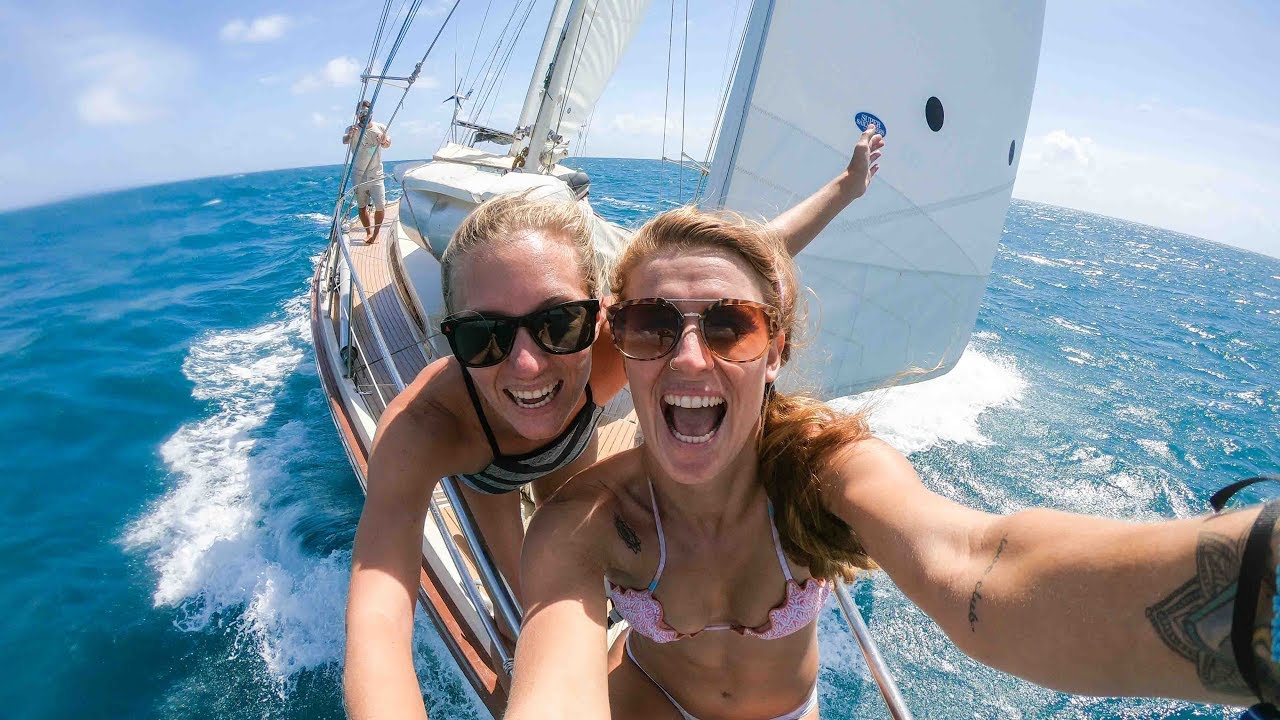
How to Sail Dinghies: Step-by-Step Beginner’s Handbook
Sailing is an exhilarating and captivating sport that allows individuals to harness the power of the wind and venture out into open waters . Amongst all types of sailboats, dinghies are particularly popular among beginners due to their smaller size, easy maneuverability, and versatility. Whether you are dreaming of cruising along tranquil lakes or racing against the wind, this step-by-step beginner’s handbook will equip you with the necessary skills and knowledge to embark on your sailing journey.
1. Choosing a Dinghy As a beginner, it is crucial to select a dinghy that suits your skill level and sailing ambitions. Opt for a stable design such as a Laser, Optimist, or RS Tera – these dinghies provide excellent stability while allowing room for growth as you become more experienced. Collaborate with expert sailors at your local yacht club or seek advice from seasoned sailors who can guide you in making the best choice.
2. Understanding Components Before venturing onto the water, let’s familiarize ourselves with the basic components of a dinghy. Start by acquainting yourself with terms like tiller (used for steering), mainsheet (controls sail position), halyard (raises sails), jib (front sail), boom (lower horizontal spar), and kicker (controls boom height). Knowing these names will greatly enhance your understanding when reading about techniques specific to each part .
3. Rigging Your Dinghy Rigging refers to installing and setting up various components before setting sail . Begin by hoisting the mast using the halyard until it stands vertically while ensuring all ropes are untangled and attachments secure . Next, attach sails properly, secured at both luff (leading edge) and leech (trailing edge) using suitable tension. Finally, connect control lines like mainsheet, kicker, jib sheets – keeping an eye on correct length and tension as you rig.
4. Getting Underway With your dinghy rigged and ready, it’s time to set sail ! Begin by launching the dinghy onto the water, either by sliding it off a ramp or gently easing it from a trailer. Once afloat, adjust the rudder and centerboard position to ensure stability. Steer clear of shallow waters, submerged objects, or excessive waves during this process. Bear in mind that gentle breezes are ideal for beginners to get accustomed to sailing techniques.
5. Basic Sailing Techniques To move forward, position yourself on the windward (upwind) side of the boat while holding onto the tiller extension with one hand. Slightly lean out over the water to balance weight distribution as you catch an appropriate angle to sail efficiently toward your desired destination. Maintain awareness of wind direction by feeling its effect on your face or by watching telltales attached to sails’ edges.
6. Tacking and Gybing Tacking and gybing refer to changing direction while sailing upwind and downwind , respectively. To tack (change direction toward the wind), bring the bow of your boat through the wind, ensuring smooth movements with trim adjustments on both sails once you cross over. Similarly, when gybing (changing direction away from the wind), ensure safe control of both boom and mainsheet while allowing maneuvering space for smooth transition .
7. Safety First! Sailing adventures must prioritize safety above all else – especially as a beginner! Always wear appropriate personal flotation devices (PFDs) that match local regulations and weather conditions; they can be lifesaving if unexpected incidents occur. Additionally, learn how to capsize safely and recover using techniques like righting lines or rescues by following reputable training programs available at yacht clubs or sailing schools.
8. Expanding Your Skills Once you become proficient with basic sailing maneuvers, challenge yourself by learning more advanced skills. Expand your knowledge about racing tactics, starting procedures, or even basic maintenance tips to keep your dinghy in top shape. Engage with fellow sailors and join sailing events or classes that can provide extensive learning opportunities, helping you progress from a beginner to an expert sailor!
Sailing provides an escape into the embrace of nature’s forces while cultivating valuable life skills such as self-confidence, problem-solving, and resilience. By following this step-by-step beginner’s handbook on how to sail dinghies, you’ll embark on a thrilling adventure that transcends the boundaries of land. So grab your lifejacket, adjust your sails, and immerse yourself in the enchanting world of dinghy sailing – where endless possibilities await!
Frequently Asked Questions about Sailing Dinghies: Everything You Need to Know
Introduction: Sailing dinghies are small , lightweight boats that are perfect for those seeking adventurous water experiences. Whether you’re a beginner or an experienced sailor, sailing dinghies offer a thrilling way to explore the open waters. However, as with any sport or hobby, it’s natural to have questions and seek information before diving in. In this blog post, we aim to answer some of the frequently asked questions about sailing dinghies and provide you with everything you need to know.
1. What is a sailing dinghy? A sailing dinghy is a small boat typically designed for one to four individuals. It features a single mast with a mainsail and often has additional sails like jibs or spinnakers. The compact size and maneuverability of dinghies make them excellent vessels for racing or recreational sailing purposes.
2. How do I choose the right sailing dinghy for me? Choosing the right sailing dinghy depends on various factors such as your skill level, intended use, budget, and personal preferences. Beginners usually opt for stable and forgiving boats like Optimists or Laser Picos, while experienced sailors may prefer high-performance boats such as 29ers or RS Fevas. Consider consulting with experts at a reputable boatyard who can guide you in selecting the most suitable option based on your needs.
3. Is it difficult to learn how to sail a dinghy? Learning how to sail a dinghy can be both challenging and rewarding. While basic skills can be acquired relatively quickly, mastering advanced techniques takes time and practice. Attending certified training courses with qualified instructors is recommended as they will teach you the fundamentals of sailing technique, safety procedures, wind dynamics, and capsize recovery methods.
4. Can I go solo on a sailing dinghy? Absolutely! Many people enjoy solo sailing as it provides tranquility and solitude on the water. However, venturing out alone requires additional precautions and expertise. It’s crucial to inform someone onshore about your plans, wear proper safety gear such as a life jacket, and ensure you’re confident in handling the boat single-handedly.
5. Are sailing dinghies safe? Sailing dinghies are generally considered safe; however, like any water activity, certain risks exist. Adhering to safety guidelines is essential for a secure sailing experience . Always check weather conditions before heading out, be mindful of other boats and potential obstacles, carry suitable safety equipment, and stay updated on maritime regulations specific to your location.
6. What should I wear when sailing a dinghy? Comfortable clothing that allows ease of movement is recommended while sailing dinghies. Dress according to the climate but be prepared for unexpected changes in weather conditions by layering your clothes. Wearing non-slip shoes is advisable along with a sun hat or cap and sunglasses to protect yourself from the sun’s glare.
7. How can I improve my racing skills in a sailing dinghy? Improving your racing skills requires dedication and practice. Join local sailing clubs or associations that organize races where you can compete against others and receive valuable feedback from experienced sailors. Additionally, studying resources like books or online tutorials on racing tactics can help you understand advanced techniques such as optimizing boat speed, utilizing wind shifts effectively, and strategic positioning during regattas.
Conclusion: Sailing dinghies offer an exhilarating world of adventure on the water for both beginners and seasoned sailors alike. By choosing the right boat for your skill level and preferences, acquiring proper training, adhering to safety guidelines, and continuously honing your skills through practice and competition, you’ll find yourself embracing all that this exciting sport has to offer. So grab a sailboat that suits you best and let the winds take you on unforgettable journeys!
Top Reasons Why Sailing Dinghies are Perfect for Adventure Enthusiasts
Do you have an insatiable appetite for adventure? If the answer is yes, then look no further than sailing dinghies – the ultimate vessel for thrill-seekers and explorers alike. Brimming with excitement, these compact and versatile boats are tailor-made to provide adrenaline junkies with an unforgettable experience on the open water . In this blog post, we will delve into the top reasons why sailing dinghies are perfect for adventure enthusiasts like yourself.
1. Portability: When it comes to exploring new horizons, convenience is key. Sailing dinghies offer unparalleled portability, making them a dream companion for any adventurer. Whether you’re embarking on a weekend getaway or planning a spontaneous trip to uncharted waters, their lightweight design allows for effortless transportation both on land and water. These vessels can be easily loaded onto trailers or car roofs, granting you the freedom to venture wherever your heart desires.
2. Versatility: Variety is indeed the spice of life, and sailing dinghies thrive in providing just that. Thanks to their compact size and versatile features, these boats can adapt to various conditions and environments with ease. From tranquil lakes to raging rivers or even coastal expeditions – nothing stands in your way! Seamlessly maneuverable, sailing dinghies deliver exceptional agility while cruising through tight spaces or navigating choppy waters – ensuring that every adventure unfolds without a hitch.
3. Freedom in simplicity: Adventure enthusiasts seek experiences that are pure and unadulterated – devoid of unnecessary complications. Sailing dinghies offer precisely that; their simplistic yet efficient design allows you to focus solely on what matters – embracing the thrill of exploration! With fewer components compared to larger vessels, maintaining, rigging up, and launching a sailing dinghy becomes hassle-free – giving you more time to uncover hidden treasures at sea.
4. Skill mastery: For those yearning to acquire new skills or refine existing ones, sailing dinghies make for the perfect tutor. As an adventure enthusiast, the journey itself is just as crucial as the destination, and mastering the art of sailing a dinghy enriches that journey tenfold. Whether you’re a novice taking your first steps in the world of sailing or an experienced sailor seeking a new challenge, these vessels provide ample opportunities to improve your seamanship skills through precise maneuvering and navigating ever-changing conditions.
5. Adrenaline rush: There’s nothing quite like the intoxicating rush of adrenaline when you surf on waves, harnessing the power of nature with every gust of wind. Sailing dinghies are specifically designed for thrill-seekers who crave that exhilarating sensation. With their lightweight construction and responsive handling, these boats allow you to push your limits and experience heart-pounding moments as you zip across water bodies at thrilling speeds – a symphony between man, vessel, and nature.
In conclusion, if you identify yourself as an adventure enthusiast in search of electrifying experiences on the high seas, look no further than sailing dinghies. Fuelled by their portability, versatility, simplicity, skill-building opportunities, and sheer adrenaline-pumping capabilities – these compact watercraft offer everything you need to embark on unforgettable voyages. Let sailing dinghies be your steadfast companion through uncharted territories as you brave wild waters and create memories that will last a lifetime!
Mastering the Art of Sailing Dinghies: Pro Tips and Techniques Revealed
Welcome to our blog where we delve into the exciting world of mastering the art of sailing dinghies. In this post, we will reveal some pro tips and techniques to help you become a skilled sailor in no time. So, hop on board and let’s set sail !
Sailing dinghies is a thrilling and challenging activity that requires a unique combination of skill, technique, and intuition. Whether you are a novice sailor or an experienced seafarer looking to enhance your skills, these pro tips will surely give you an edge.
1. Understanding the Basics: Before embarking on your sailing adventure, it’s important to grasp the fundamentals of sailing dinghies. Familiarize yourself with key terminology such as the tack, jibing, wind direction, and points of sail . This foundational knowledge forms the basis for any successful sailor.
2. Perfecting Your Balance: Maintaining balance on a dinghy is crucial to ensure stability and control over the vessel. Keep your weight evenly distributed while moving around the boat and use slight body movements to control its motion. Practice regularly so that balancing becomes second nature.
3. Harnessing the Wind: As any sailor knows, understanding wind direction is essential when maneuvering a dinghy efficiently . Watch out for telltale signs such as ripples on the water’s surface or observing flags nearby. Adjust your sails accordingly to maximize their effectiveness and propel your dinghy forward with precision.
4. Trimming Like a Pro: Properly trimming your sails can make all the difference in how your dinghy performs on the water. Experiment with different sail settings to find what works best in different wind conditions – too loose and you lose speed, too tight and you risk capsizing.
5.Mastering Tacking and Jibing: Tacking (turning into the wind) and jibing (turning away from the wind) are critical maneuvers that require finesse and precise timing. Practice these techniques to optimize your dinghy’s speed and maintain control while changing direction .
6. Utilizing Your Senses: Sailing is an art that relies not only on technical knowledge but also on the ability to sense and interpret the conditions around you. Sharpening your senses – observing changes in wind, water movement, and other boats – will help you anticipate potential challenges and make informed decisions.
7. Understanding Weight Distribution: In sailing dinghies, weight distribution can greatly impact performance. When going upwind, move forward in the boat to better slice through waves. Conversely, when heading downwind, shift your weight backward to keep the bow from digging into the water.
8. Learning from Others: Never underestimate the power of learning from more experienced sailors. Attend sailing workshops or join communities where you can interact with like-minded individuals who can share their wisdom and experiences with you.
9. Embracing Safety Measures: Safety should always be a top priority when sailing dinghies. Wear a personal flotation device (PFD), understand basic first aid procedures, and be mindful of weather conditions before setting out on the water.
10. Practicing Dedication and Perseverance: Last but not least, mastering the art of sailing dinghies requires dedication and perseverance. There may be moments of frustration or setbacks along the way, but don’t give up! With time and practice, you’ll become a skilled sailor capable of maneuvering any challenging situation.
So there you have it – our pro tips and techniques for mastering the art of sailing dinghies revealed! Remember to approach this exciting adventure with curiosity, a thirst for knowledge, and a dash of humor along the way because after all, sailing is meant to be exhilarating!
From Landlubber to Sailor: Embark on Your Sailing Journey with Dinghies
Are you tired of keeping your feet firmly planted on dry land? Have you ever imagined yourself gliding through the open waters, feeling the wind in your hair and the waves beneath your feet? Well, it’s time to turn those dreams into reality!
Embarking on a sailing journey can be an exhilarating and transformative experience . And what better way to immerse yourself in this world than by starting with dinghies? Don’t be fooled by their small size; these little boats are packed with big potential. So, put on your sea legs, grab hold of the tiller, and let’s dive into why dinghies are the perfect vessel for you to transition from a landlubber to a full-fledged sailor.
Firstly, let’s address the elephant in the harbor – why choose dinghies over larger sailboats ? Well, besides being cute and compact, dinghies offer numerous advantages that make them ideal for beginners. Their smaller size means they are easier to handle and maneuver compared to larger boats . This allows beginners like yourself to gain confidence and develop essential sailing skills without feeling overwhelmed.
One of the standout features of dinghies is their responsiveness. Unlike larger sailboats that may require an entire crew or complex systems, dinghies respond promptly to every adjustment you make. Just a slight tweak of the sails or adjustment of the rudder can result in immediate changes in speed and direction. This level of control not only allows you to fine-tune your sailing techniques but also provides an instant sense of accomplishment as you navigate across the water .
Another fantastic aspect of sailing dinghies is their versatility. Whether you prefer serene lake outings or exciting coastal adventures, there’s a dinghy suited for every type of environment. From lively racing models designed for adrenaline junkies to stable cruisers perfect for leisurely exploration, dinghies come in a wide range of types to match your preferences and skill level.
But wait, there’s more! Dinghies also offer the opportunity for endless learning and growth. As you become more comfortable on the water, you can experiment with different sailing techniques, try out various rigs, and even explore racing competitions if that tickles your fancy. The learning curve is never-ending but always rewarding, ensuring that every session aboard a dinghy brings new challenges and triumphs for you to conquer.
Now that we’ve established why dinghies are the go-to choice for aspiring sailors like yourself, it’s time to address the other vital aspect – developing your sailing skills. While embarking on this journey may seem daunting at first, fear not! There are numerous training programs available specifically tailored to beginners starting their adventure with dinghies .
These programs usually begin with thorough instruction on boat handling, rigging, basic maneuvers such as tacking and gybing, and essential safety procedures. Following this initial training period, you’ll have the chance to put theory into practice as you take control of your very own dinghy under the watchful eye of experienced instructors. Their guidance will ensure you navigate any obstacles smoothly while building confidence in your abilities.
The beauty of learning through hands-on experience is that by the end of these training programs, you won’t just be equipped with theoretical knowledge or basic sailing skills; rather, you’ll have developed a deeper understanding of wind patterns, currents, navigation principles – things that truly make one a skilled sailor.
So there you have it – from landlubber to sailor. By choosing to embark on your sailing journey with dinghies as your vessel of choice, you’re setting yourself up for an adventure filled with excitement, growth, and endless possibilities. So pack your sunscreen, don your sailor hat (optional), and get ready to set sail into a world brimming with freedom and wonder. Your journey awaits!
Recent Posts

- Sailboat Gear and Equipment
- Sailboat Lifestyle
- Sailboat Maintenance
- Sailboat Racing
- Sailboat Tips and Tricks
- Sailboat Types
- Sailing Adventures
- Sailing Destinations
- Sailing Safety
- Sailing Techniques
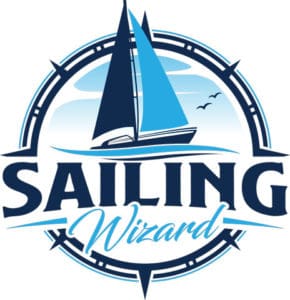
What is The Best Sailing Dinghy for Cruising?
Whether you are a seasoned sailor or completely new to sailing, choosing the right dinghy for your escapades is crucially important. If you begin to look at all of the available sailing dinghies on the market, you will likely be overwhelmed with all the options and unsure which one is truly the best. Let’s take an in-depth look and answer the question: What is the best sailing dinghy for cruising?
One of the best sailing dinghies for both beginners and experts alike, the Wayfarer is perfect for day cruising and multi-day adventures. Wayfarers are also versatile due to their streamlined and stable design. There are also other great options, including Gull and Enterprise dinghies.
In the next few sections, I’ll take a look at some of the most popular and best sailing dinghies so that you can get an idea of what is out there. Let’s get right into it!
Looking for a Sailing Dinghy for Cruising?
If you are looking to purchase a dinghy, there are a lot of options available to you. A few dinghies rise above the rest in terms of maneuverability, quality, design, functionality, and a thousand other factors; however, it is nearly impossible to pick out a single dinghy as the best due to the varying opinions and needs of individual people.
So, while there isn’t a single “best” dinghy that I can recommend to everyone, the ones listed below are absolutely amazing and will work for various crew sizes, needs, and situations.
Now, let’s take a closer look at these five great sailing dinghies and address each one’s pros and cons.
Wayfarer Sailing Dinghy
The Wayfarer is a widely loved dinghy that has quite a reputation as a good and reliable boat. There are many different versions of the Wayfarer, with slight adjustments and design changes throughout the years. While all of the Wayfarers are considered excellent boats, ones closer to the original Mark I design are ideal for sailing due to their extra storage capacity and added stability.
Pros of Cruising in a Wayfarer Sailing Dinghy
Wayfarers are overall great dinghies for a variety of situations and people. They are incredibly versatile, maneuverable, and very enjoyable to sail.
Whether you are entirely new to sailing and just looking into getting your first dinghy, or you have been around the block a few times, a Wayfarer is an excellent choice for many people. Due to its extreme versatility, you can take your Wayfarer out on both day trips and multi-day excursions, and they are even great racing dinghies as well!
Cons of Cruising in a Wayfarer Sailing Dinghy
When considering the cons of owning a Wayfarer, they are relatively few and far between. One thing to keep in mind is you will usually want a crew of at least two people to sail a Wayfarer. Unless you are very competent and know how to sail solo well, a Wayfarer will most likely be too large and heavy to sail and beach if you are alone.
It is also important to note that the newer versions of the Wayfarer are more prone to turtling while sailing than earlier models. If you are just getting into sailing, I would highly suggest that you get a Wayfarer similar to the Mark 1 designed by Ian Proctor.
Gull Sailing Dinghy
First designed by Ian Proctor in 1956, the Gull is a reliable and versatile dinghy that is well-loved by many people. The first iteration of the Gull was made of plywood, as most boats of the time were, and since then has gone through many more versions and is now made of GRP (Glass Reinforced Plastic).
Pros of Cruising in a Gull Sailing Dinghy
Much like the Wayfarer mentioned above, the Gull is a very versatile and excellent dinghy. While the Gull makes a fantastic sailing dinghy, it is a versatile craft that you can fit with an outboard engine or rowlocks for alternate propelling methods.
Another significant aspect of the Gull is its sleek and small design. While you lose some onboard space, the Gull’s smaller hull allows this two-person dinghy to be easily sailed solo if you have a little experience and wish to do so. Overall, the Gull is a very sturdy and reliable dinghy bound to meet all of most sailors’ needs.
Cons of Cruising in a Gull Sailing Dinghy
Gulls are very sturdy dinghies that don’t have too many downsides to them. The only real offputting aspect of the Gull for many sailors is its small size that sometimes doesn’t have as much room as you might like on a multi-day excursion on a dinghy.
The Gull has a pretty small hull, which gives it a lot of maneuverability, but it also results in less space for yourself, crew, passengers, and supplies. The lack of space on the Gull isn’t too big of an issue if you pack lightly, go on excursions that last a few days at a maximum, and have minimal people on board.
Enterprise Sailing Dinghy
Designed in 1956 by Jack Holt, the Enterprise is one of the oldest dinghy classes, yet remains wildly popular to this day due to its appealing design and beginner-friendly handling. Enterprise dinghies are extremely popular and versatile worldwide, being used for sailing, racing, and nearly everything in between.
Pros of Cruising in an Enterprise Sailing Dinghy
The Enterprise is seemingly the perfect blend of size, design, power, and weight. This near-perfect combination of elements has been the primary thing that has made this dinghy class have such a strong following and be so popular for many decades.
While it may take some adjustments and time, Enterprise dinghies are also relatively easy to sail singlehandedly, even though they are meant to be sailed two-up. Overall, Enterprise dinghies are excellent and reliable boats that are great for sailing adventures, whether you have a friend with you or not.
Cons of Cruising in an Enterprise Sailing Dinghy
Enterprise dinghies are considered one of the best options out of the vast array of sailing dinghies out there. However, there is one major thing that can be quite offputting to many sailors about them.
This one flaw of Enterprise dinghies is their stability.
While it isn’t too much for an experienced sailor to handle, Enterprise dinghies do have a noticeable lack of stability when out on the water when compared to similar sailboats. By no means is this a fatal flaw of the design, but rather a characteristic unfamiliar to this type of dingy and usually seen on dinghies meant for racing.
Wanderer Sailing Dinghy
Another design by Ian Proctor that has made this list, the Wanderer is a very light and agile dinghy that is quite popular among new and experienced sailors alike. The Wanderer began as a lighter version of the previously mentioned Wayfarer, but its design has diverged quite a bit and has become unique in its own right since then.
Pros of Cruising in an Wanderer Sailing Dinghy
One of the Wanderer’s greatest strengths is its weight. It is actually relatively light, with a hull weight of 291 pounds, making it pretty easy to launch and maneuver. Additionally, the Wanderer’s weight, or lack thereof, does not significantly impact its stability because it is quite a stable boat that is not prone to turtling.
Overall, the Wanderer is a top-rated and fabulous boat that, while on the lighter side of things, is very stable and reliable.
Cons of Cruising in an Wanderer Sailing Dinghy
While the Wanderer is a great boat for sailing, a potential downside to this dinghy is the need to have multiple crew onboard. While sailing a Wanderer can undoubtedly be done solo, for most sailors, having some extra hands on deck will make sailing the 2-3 person Wanderer dinghy much more pleasant.
Of course, there is absolutely nothing wrong with having a multi-person sailing dinghy – for many it’s the perfect choice – but it does eliminate the possibility of solo sailing, which can be quite relaxing and fun once you are competent and experienced.
James Gerard
Hi, I'm James! I started sailing at a very early age here in the UK, and have enjoyed so many opportunities to sail all over the world. I created this website to share the many sailing tips I've leaned over the years, so that you can also discover the joy of sailing with safety and confidence.
Recent Posts
How to Predict Wind Direction & Speed from a Surface Pressure Chart
Learning how to read a surface pressure chart will allow you to predict the wind speed and direction based on the weather chart. This will help you in planning your next sailing trip.
What Does a Black & Yellow Buoy Mean? (Cardinal Marks Explained)
If you see a black and yellow buoy while you're sailing, don't ignore it. Cardinal Marks are there to help you avoid hidden hazards in the water. This helpful article will help you to identify a...
Yachting World
- Digital Edition

Best sailing tender: get a buzz from your boat or boot
- Toby Hodges
- July 13, 2022
Want some easy, fun sailing this summer? launched from your yacht or car, the latest sailing tender ideas give that instant sailing buzz. Toby Hodges and Sam Fortescue report

While we all crave as much helming pleasure as possible from our cruising yachts, the reality is that after making realistic space, volume and budget compromises, they may not always be that exhilarating on the helm. But once you reach a destination or anchorage, what’s to stop you, your friends or kids getting your hands-on tiller-sailing fix if you can stow the right sailing tender aboard?
You could argue that the development of lightweight, modular or inflatable dinghies in recent years has solved a headache for some yacht owners – now they can go for extra volume, or switch to a multihull perhaps, safe in the knowledge they can get the spray-in-the-face dinghy experience from a tender or toy once anchored.
Stowage space, whether on deck, on davits or in a locker, governs what options are available. In the past the choice has fallen into three categories: a rowing dinghy you can sail, a nesting dinghy, or a sailing inflatable (such as the Tinker Tramp). And while these categories haven’t necessarily changed, the design and technology lately has made the products immeasurably more appealing!
The ability to stow a quick-to-rig toy in the boot or on the roof of the car, has also unlocked the potential to explore a multitude of different sailing waters easily. These designs have brought to sailing what inflatable paddleboards have brought to watersports.
Best sailing tender

For cruising sailors, this could be an ideal solution: a stable, lightweight tender that will sail well too
OC Sailing Tender
This has been at the top of my wishlist for tenders for some time, but now the family-run New Zealand company has come out with a rig for this lightweight composite boat that has just doubled the appeal.
OC Tenders was developed by experienced cruising sailors who were after a dry, stable, maintenance-free tender which is light enough to pull up a beach. A wide hull shape with plumb bow and flat run provides stability and volume and early planing ability, while foam sandwich construction makes it solid (puncture free) and light enough to carry. These also happen to be key elements for many modern performance sailing dinghy designs.
OC Tenders is unveiling a new Sailing Tender version this year, a kit which transforms two of its existing tenders into sailing dinghies. The main difference is a centreboard case which attaches to the thwart with a mast step below, neither of which can be removed, but only add 6kg weight. The rest of the sailing components are stored in bags which fit inside the tender, including a 6m mast in two sections, boom (both in 30% carbon), centreboard, rudder, hiking straps and 7.5m2 sail.
OC has a video of the tender surfing along and another of how easy it is to right it if you capsize. The boats weighs 68kg for the 3.3m or 74kg for the 3.5m, while the sailing components add just 15kg. Both are also available in carbon versions (a NZ$4,000 upgrade). The slight catch may be the cost, and that it’s a small company with low production run and high demand.
Price: OC330 from NZ$23,500 (circa £12,000).
Buy it now from octenders

Reverso Air is quick to get on the plane. Photo: Armand Dayde
Reverso Air
It may be a nesting dinghy, but there’s nothing clinker-built about the Reverso Air. From the outset, the team behind this pocket beast of a boat were focused on performance, and that is what you get in spades. It has been clocked at 16 knots and readily takes to the plane, surfing down anything from harbour chop to long swell.
Reverso is built in Brittany using advanced composite construction. The 3.40m hull is infused in honeycomb sandwich, for stiffness and light weight, and carbon reinforcing is added where the loads are greatest, such as the mast step. The mast itself is a tube of high-modulus carbon fibre weighing just under 3kg, and the sail is 7m2 of high-tech membrane from Incidence.
Part of the stellar performance comes from the hull shape, designed by Charles Bertrand. A broad beam, flat bottom and deep chines provide stability for sailing with kids and a great platform for planing when a gust blows. “It is the lightness of the boat which makes it fast and efficient, allowing it to accelerate quickly,” says founder Antoine Simon. “Also, the quality of the materials, which give a dynamic response and transmit the forces, especially with the rigid hull.”
The boat is designed to take two grown-ups or an adult and two kids, so you can refine your technique in company if you like. Simon says this makes the boat ideal for teaching kids or going out for a solo burn.
Assembly is pretty simple and can take less than two minutes. The hull is composed of four parts, the heaviest of which weighs 16.8kg. The sections clip together along the coaming using stainless-steel levers. Then you add tension along the bottom of the boat using two Dyneema lines with a 1:14 cascade that puts on 600kg of compression.
When disassembled, the parts nest inside each other, fitting readily into the boot of a family car or an SUV. Measuring 1.45m x 0.92m x 0.72m, the folded boat is also designed for easy fixing to a trailer or towing-ball platform behind a car.
Accessories that improve the storage and use of the boat include a bag, (€490); smaller padded bags for the four mast sections, centreboard, tiller and rudder; a mounting mat to protect the boat on rough surfaces (€170); and a folding beach trolley (€490). And there’s a GPS speedometer (€499), specially designed for mounting at the base of the mast.
Price: Reverso Air €8,913 plus €1,090 shipping.
Buy it now from Sailreverso

You don’t have to be a pro to get the AST Foiler skimming the waves. Photo: Sören Hese
Foiling is no longer limited to pros and daredevils. AST’s beautifully designed foiling dinghy makes it possible for almost anyone to experience the exhilaration of flying on water. With a top speed of 25 knots-plus and a really simple control system, it is easy to get airborne.
The key is the mechanical foiling system, which requires no trimming. A foil on each side of the 3.85m hull resembles nothing more than a giant spider’s leg, or a wonky ‘7’. The foils are loose-mounted in such a way that they can cant slightly according to the tack you’re on. When the boat goes about, the leeward foil rises and the new windward foil drops. It requires no electronics or hydraulics – just a bit of elementary physics.
You control the boat using a T-shaped rudder whose foil supports the boat aft and helps keep you balanced while foiling. With foils deployed, the effective beam jumps from 1.58m to 2.10m and the draught from 15cm to 1.10m, giving the boat excellent stability.
AST says the hull will fly from 8 knots of true wind, thanks in part to the lightweight layup, with an overall weight of 55kg. The foils, rudder and mast are all in carbon fibre, while the hull is in a lightweight foam-epoxy sandwich.
With a cool reverse bow, open transom and hiking wings, this boat looks the business. It can support up to 95kg of crew weight, so could in theory take two children. But this is really a solo sailer, designed for thrills and spills. AST offers two different sails, 7.5m2 or 9.5m2.
The foils can be folded flush to the hull for transport., there’s a custom-made aluminium trolley for launching and towing; padded covers for the foils and rudder (€269); and a Velocitek SpeedPuck to measure your speed (€399).
This is not a cheap option… but it is a fun one.
AST also does a non-foiling L12 Lowrider – a 3.82m planing performance dinghy, which weighs just 30kg.
Prices: AST Folier €15,631 inc VAT, L12 Lowrider €8,824 ex VAT.
Buy it now from Ast-yachts

IZIBoat is easy to transport and can be assembled in 15 minutes
IZIBoat germinated from a desire to make sailing easy, fun and accessible to all, by creating a catamaran that is ultra fast to assemble (less than 15 minutes). No tools are needed thanks to a neat plug, lock and tension system. While speeds of 14+ knots are reportedly achievable, it is more aimed at accessible sailing, regardless of age or ability. So it can seat four and is intuitive for new sailors thanks to joystick steering – just tilt the stick the way you want to turn.
The brainchild of François Tissier, who dreamed of a dinghy with ease and stability while living in the South Pacific, it took many years of R&D and 11 prototypes. The beach cat measures 500x62cm, so can easily be stored in a garage and its five components weigh 152kg, so it can be transported on the roof of a car or even towed by a bike or e-bike.
Price: from €8,990.
Buy it now from Iziboat

LiteboatXP 16 can be rowed or sailed – fast
LiteboatXP 16
This is a fun sailing boat that you can row properly for recreation too. The first Liteboat XP was a 20ft model which we tested four years ago and were so impressed with the sailing ability, we jointly gave it a European Yacht of the Year award. It’s also excellent for rowing enthusiasts. For those still sceptical, consider that it’s drawn by in-demand IMOCA designer Sam Manuard.
The new 5m/16ft model is more compact and lighter still (100kg). There’s no cuddy, but it still sports a sliding rowing seat, carbon oars and outriggers and a catboat-style rig with two part carbon mast and a 7.5m2 boom-less sail. But it’s when reaching with the 6m2 gennaker that you’ll really get the buzz. It converts from sailing to rowing mode in under a minute. It’s an efficient explorer that’s blast to sail, will keep you fit and avoids the need for a smelly, noisy outboard.
Price: from €14,500.
Buy it now from Liteboat
Best inflatable sailing tender

The black and yellow Tiwal rocket is designed in Brittany. Photo: Christiane le Port
The original Tiwal 3 is already marking its 10th anniversary, the design having been at the forefront of using drop stitch technology to create a really stiff inflatable. Now the boat has been turbo-charged, tweaked and improved. The result is the Tiwal 3R, with a top speed of 14 knots and a helming position just millimetres off the water.
It comes deflated in two bags weighing around 30kg each (plus a smaller sail bag), and comprises a concave inflatable hull and anodised aluminium ‘exoskeleton’, which transmits the forces from the mast, rudder and daggerboard. It also provides two raised hiking ‘wings’ which allow you to balance the 6m2 or 7m2 sail, tailor-made by North Sails in Xi V2 racing laminate.
The 3R’s performance boost stems from a number of small steps. For instance, the hiking bars have been extended aft so that you can shift weight back when the wind picks up. The aluminium frame is stronger and stiffer for better power transfer, and the hull is a more efficient shape, courtesy of the rail on the stern. The mast and boom are now 90% carbon for lighter weight.
Assembly takes 25 minutes – a little longer than the original Tiwals, because of the additional elements of the frame and control lines, according to founder Emmanuel Bertrand. Experience says there is a bit of fiddly slotting of aluminium tubes together, which can be trickier if sand gets into the joint. The boat is rated for crew up to 200kg, which allows for two adults or one grown-up and two children. Really, though, you want to be sailing this alone at top speed. And with a choice of two sails, you can go out in pretty much any conditions.
Price: from £8,140.
Buy it now from Tiwal
Dutch brand DinghyGo has built a reputation for the reliability of its growing range of sailing inflatables.
They are not performance oriented, but are easy to assemble, have bags of buoyancy and can be stored in two mid-sized bags. The range starts at 2.30m LOA, but the flagship Orca 375 is the latest release, with a 4.8m2 mainsail and a 1.1m2 jib.
The four-piece mast requires three soft stays to keep it aloft, while the foot is anchored through a thwart. With 650kg of payload capacity, you can bring three adults and a heap of camping gear with you.
Price: £4,000.
Buy it now from Dinghygo
Minicat Guppy
The Czech sailor behind the MiniCat brand teamed up with round-the-world sailor Laura Dekker to launch the Guppy.
At 3.00m LOA, it is the smallest boat in the Minicat range, with a capacity for two, but weighs a staggeringly small 26kg itself.
Perched on two big 33cm floats, just a small aluminium frame does the job of supporting the mast and the trampoline. The mast and its 3.9m2 sail is stayed to a short bowsprit, and the whole takes just 15 minutes to put together. Stub keel fins help reduce leeway.
Its light weight makes it eminently portable and easy to stow.
Price: €2,665 ex-VAT.
Buy it now from Minicatamaran
Inflatable Wingfoil
Granted, it can look a bit daft watching middle-aged folk pumping and flapping away while trying to get a giant inflatable wing to lift their mass onto a skinny foil. But once you’ve experienced that feeling of pure flight, silently skimming over the surface, there’s no going back.
Whether for surfing, windsurfing, or even kiting, any solid boards take up valuable locker space. All of which arguably makes an inflatable foil board and an inflatable wing the ultimate in compact sailing fun.
The foils typically disconnect from their masts and pack in protective bags. The inflatable boards can also be used to wingsurf or paddle on in displacement mode. Or try towing one behind a tender – with a foil you only need very small speeds (around 6 knots) and, with practice, you can be surfing a wee wake.
The smaller volume boards better suit surf and wingfoil use and the larger boards are for wing and SUP enthusiasts.
F-One’s Rocket Air is designed around its rigid boards, and range from 75lt (4ft 11in) to 185lt (7ft 11in) and prices from £625-£825.
Buy it now from f-one.world
Naish, meanwhile, has models of its new Hover board from 80-170lt, which have composite carbon plates on the bottom for the foil join for a stiff ride.
Buy it now from Naishfoils
If you enjoyed this….
Yachting World is the world’s leading magazine for bluewater cruisers and offshore sailors. Every month we have inspirational adventures and practical features to help you realise your sailing dreams. Build your knowledge with a subscription delivered to your door. See our latest offers and save at least 30% off the cover price.
- BOAT OF THE YEAR
- Newsletters
- Sailboat Reviews
- Boating Safety
- Sailing Totem
- Charter Resources
- Destinations
- Galley Recipes
- Living Aboard
- Sails and Rigging
- Maintenance

How to Choose an Inflatable Dinghy
- By Eleanor Merrill
- Updated: January 9, 2020
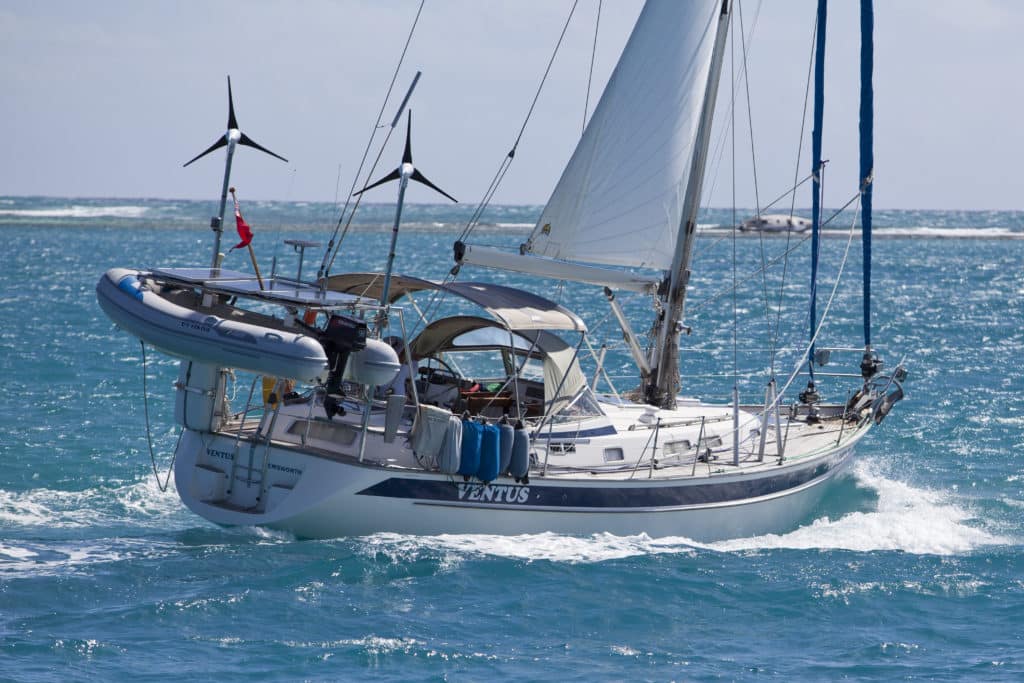
Shopping for a tender is a little like shopping for a car. The options are seemingly endless, and it’s not so much about finding one dinghy that checks every box as it is about finding a dinghy that best fits the type of cruising you plan to do. As Defender’s Stephen Lance puts it, “In my 30-plus years of designing, building, selling, repairing, buying, cutting up and examining inflatable boats, there is only one golden rule: There is no ‘perfect inflatable boat’ for the cruising sailor.” Lance notes that the product landscape is constantly changing, and buyers have to decide which trade-offs are most acceptable for their use.
Inflatable dinghies come in three overarching categories: those with rigid bottoms, those with air floors, and — a sort of hybrid between the two — dinghies with jointed or slatted bottoms. We’ll break down the strengths and weaknesses of each of these options.
Pros and Cons of Air-Floor Dinghies
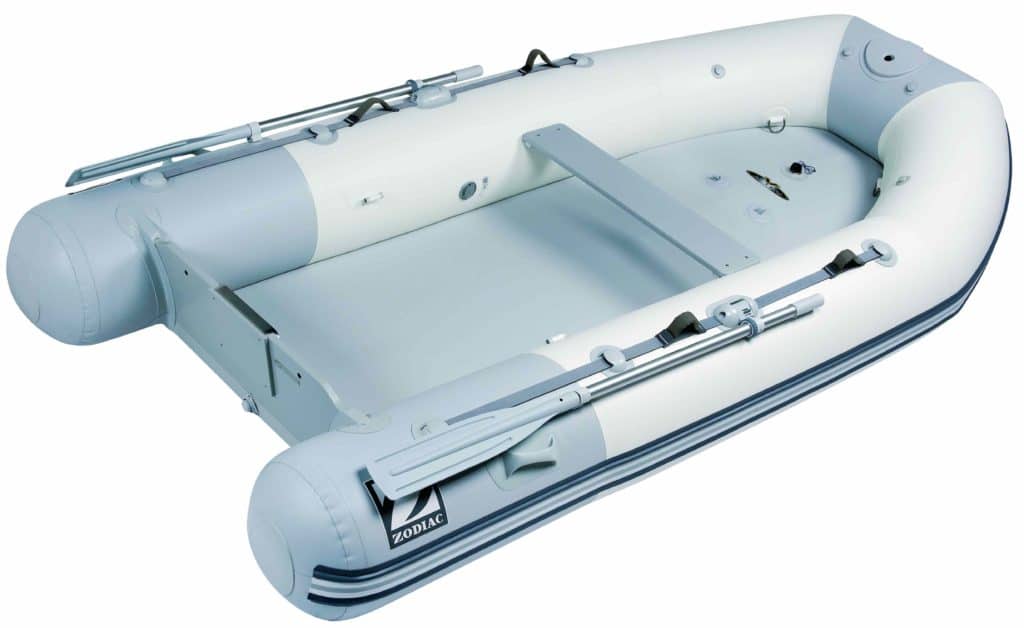
A dinghy with a high-pressure air floor is a good choice if you plan to roll it up and stow it regularly, and don’t have a lot of space to do it. It has a floor chamber that can be inflated with a hand pump with a pressure gauge (for those who want a 15-minute aerobic workout), or an electric pump that plugs into 12- or 110-volt power. Air-floor dinghies are among the lightest-weight options available, and can be much easier to assemble on board than fitting the slats into a wood floor.
In most models, an inflated keel tube that runs down the centerline helps give the hull a V shape for better tracking. Air-floor dinghies might be especially attractive to bluewater cruisers because they can be easily stored below, where they won’t create windage or be vulnerable to waves breaking over the deck.
It should be noted, though, that proper inflation is key, which might mean pumping in extra air on cool mornings and watching out for overinflation in hot weather. Air floors are not as durable as their solid counterparts, so they might not be the best choice if you plan to frequently haul heavy or sharp-cornered gear. A puncture in an air floor can be difficult to repair, so if you’re headed for remote anchorages, it’s not a bad idea to carry a replacement floor as a spare.
Roll-Up, Slatted and Paneled Floors
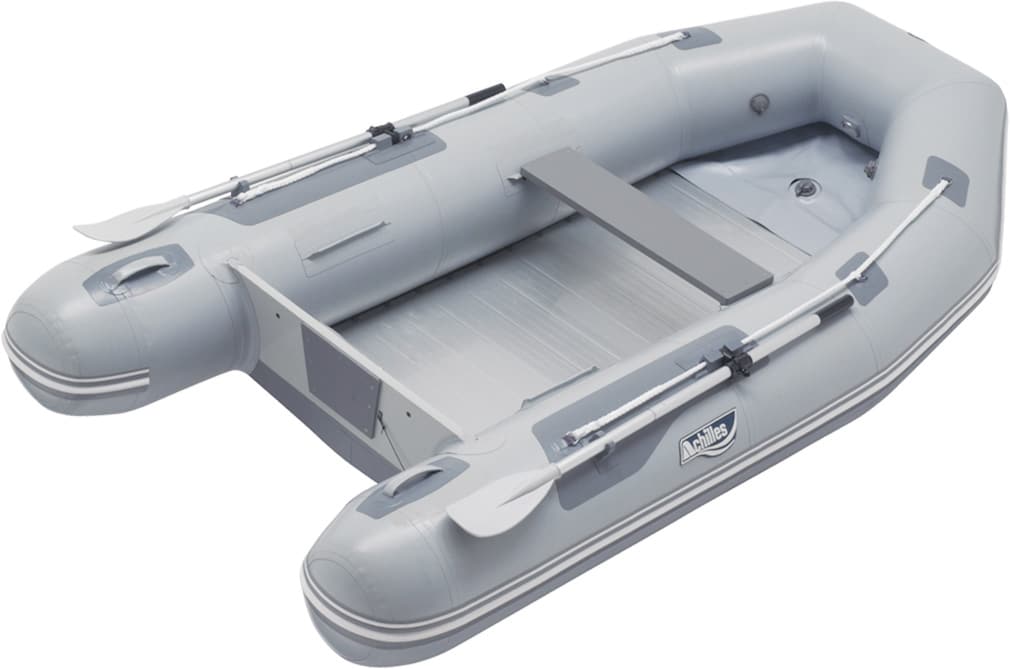
A compromise between an inflatable floor and a rigid, fiberglass bottom is one made of wood, aluminum or plastic slats that are either hinged to roll up or come apart in separate panels.
Dinghies with these floor styles are typically nonplaning, don’t tow or track particularly well, and have limited range, but they can fit the bill if you’re just putting around a mooring field. They can also be among the least-expensive inflatable dinghies. Jointed slats are more straightforward to rig and derig because you don’t remove the floor when rolling up the boat. Meanwhile, setting up a plywood-panel dinghy can be time- and labor-intensive, not to mention finicky, and a flat surface is recommended. For this reason, paneled floors are probably best-suited for cruisers who need only to stow and then relaunch their dinghy occasionally. Despite these challenges, former CW senior editor and Practical Sailor editor Darrell Nicholson notes, “The assembly hassles of a plywood floor are offset by having something very durable that I can fix anywhere myself.”
When to Choose a Rigid-Bottom Dinghy
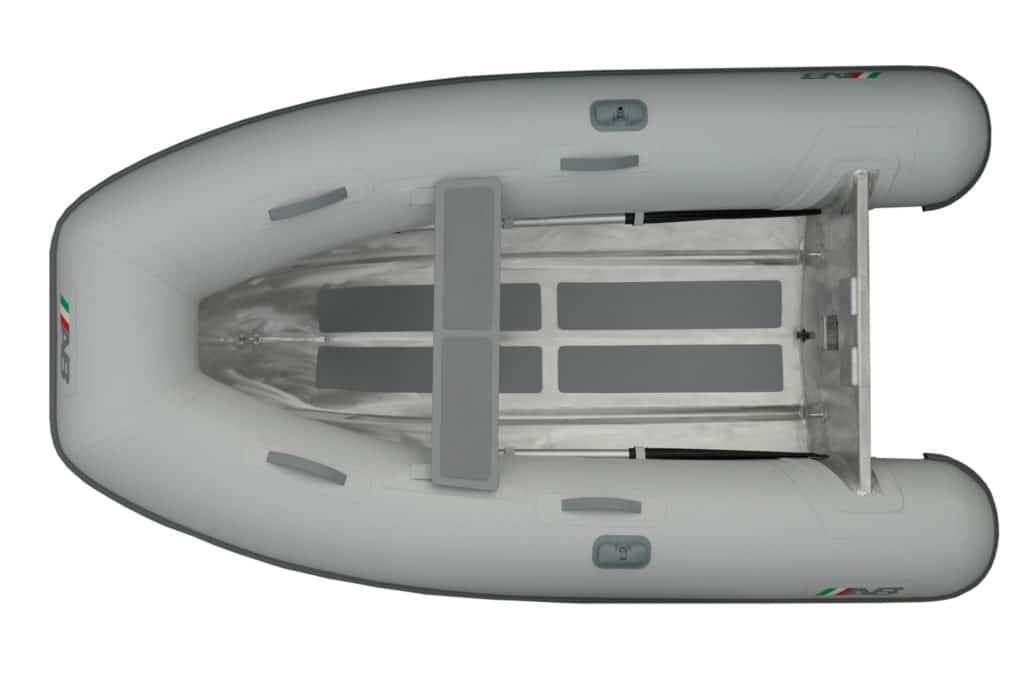
Hard-bottomed inflatables have higher carrying capacities and behave much better as boats, but they are heavier and more expensive than the alternatives. Stowing a rigid-bottomed inflatable can be a challenge because you’ll need davits or foredeck space to lash it down. Some RIBs have a hinged transom that, while less efficient with an outboard, allows the dinghy to lie almost flat when deflated.
When in use, a rigid bottom is likely to be more durable and better able to handle being pulled onto the beach than an inflated floor, and the extra weight and V-shaped hull help the dinghy track better when being towed. Within the RIB category, fiberglass bottoms are the most common, making dinghies durable but heavy. Aluminum bottoms are much lighter but more expensive and susceptible to corrosion.
RIBs can be made with a single or double floor. A single-floor RIB weighs and costs less, but the floor follows the V shape of the hull, making it a bit less stable underfoot. A double-floor RIB has a flat deck, which makes it a more stable and comfortable platform. The watertight air chamber between the deck and hull also provides some extra buoyancy, and as an added bonus, many double-floor RIBs have a locker in the bow to store an anchor or other gear.
Of all the inflatable dinghies, double-floor RIBs have the least overall flex, making them the most efficient design. They can be paired with a more powerful outboard and are an ideal choice if you plan to use your dinghy for adventures farther afield.
Notable Features of Inflatable Dinghies
Polyvinyl chloride (PVC) and chlorosulfonated polyethylene synthetic rubber (commonly known as CSM, or its trademark name, Hypalon) are the two most widely available fabrics for a dinghy’s inflatable pontoons. PVC seams are thermomolded, an automated process that creates a bond that is stronger than the fabric itself. Hypalon seams, on the other hand, must be hand-glued, which is part of the reason why Hypalon inflatables are more expensive than those made of PVC.
West Marine’s Tim Mize notes: “Hypalon is more resistant to damage from UV rays, so if you’re planning to cruise the tropics, it’s the fabric of choice. New England sailors, on the other hand, can save a little money with PVC.”
No matter what fabric you choose, protecting the pontoons with a spray-and-wipe UV protectant or a set of canvas covers (see “Making Dinghy Chaps,” March 2017 ) can help block the sun’s damaging rays, extending the dinghy’s life. That said, Nic Stark of Annapolis Inflatables points out, “The best first step toward a long life is keeping the boat and tube clean; dirt, salt and sun do the most damage.” Stark adds that covering the boat when not in use also helps.
If you’ll be cruising locations with rough conditions and/or prefer a drier ride, look for tubes with larger diameters. Other features to seek out are handholds placed within easy reach of both driver and passengers, as well as substantial rubbing strakes to protect the pontoons from barnacle-encrusted dock pilings.
Oar design and storage should also be considered; oars low inside the boat are much less likely to go flying than those mounted on top of the tubes. Look hard at where the fuel tank for the outboard will go, and make sure there’s a way to secure it underway.
Good towing-bridle attachment points are critical — if you plan to tow your dinghy. Likewise, if you’re going to hoist it on davits or a halyard, strong D-rings or welded loops will be necessary.
A dink backed by an extended warranty and wide dealer network will cost a bit more, but the ability to find spare parts, make repairs and have it serviced in your intended cruising area is likely a worthwhile trade-off. Read the fine print on your warranty because some can be voided by DIY repairs.
Choosing and Outboard for Your Dinghy
The outboard you choose will depend on how much exploring you want to do, how many people you typically carry, how much gear you’ll need to tote around and, of course, the maximum rating for the dinghy itself.
If you need only to get to shore and back from the mooring and getting on plane is no concern, a 3- to 5-horsepower motor might do the trick. If you’d like to use the inflatable for bigger adventures — or to haul more provisions, gear and fuel — a rigid dinghy with a more powerful outboard will make more sense for you.
On matching the right outboard to your dinghy, CW Boat of the Year judge Ed Sherman notes, “There’s an important difference between the teeth-rattling maximum-horsepower rating stamped on the transom and the more-reasonable horsepower size that the manufacturers usually recommend.” Check the thickness of the dinghy’s transom to make sure your outboard will attach properly.
When it comes down to it, there is no one tender that does it all. The one you choose will depend on the type of cruising you have planned and what kind of space is available for storage. If you plan to tow your dinghy while sailing short, coastal hops, and have plenty of foredeck space or davits, a rigid-bottomed inflatable can’t be beat. But if you’re doing serious offshore passages and/or are on a smaller boat, a stowable tender will be a better fit.
Eleanor Merrill is CW’s managing editor.
- More: boats , dinghy , How To , inflatable
- More How To
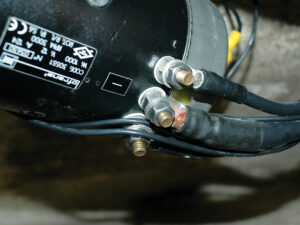
How to Keep Your Windlass Working For You
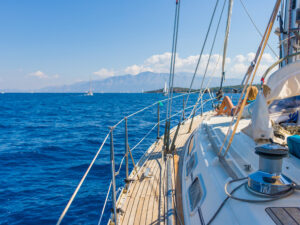
Southern Comfort: Tactical Tips for Sailing South
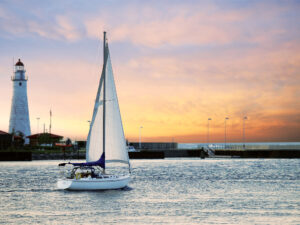
Preparing to Head Out
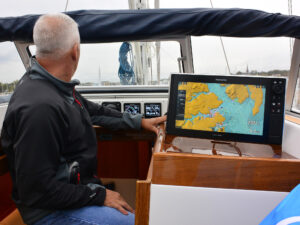
Adding Onboard Electronics? Here’s How To Get Started
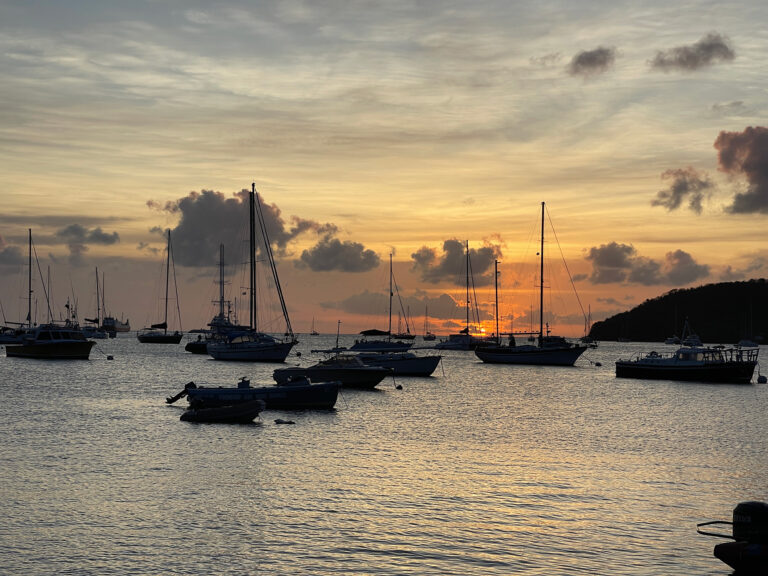
Why Boaters Love Bequia
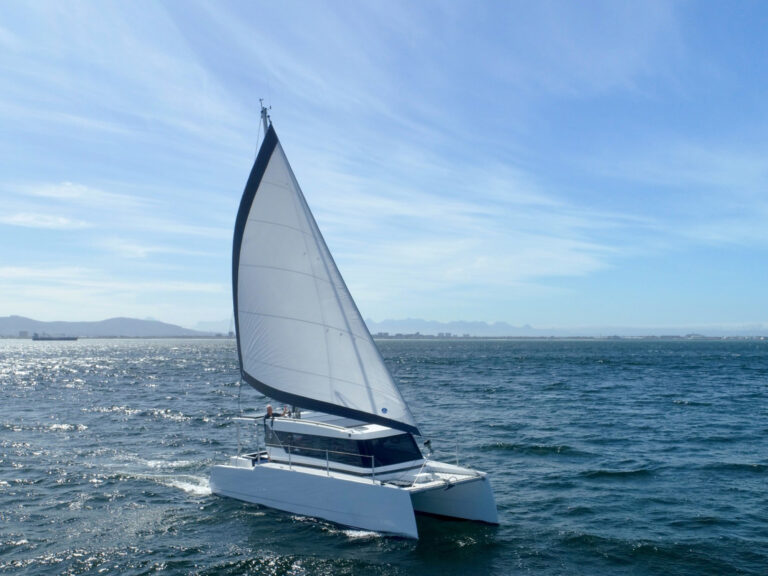
Meet the HopYacht 30
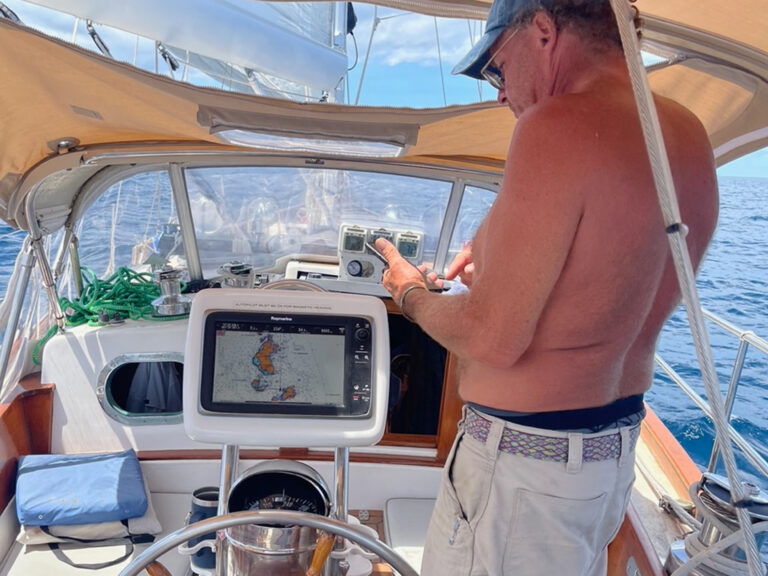
Connected in the Caribbean: Learning Lessons Underway
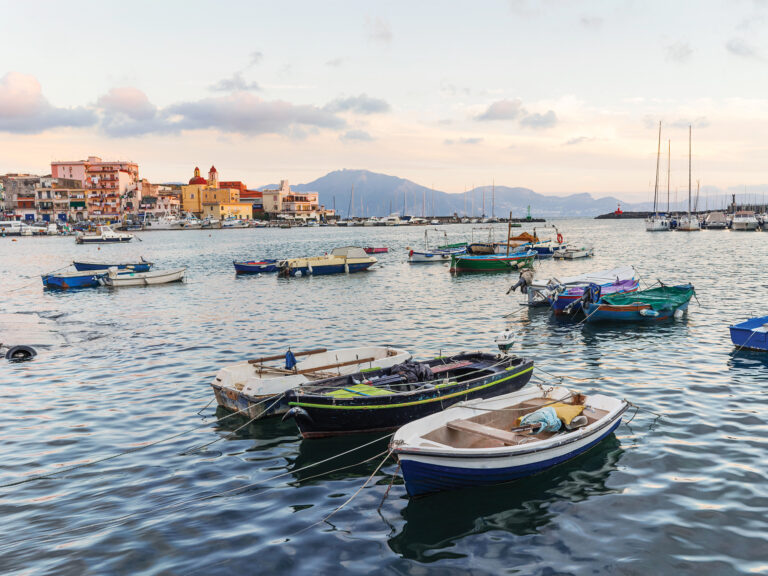
Cruising Italy: A Journey Into Time
- Digital Edition
- Customer Service
- Privacy Policy
- Email Newsletters
- Cruising World
- Sailing World
- Salt Water Sportsman
- Sport Fishing
- Wakeboarding

My Cruiser Life Magazine
Choosing the Best Dinghy for Your Boat
It is often said that a boater’s dinghy is like their car. When traveling between ports, you will often only have a land vehicle if you rent one. But your dinghy comes with you, and it’s an essential link to shore. Unless you dock your boat every night, your dinghy gives you the ability to go out to dinner, go to the store, or find a secluded beach to call your own.
Dinghy boats come in an assortment of shapes and sizes. So how do you choose between a hard dinghy that rows well or a fast dinghy with motor? Let’s look at the options and see if we can’t find the best dinghy for your and your crew.
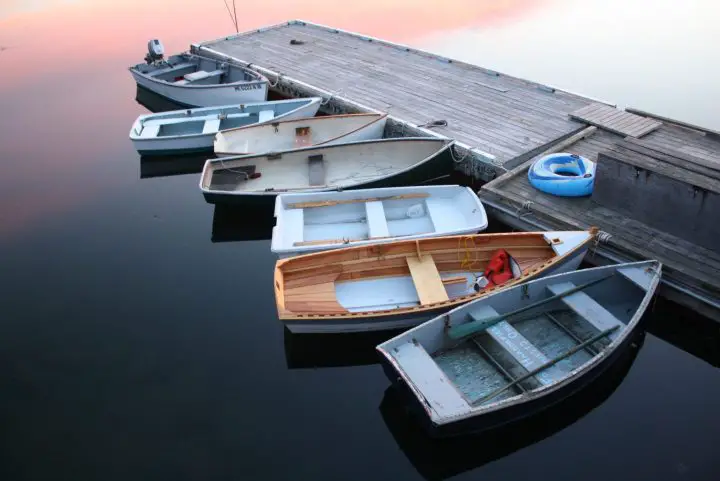
Table of Contents
Sailing dinghy, dinghies as tenders, dingy dinghies – what is a dingy, what are some uses for a dinghy, basic types of boat dinghy, lifting ability and storage when underway, hard dinghies, inflatable dinghy boat options, what’s the best dinghy for your cruising boat, dinghy boat faqs, what is a dinghy.
A dinghy is a small boat. But there are two primary dinghy meaning uses that you should be aware of.
- Sailing dinghies
- Dinghy boats as yacht tenders
Firstly, a dinghy is a small sailboat usually used for racing. So you might hear about “dinghy races” or “dinghy sailors.” These are the sorts of little boats that kids would learn to sail, but they’re also raced in the Summer Olympics.
Optics are the classic sailing dinghy. Its purpose is to sail and have fun. They usually carry one or two people and nothing else.
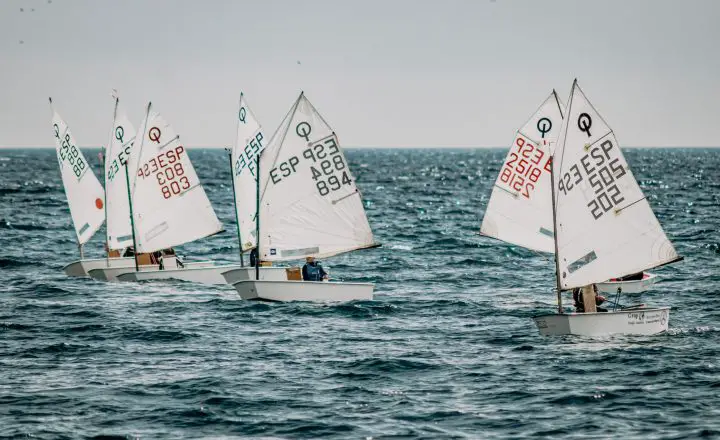
Secondly, a dinghy serves as a tender to a larger boat. In cruising and living aboard, this is the most commonly used definition. Your dinghy is like your car. Your boat is like your house or RV, and you park it somewhere comfortable. Maybe a scenic, quiet, and protected anchorage. Then you hop in the dinghy to explore the area or go into town for supplies.
A dinghy allows you not to have to pull up to a dock. Anchoring is usually free, and mooring fields are cheaper than taking a slip. Plus, living “on the hook” is more fun–there are fresh breezes, and your neighbors aren’t right next to you. You have more privacy and your own little slice of the ocean.
But to live like this, a good dinghy is important. It has to be safe in most conditions and be able to haul you and your gear. In addition, it should be able to handle the occasional provisioning run–meaning it needs room for lots of groceries.
Many cruisers affectionate call their dinghy “the dink” or some other fun name. In the US, a motorized dinghy will need to be state-registered.
Fun fact–RV owners who tow small cars refer to them as “dinghies.” They are cheaper to operate and easier to maneuver once they get where they’re going, so they’re used in the same way that boaters use dinghy boats.
Dinghies as tenders come in many forms.
- Kayaks or canoes
- Hard boats with small motors
- Inflatable boats that row
- RIB (Rigid Inflatable Boats) with motors — these can be slow or very fast
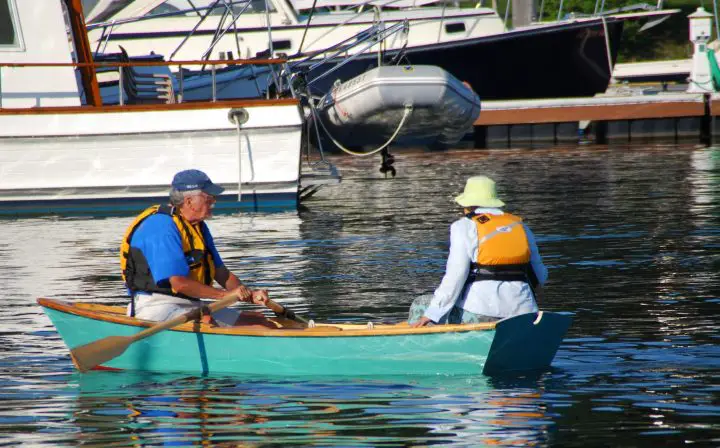
Dingy (adjective) – dirty, unclean, shabby, or squalid Dinghy (noun) – a small boat carried on or towed behind a larger boat as a tender or lifeboat… Definitions from Marriam-Webster Dictonary
So if your dinghy is a dingy boat, you should invest in some good boat soap and clean it.
Related reading: What Is the Main Function of a Boat Trailer’s Safety Chains?
Why is a Dinghy Important?
The dinghy is your primary method for getting ashore for cruisers traveling far from home or for liveaboards who aren’t tied to a dock. Having a good dinghy means you don’t have to get a dock every night. It means you can anchor in quiet coves in between towns. If you have a dog, it means they can get to shore morning and night for “shore leave.” And if you want to explore shallow creeks or go fishing, it’ll do that too.
The importance of a dinghy depends entirely on your cruising style. Some people don’t want to anchor–they’ll be at a dock every night no matter what. Those rare evenings between destinations when they do anchor for an evening, they don’t go ashore. A dinghy isn’t very important for them and won’t get used much.
On the other hand, some people live via their dinghy. The big boat gets them between destinations, but the dinghy is their “daily driver.”
The easiest way to explain how cruisers use their dinghy is by example. So here is a look at how boaters visiting the Bahamas usually use their dinghies.
You find a cozy island where you want to hang out and drop the hook in a protected cove. Then, you launch your dinghy and go to town, find secluded beaches, or just go exploring. Maybe you’ll want to find some coral reefs for fishing or snorkeling or see the tiny islets and rocks that protect the anchorage. Some islands have hiking trails or miles and miles of beaches.
Marinas are few and far between the islands, and the best and quietest spots are far from them. Most towns don’t have big docks–just small dinghy docks where you can tie up for free and walk to the store. In the Abacos, several of the most popular towns have harbors full of mooring balls and several small dinghy docks that make it easy to visit the town.
In these instances, everything you need for your boat will get there by way of the dinghy. You’ll take your trash to shore in the morning and bring home groceries. You might also take your propane tanks in for a refill or get some jerry cans filled with freshwater or diesel.
Finding the Right Dinghy For Your Boat
With so many choices, finding the dinghy for you can be a daunting task. Make it easier by learning about your choices, understanding how you will use it and what you will carry, and planning for where you will keep it on your boat.
Dinghies come in as many different designs as big boats do. You can pick between hard, inflatable, or RIB for the hull. A RIB (rigid inflatable boat) has a hard hull surrounded by inflatable tubes – so it’s kind of a hybrid.
For locomotion, you can have oars, a sail, a motor, or any combination of those. Motors used on dinghies are usually small and portable, although go-fast RIBs can have larger 15 to 25 horsepower motors installed.
It should also be noted here that dinghies are relative to the size of the “mothership.” For a 100-plus-foot motor yacht, the dinghy might be a 40-foot center console with triple 300 horsepower engines. So in dollars, their “dinghy tender” might cost quadruple what the rest of us spent on our “big boats.”
Dinghies should be suited to their purpose. For example, cruise ship dinghies ferry passengers to and from shore at destinations without cruise terminals. They’re passenger ferries and hold 30 or 50 passengers for the journey. For cruisers, a suitable dinghy usually means something that will get them to shore and back–the distance will vary. It must carry two to four people and a week’s worth of groceries.
Your choice of dinghy depends radically on the boat that will be carrying it. How will you deal with your dinghy when you’re underway? If it’s an inflatable that can roll up and store in a locker, life is easy.
But what if you want a hard dinghy or a RIB? Below are the most common options for lifting a bigger boat aboard. No matter how you get your dinghy aboard, once it’s on deck it must be lashed upside down to ensure it remains secure even in heavy seas.
Towing is often done but never recommended. Towing a dinghy limits the maneuverability of your big boat, making docking in tight spaces tricky. Plus, it opens up your dinghy to a world of possible disasters, including coming loose and being lost, or flooding and capsizing due to high winds or waves (or other boater’s wakes). Keeping your dinghy in the water also means more maintenance since you’ll have to scrape its bottom regularly. Most dinghies do not have bilge pumps, so bailing after every rainstorm will become a thing.
Underway, the load on the tow lines is high, and if you must tow, make sure to do so with a proper towing harness and bridle. Also, always remove your outboard before towing–it’s safer on the big boat.
If there is one advantage of towing, it is that your dinghy will be ready to go–it is already launched when you get where you’re going.
Also, note that a towed dinghy makes an easy target for theft in the anchorage–an important consideration in some parts of the world. It’s an easy thing for a thief to come along and cut the line while you sleep. The dinghy will drift away silently, and you won’t be any the wiser until morning.

Many cruising boats install davits on the transom. These provide lifting points that hoist the dinghy out of the water. Davits are an excellent upgrade because they allow you to keep the dinghy out of the water while traveling and hoist it up every night. Your dinghy will be cleaner, and you can take the plug out to let rainwater drain out. It’s safer too since you can easily lock it to the boat for long-term storage.
As handy as davits are, they can also be a pain. Getting the lifting harness and equipment just right can be a hassle. Dinghies on davits are prone to swinging in wind and waves, which can quickly chafe lines or even an inflatable’s PVC or Hypalon. If the dinghy is heavy or has a large outboard, the swinging can quickly get out of control to the point that it will damage the davits. Strap your dinghy down so that it doesn’t move at all, even when you’re in quiet anchorages. You never know when a ferry boat will throw a big wake your way!
Finally, the location of davits on the stern is less than ideal. Most boats don’t balance well with too much weight that far aft. Furthermore, should you take a wave over the stern during an overly boisterous passage, you can probably kiss your dinghy–and maybe even your davits–goodbye. Most salty sailors store their boats on the foredeck when at sea, even if they do have davits.
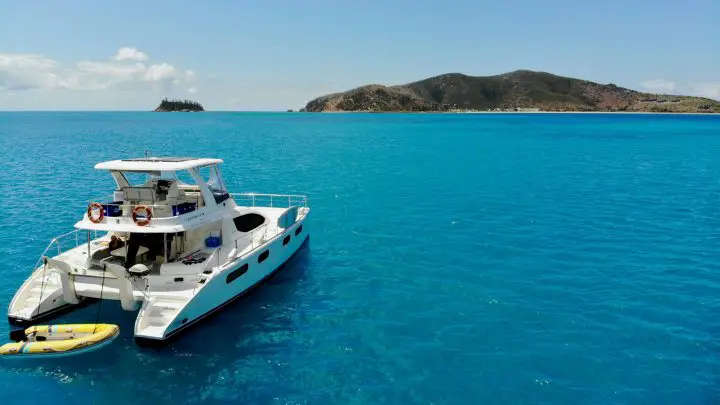
Foredeck or Rooftop Hoists
Powerboats usually have motorized hoists that lift their dinghies onto the high deck. Traditional trawlers can use their mini mast and block and tackle to do the same job. Sailboats use their mast and rigging to hoist a dinghy onto the deck. This can be a good way to get inflatables up to deflate them for storage, or to move a hard boat into position to be strapped down.
Once aboard, the dinghy can be sat on the deck in cradles or flipped over and sat upside down. How it stores will depend entirely on your boat and how much space you have–and where you have it.
Hard dinghies have rigid hulls, just like regular boats. Many are made of fiberglass, but there are also molded plastic ones. There are also a handful of classic or homebuilt wood dinghies out there.
Hard dinghies come in all sorts of sizes and shapes. Some are beautifully designed by the world’s best yacht designers, like Lyle Hess’s Fatty Knees. Others are functional, floating, plastic bathtubs, like the Walkers Bay 8.
Rowing Dinghy
Rowing dinghies are paddled with oars and a center-mounted seat. This limits the space on the boat considerably. The rower sits facing aft, which is awkward to maneuver the boat from but provides lots of power into each stroke.
Nearly all dinghies are made to be paddled, to some extent. But if rowing is a big part of your plan, you need to research carefully. Many dinghies row poorly. Flat and wide boats are difficult to control and hard to get to track straight in any wind or chop.
On the other hand, proper rowing dinghies are a pleasure. Look for classic designs that have a dominant keel line and soft chines.
Some cruisers and solo sailers use plastic kayaks as rowing dinghies. So long as it holds enough supplies and gets you where you need to go, it’s a great idea. Best of all, kayaks are much easier to maneuver in strong winds than rowboats, and faster too. In the world of dinghies, a kayak is like riding a bicycle.
Some cruisers want to know about the functionality of using standup paddleboards (SUPs) as a solo sailor’s dinghy. The truth is, SUPs make terrible dinghies. They have no gear carrying capacity, and they are impossible to lock up once you get to the dinghy dock. To make matters worse, they’re difficult–if not impossible–to paddle into strong winds or choppy conditions.
Sailboat Dinghy
Adding the ability to sail your dinghy moves it from the tool category into the toy category. We all like to have water toys, and if you can practically turn your dinghy car into a water toy, too, that’s pretty cool.
But, sailing a dinghy comes with an entirely new set of problems. It will need a sail rig, a keel of some sort, and a rudder to sail well. This will not work on any dinghy–it will need to have been designed from the get-go to sail.
Nice dinghies don’t come cheap, and adding a sail kit usually makes it substantially more expensive. But for purists who love the freedom and peace of real sailing, there are not many things that are more fun than skirting around the harbor silently in your sailing dinghy.
View this post on Instagram A post shared by SAILING • AVOCET ⛵️ (@svavocet)
Hard Dinghy with Motor
You can add a motor to most dinghy designs as long as you follow the manufacturer’s guidelines and do not overpower or overload it. Engines are heavy, and adding all of that weight to a tiny boat’s transom can quickly cause trouble.
Hard dinghies that are a suitable size for cruising boats seldom plane. A planing dinghy goes fast–so you can expect that most dinghies in the 8 to 12-foot range are going to be slow. The exception to this is the RIB–a hybrid hard-inflatable dinghy. For more details on RIBs, see below.
What’s left is the fiberglass or plastic dinghies that can’t get on plane–they have displacement hulls. They are usually rated for between two and five horsepower. Adding more horsepower does not necessarily make the dinghy go faster. The engines can be gas, propane, or electric.
Once you get into slightly larger boats, in the 15 to 18-foot range, there are a few that will get on plane. But these boats are so large and heavy that you cannot lift them on most cruising boats. For example, Boston Whaler has made a series of tenders and small tenders, like their 130 Super Sport . But, with an engine and fuel, this little boat weighs over 1,000 pounds.
Pros and Cons of Rigid Hard Dinghies
- Indestructible–much more robust than inflatable options
- Can be very good looking
- Always ready to go
- Options for rowing or sailing
- Tippy–much less stable than inflatable boats
- No way to store in a small space–can’t roll up or deflate
- Low weight carrying capacity
- Generally limited to low-horsepower motors
- Cannot plane (go fast)
- Can be very heavy and bulky
Best Hard Dinghy Brands
West marine dinghy.
West Marine sells a few models of rigid dinghy. They are made of molded plastic, extremely tough, and can be oared or powered by a small outboard. Unfortunately, none of the West Marine models come with a sail kit.
The West Marine Classic Dinghy is similar to a popular model known as the Walkers Bay 8. These can often be found on the used market and have many great options. They have a sail kit and a tube kit that converts them almost into a RIB.
Porta-Boat makes a unique, folding, rigid boat design. The boat panels fold together into a flat case that looks a little like a surfboard. You can unfold the Porta-Boat on your foredeck and launch it. When lightly loaded and given a big enough outboard, Porta-Boats are fast enough to plane–a rare find in rigid dinghies.
Portland Pudgy
The unique looks of the plastic Portland Pudgy betray its biggest plus–it is designed to serve as a lifeboat. For a cruiser outfitting their boat for crossing oceans, liferafts are expensive and take up a lot of space. So having a dinghy that could potentially serve that purpose could save you several thousand dollars–plus the liferaft packing service cost every one to three years.
The Pudgy is a cute dinghy, virtually indestructible, and equipped however you like. It’s made of roto molded polyethylene, just like a plastic kayak. You can row it, motor it, or sail it. The survival kit adds liferaft supplies and a canopy for emergencies. Best of all, the various pieces fit inside compartments built in the hull.
Fatty Knees, Trinka, Sam Morse Cherub, etc.
There are a handful of really classy classic dinghies out there, but you have to do a little research to find them. Usually, they result from a professional yacht designer answering a cruiser’s problem. For example, when Lin and Larry Pardey were sailing around the world on their Lyle Hess-designed Serafynn, Hess designed them a dinghy that fit perfectly on their boat. That little dinghy eventually became the well-loved Fatty Knees.
Dinghies of this class look great, and they usually row and sail beautifully. Most will accept a tiny outboard for power. None will get on plane, and space and hauling capacity are not as much as with a RIB. Some of these dinghies are still made, while others are rare finds on the used market.
Chesapeake Light Craft CLC Kits
The selection of small rigid boats that make good tenders is surprisingly limited. If you’re a hand person, you might consider building one from a plywood kit. Several suppliers of such kits, but Chesapeake Light Craft in Annapolis is the biggest. Their boats range from tiny rowing prams to motor and sailing yachts.
This type of boat building is known as stitch and glue. Panels of marine-grade plywood are stitched together and then glued together with epoxy. The result is a robust design that is lightweight and can last decades with proper care.
A nesting dinghy is one particularly interesting design that you can make from plywood. These are built in two or three sections, each stacking neatly in the other. So on your deck, the dinghy is small–only five or six feet long. However, when assembled, they can be 12 or more feet long.
Inflatable boats also come in a variety of types. The only universal feature is the inflatable tubes surrounding the boat, but the interiors and floors vary. Besides the cost of the boat, the deciding factor usually comes down to storage space and setup.
Roll-up floors are made of the same rubber as the hull but with wood slats that make it sturdier. Some are entirely flat and made of plywood or aluminum panels–these are generally called solid-floor boats. Next, there are inflatable floor boats with a high-pressure floor that you can stand on, like a paddleboard. And finally, RIBs have fiberglass or aluminum hulls surrounded by the inflatable tube.
Inflatables are probably the most popular dinghy option because they are easy to come by and easy to store. Once inflated and on the water, they are very stable and difficult to capsize. In addition, they hold an insane amount of weight, so you never have to worry about overloading it with your groceries or supplies.
Inflatables are sold with oars for rowing, but they make terrible rowboats. They blow around on the water and are difficult to control. With no keel, they don’t track and make terrible leeway in wind or chop. Some do have an inflatable keel, which gives the hull and little shape and greatly improves handling.
RIBs are easier to paddle since they have a keel and do track better.
Most inflatable or RIB owners will opt for engine power eventually, even if they like rowing. Inflatables can be quite fast, and some are designed to get on plane. In my personal experience, you need a minimum of 8 horsepower to plane a RIB, although 9.9-horsepower motors are even better. If you carry more than two people aboard or have a lot of gear, consider a 15-horsepower engine as the minimum.

Rigid Inflatable Boats
Making hybrids tends to not work out very well with many things in life. The results often take on all the disadvantages of each thing and few of the advantages. But with rigid inflatable boats, this isn’t the case. Luckily, these boats really are the best of both worlds.
The advantages are that RIBs are lightweight yet supremely stable for their size. Large inflatable tubes all around the hull provide a dry ride and are very difficult to capsize. They can be loaded for bear and carry lots of people and supplies.
The hard bottom of the boat gives it a solid keel and good handling characteristics on the water. If you want to get on plane, a RIB is your best bet. All you have to do is buy one that will safely handle a large enough outboard motor.
The complexity of a RIB’s design is proportional to its cost. The simplest boats are small, with a single floor. In other words, the floor you stand on is also the outer hull. It slopes down to the keel, making it harder to stand on than a flat floor. They have no built-in storage options. They’ll have seating on the outer tubes or a simple bench seat.
One step up is the double-floor RIB. These have a flat floor attached to the hull, so there is space below. These boats usually have some storage under the floor, near the bow. They’re easier to stand in, but they are also much heavier and more expensive.
Larger RIBs may have built-in seats and possibly a wheel-style helm. This looks comfortable, but it takes up a lot of space and weight that might be handier for extra people or more groceries.
The first rule is that if you have the space and budget for a RIB, you should get the RIB. You might be able to fit an air floor roll-up boat, but you’ll never like it as much. Some of them are very nice–but they aren’t RIBs, and they never will be.
If you absolutely, positively can’t fit or afford a RIB, then there are still plenty of options. But the remaining types of inflatables will always feel like a rubber toy boat more than a solidly built vessel.

Material – PVC vs Hypalon Dinghies
The vinyl material that makes up the tubes of an inflatable comes in either PVC or Hypalon. PVC is cheaper and the most common. Unfortunately, PVC is broken down the quickest from the sun’s UV rays.
Hypalon is the solution for areas with intense sun exposure. Hypalon will last twice as long as PVC boats. But, of course, it does come at a cost–it’s much more expensive than PVC. It’s also important to note that you cannot use PVC patches and repair kits on Hypalon boats–so repairs and even the glue for a Hypalon craft will cost more. Hypalon is also called CSM, or chlorosulfonated polyethylene (CSPE) synthetic rubber.
You also need to consider the size of the tubes and how many air chambers they are dived into. The larger the tube, the greater the boat’s reserve buoyancy and the better its handling and carrying capacity is. The more air chambers it has, the safer it will be should one chamber spring a leak or get punctured. A cruising sailors dinghy should have a minimum of three air chambers, but four is even better.
Rigid Hull Construction Material – Fiberglass or Aluminum
The rigid hard bottom of a RIB can be made of fiberglass or aluminum. Aluminum is an attractive option since this type of robust design was popularized by AB and now Highfield. Aluminum is strong and lightweight. It can still be dented and scratched, but the chances of it getting holed are very low.
Fiberglass boats are less expensive and heavier. But, just like any fiberglass vessel, they can be chipped and cracked by impacts with rocks or docks. Luckily, fiberglass is extremely easy to fix, whereas aluminum would require welding. It’s also easy to modify a fiberglass dinghy. If, for example, you wanted to add a cleat to the transom for towing, you could do so easily. That sort of modification is harder to do correctly with aluminum.
Small Dinghy Seating Capacity, Storage Space, and Load Limits
No matter whether you’re looking for a RIB dinghy boat with motor, a sailing dinghy, or a kayak, your choice always comes back to what exactly it is you need to carry. Small boats like these don’t have a lot of extra buoyance to spare when you overload them. If you sometimes need to carry an extra person or two, but your dinghy is too small, that could pose a big problem. If you need to ferry new house batteries out to your boat, but all you have is a kayak with 50 pounds for cargo–that’s not going to happen.
Whatever boat you like, take a look at its maximum loading capabilities. Thanks to the official US Coast Guard capacity plate, most dinghies will have this marked on them. This will rate the vessel for a maximum number of people, a maximum amount of weight, and maximum engine horsepower.
Pros and Cons of Inflatable Dinghies
- Can roll up or deflate for smaller storage
- Lighter than hard boats
- Enormous weight carrying capability
- Extremely stable–won’t flip even if you stand on one side
- Can carry more horsepower and go faster than hard dinghies
- Since they store smaller, you can usually fit a larger inflatable on your boat than you can a rigid boat
- Material degrades in the sun from UV damage
- Tubes can be punctured by rocks or chaffed bylines in extreme circumstances
- Best Inflatable and RIB Brands
West Marine earns a place on the list for simple ubiquity. West Marine dinghies are rebranded versions of those built by other companies – usually Zodiacs. Most, if not all, are made in China.
But the advantage is in their availability – most coastal areas of the US are near a West Marine store, and most stores have a few dinghy models in stock. You can go and see them in person, and you can pick them up and take them home on the same day. Pretty much every other option on the list will have to be ordered sight-unseen.
West Marine sells a selection of inflatable dinghies, from roll-ups and slat-floor models to top-of-the-line RIBs. They keep parts in stock at most stores, and the better boats are available in either PVC or Hypalon.
Highfield Boats
Highfield is best known for its hard-wearing Hypalon aluminum-hulled RIBs. These sharp and sturdy boats are found on most charter boats since they last the longest. The company also makes PVC roll-up models. Highfields are pretty much the hottest ticket in RIBs right now–their boats look and perform marvelously.
Their boats range from the tiny 6’7″ RU 200 roll-up to the SP900–a 30-foot, 900-horsepower center console powerhouse. The most popular dinghy tender is the Classic 310. If you need something lighter, the Ultralight line is excellent as well.
Zodiac Nautic
Zodiac is a French maker of inflatable boats. They have a full line, from small roll-ups to large professional rescue RIBs. Their boats are divided among different product lines. Cruisers will want to look into the Cadet line of dinghies, which come in roll-up and RIB versions.
If you’re looking for a boat with a helm, the Yachtline has four size options. These boats have built-in seating for up to nine people and engines up to 90 horsepower.
AB Inflatables
AB started as Antilles Boatworks–as you might imagine, their target market is the Caribbean. They make hardy Hypalon RIBs with aluminum hulls built for life in the tropics, plus jet boat yacht tenders and professional SAR and law enforcement RIBs.
Achilles makes roll-up, slat-floor, and RIB dinghies in various sizes.
Like the mothership you call home, your dinghy is uniquely yours. No two boaters will make the same choices – everyone has different priorities. For the couple driving a classic wooden boat, nothing will do but an equally classic wooden dinghy. On the other hand, speed and comfort requirements dictate a go-fast RIB for the ultra-modern motor trawler. There’s never a one-size-fits-all answer to boating, so research carefully and think about how you’re going to use your dink. The good news is, there’s an active used market for dinghies out there–so upgrading and trading until you get it right is an option.
Is it dinghy or dingy?
A dinghy is a small boat, usually used by a bigger boat to carry supplies and people to shore and back. For example, “The yacht’s dinghy brought the crew to shore, where they went shopping.”
Dingy is an adjective meaning dirty, unclean, or squalid. For example, “After two weeks at sea, the dingy sailor desperately needed a shave and a long, hot shower.”
Why is a boat called a dinghy?
The English word “dinghy” comes from a similar Hindi word that describes small rowing boats used on the rivers in India. According to Merriam-Webster, it first appeared in English around 1810. It likely became a loanword during the times of British India.
What is a dinghy for a boat?
The most common type of dinghy is a small boat used as a tender. It runs back and forth to shore, tending the needs of the larger vessel. For example, it might take passengers ashore, pick them up, or just pick up and move supplies.
Sailing dinghies are small racing sailboats, like those used by sailing clubs to teach sailing and racing skills.
Matt has been boating around Florida for over 25 years in everything from small powerboats to large cruising catamarans. He currently lives aboard a 38-foot Cabo Rico sailboat with his wife Lucy and adventure dog Chelsea. Together, they cruise between winters in The Bahamas and summers in the Chesapeake Bay.
Leave a comment
Your email address will not be published. Required fields are marked *
Save my name, email, and website in this browser for the next time I comment.

- French | fr
- German | de
- Italian | it
- Spanish | es
- English | en
- Zodiac Nautic
- Boat tenders
Yacht tenders
In addition to your main yacht, sailboat or catamaran,.
The smallest Open
Ideal for a first boat with room for 4 people on board, it is easy to manoeuvre and tow. Ideal for small budgets.
YACHTLINE 360
The smallest Yachtline
An ideal size to accommodate 4 people on board, with a maximum power of 40 HP, it can carry its passengers at high speed.
Ideal dinghy or small robust boat.
The 3.4 is sure to please: Easy to steer, 3 large storage lockers! A true little racing kart that will delight you and your guests.
YACHTLINE 400
Well equipped
The Yachtline 400 can carry 5 passengers with its 3 seats and 50 HP.
The smallest Pro
A traditional model, it has always been part of the Zodiac range.
Unbeatable value for money
Ideal model for fishing and cruising with family or friends with its 4 large seats that can accommodate 6 people on board and its large lockers.
YACHTLINE 440
The right compromise
The ideal complement to transport 6 people, with its numerous storage lockers and its 60 HP.
The biggest of the compact Open
A generous power output of up to 80 HP is a big asset, and it is ergonomic and spacious for comfortable and active days out.
YACHTLINE 490
The biggest
At 4.90m and 90 HP, it can be used as a main boat for up to 9 people. It can also tow water-skiers or wakeboarders.
Inflatable dinghy with inflatable floor
Very simple and above all really compact! Completely flexible, including the floor, it can be folded and stored in less than 2 minutes in a suitable bag!
CADET ROLL UP
Inflatable dinghy with wooden slatted floor
Its floor, in a wooden slat design, can be rolled and stored in seconds.
CADET RIB ALU
RIB dinghy with aluminium hull
A truly solid-hull dinghy (aluminium), which provides the best in stability and safety on board!
Inflatable dinghy with aluminium floor
An aluminium floor, which can be put in place in no time for maximum stability.
Nomad RIB Alu
New tenders with a double floor, waterproof storage, and top-quality tubes!
CADET RIB ALU DL
Its biggest asset is its locker: Your backpack or today’s picnic will fit in just fine…
OUR NAVIGATION PROGRAMS
Are you looking for a tender or dinghy model for your yacht, sailboat or catamaran ? The choice of boat will depend on your intended use, frequency of trips, sailing areas and your expectations. Choose a comfortable, innovative and powerful boat that you can accessorize according to your taste and needs. You will already have basic equipment: lifting and towing rings, bench, paddles or oars, many handles … for the comfort of the pilot and the passengers. The design of your dinghy will perfectly match your yacht thanks to its elegant aesthetics. Your RIB dinghy guarantees you excellent performance , great boating comfort and spaciousness for regular use. Its sturdiness ensures greater safety at sea where the weather is particularly unpredictable.
Versatility of the yacht tender
A yacht dinghy is highly recommended as it provides a comfortable mooring for disembarkation and a real guarantee of assistance in case of need . Reliability and lightweight are the key words that characterize the tender boats and dinghy models available. Yacht dinghies serve you both as lifeboats or support boats to get the pilot, crew and guests to land or shore, but also as leisure boats due to their versatility . The size and engine of the tender mean it can be used as a leisure boat for sea trips with friends or family; from 4 meters upwards for the larger models . So go and explore some beautiful places. The finish and quality of the accessories ensure the longevity of your boat.
Agility and robustness of the dinghy boat
In our range, you will find 100% electric tenders like the eOpen , but also ones with hydro jet propulsion, such as the eJet. This modern technology, which uses a turbine to draw in water and propel it quickly to move the boat forward, offers a more fun and agile way to steer . Compared to outboard motorboats with a propeller engine, waterjet propulsion offers greater safety, the ability to operate in shallow water and faster acceleration . Tender models with rigid hulls such as the CADET RIB ALU, the small OPEN, the eOPEN, or the Yachtline provide you with more stability at sea, even in difficult weather conditions. This gives you more space on board for passengers and storage.
ALL CAPABILITIES
- 10 people boats and above
- 14 people boats and above
- 20 people boats and above
- 4 people boats and above
- 6 people boats and above
- 19 ft boats and above
- 26 ft boats and above
- 6 ft inflatable boats and above
- 13 ft boats and above
- New Sailboats
- Sailboats 21-30ft
- Sailboats 31-35ft
- Sailboats 36-40ft
- Sailboats Over 40ft
- Sailboats Under 21feet
- used_sailboats
- Apps and Computer Programs
- Communications
- Fishfinders
- Handheld Electronics
- Plotters MFDS Rradar
- Wind, Speed & Depth Instruments
- Anchoring Mooring
- Running Rigging
- Sails Canvas
- Standing Rigging
- Diesel Engines
- Off Grid Energy
- Cleaning Waxing
- DIY Projects
- Repair, Tools & Materials
- Spare Parts
- Tools & Gadgets
- Cabin Comfort
- Ventilation
- Footwear Apparel
- Foul Weather Gear
- Mailport & PS Advisor
- Inside Practical Sailor Blog
- Activate My Web Access
- Reset Password
- Customer Service

- Free Newsletter

Valiant 40: Reshaping the Cruising Hull

Bristol Channel Cutter 28: Circumnavigator’s Choice

Hunter 35.5 Legend Used Boat Review

Pearson Rhodes 41/Rhodes Bounty II Used Sailboat Review

Best Crimpers and Strippers for Fixing Marine Electrical Connectors

Thinking Through a Solar Power Installation

How Does the Gulf Stream Influence our Weather?

Can You Run a Marine Air-Conditioner on Battery Power?

Practical Sailor Classic: The Load on Your Rode

Anchor Rodes for Smaller Sailboats


Ground Tackle Inspection Tips

Shoe Goo II Excels for Quick Sail Repairs

Solutions for a Stinky Holding Tank
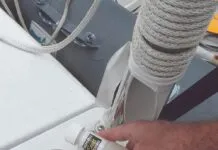
Diesel Performance Additives

What Oil Analysis Reveals About Your Engine
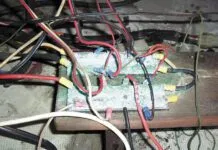
Hidden Maintenance Problems: Part 3 – Gremlins in the Electrics

Seepage or Flooding? How To Keep Water Out of the Boat
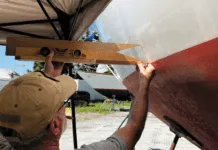
Painting a New Bootstripe Like a Pro

Three-Model BBQ Test

Alcohol Stoves— Swan Song or Rebirth?

Living Aboard with an Alcohol Stove

Choosing the Right Fuel for Your Alcohol Stove

Preparing Yourself for Solo Sailing

How to Select Crew for a Passage or Delivery

Preparing A Boat to Sail Solo

Re-sealing the Seams on Waterproof Fabrics

Waxing and Polishing Your Boat

Reducing Engine Room Noise

Tricks and Tips to Forming Do-it-yourself Rigging Terminals

Marine Toilet Maintenance Tips

Learning to Live with Plastic Boat Bits
- Sailboat Reviews
Practical Sailor Reviews Seven Performance-Sailing Dinghies
Agile, fun boats like the classic sunfish and new hobie bravo keep the smile in summer sailing..

Photos by Ralph Naranjo
Messing around in small boats is a global theme-one thats embraced by pond-bound pram sailors, river riders, lake voyagers, and all of us who call salt water home. The purpose of this sailing dinghy profile is to highlight seven very interesting little sailboats. Some are new designs, and others have stood the test of time, but all are currently being manufactured, and each drives home just how much fun sailing close to the water can be.
This isn’t a shootout among anorexic speedsters or a report on the best tender that doubles as a sailing dinghy. Its a look at perennials like the Optimist, Sunfish, and Laser-legendary competitors that have helped spawn some of the best sailors in the world. But its also a look at three of the newest entries in the dinghy-sailing circle: Bics Open, Hobies Bravo, and Laser Performances Bug. These agile, new sailing dinghies are chock full of fun and boat-handling features to inspire kids of all ages to go sailing.
Well also take a look at Chesapeake Light Crafts kit approach to getting started-one that offers meaningful lessons and tangible rewards well before the boat ever hits the water.
Scale down an Open 60, add sail technology long favored by windsurfers, and put it into play in a tough thermo-formed hull, and you have the makings for a new kind of watercraft. The result is a very interesting blend of performance and reliability that targets adolescent interest. When all is said and done, Bics boat is more akin to a sit-down windsurfer than a traditional Blue Jay. And like all good boats, its vying for attention not just based on performance, construction quality, and style, but just as importantly, on the price tag stuck to the hull.
The Open Bics light weight and wide, flat stern section means that even small chop can be surfed; and bursts of planing on a reach add a zing factor to dinghy sailing. The Open Bic is already an International Sailing Federation (ISAF)-sanctioned class, and fleets are developing around the US. Another bonus: Its an easily portable boat that can be carried like a windsurfer, adding excitement to a Sunday picnic at the beach.
The thermo-formed polyethylene hull is a modified hard-chine design with lots of beam aft. Sailed flat, the boat is agile enough to surf wavelets, and with a shape thats ergonomically friendly to hiking, the ensuing heel on the upwind leg puts just the right amount of chine into the water. In light air, careful control of heel can significantly reduce wetted surface.
The design team that developed the Open Bic saw it as a transition bridge from Optimist sailing to a more performance-oriented dinghy. An interesting innovation is that the Open Bic can be sailed with an Optimists rig and blades. This buy the hull only approach can be a significant incentive for parents with children outgrowing their Opti as fast as their boat shoes. However it wont be long before the kids want the fully turbo-charged feel delivered with the Open Bics well-shaped 4.5-square-meters rig, sail, and nicely foiled blades.
Bottom line: The Open Bic is fast, agile, and buckets of fun for kids uninspired by sailing in the slow lane.
Just when you think that Hobie Cat Co. has covered whats possible in beach-cat innovation, their design/engineering crew comes up with a new twist that reinvents the wheel. The Hobie Bravo is a good case in point.
In a recent visit to Backyard Boats ( www.backyardboats.com ) in Annapolis, Md., we got a good look at the Bravo. Nearly as narrow as a monohull but still quite stable, this quick-to-launch beach cat packs plenty of get-up-and-go. Its a simple to sail, entry-level boat that fast tracks learning the steer, sheet, and hike trilogy. The boat features a single, midline rudder and roto-molded hulls. The shape of the hulls provides enough lateral plane to allow a crew to make headway to windward.
The narrow (4 feet), 12-foot Bravo uses crew weight and hiking straps to add to the righting moment once the breeze is up. Whats done with webbing on larger cats has been converted to a shallow, rigid deck well on the Bravo. It does raise the weight of the boat to 195 pounds, but it offers comfortable seating plus room for cushions and a cooler. Kids or grown ups can have a Tom Sawyer-Huck Finn type of adventure aboard this fun little sailing machine. Or the family on a beach picnic can set it up and take turns speed reaching along a sandy shoreline.
The furling mast supports a roachy sail with slightly slanted vertical battens, helping to shape the boomless mainsail. The result is convenient sail handling, decent performance, and superior safety. Theres no boom to clobber the crew, and the roller-furled sail and mast are easily stepped in the tripod-like receiver. This interesting set of struts raises the top bearing point of the mast step and spreads rig loads out to the hulls. The furling mainsail offers the ability to reef, a big plus in a building breeze or when teaching children to sail.
Like all of the boats in the Hobie lineup, theres a wide range of specialty parts and fittings that make the boats fast to rig and easy to handle. The kick-up rudder is hung on gudgeons mounted in the center of stern, and just as rig loads have been effectively spread via the tripod step, the energy radiating from the large rudder is spread athwartships via a contoured deck element.
Bottom line: The boat is quick to rig, easy to launch, and responsive to beginners-more experienced sailors will have just as much fun power reaching when the breeze is up.

A pocket-sized club trainer, the Bug is an evolution of the kids trainer/club racer that leverages lessons learned in Optis, Dyers, and Sabots. It pulls together the logic of a stable hull shape and simple-to-sail rig, and puts it all in a cost-effective package.
Lending to its success is designer Jo Richardss ergonomic, roto-molded hull, a fabrication that is as close to zero maintenance as a boat can get. The straight out-of-the-mold polyethylene skin gets a few decals, and theres no wood to refinish or gelcoat to wax. These tough, abrasion-resistant hulls have a bumper boat tolerance thats a big plus when it comes to kids learning to sail. Best of all, owners can start with a learn-to-sail rig and upgrade to a more performance-oriented mast and sail package (41 or 56 square feet) that kicks performance into the fast lane.
Oars and an outboard motor bracket can be added to turn the little sailboat into a dual-purpose dinghy. Even the bow painters means of attachment makes sense-no projecting hardware ready to knick the topsides of unintended contacts. Instead, theres a recessed hole in the stem allowing a line to be lead through and a knot used to keep the painter in place.
Bottom line: Aimed at club programs and families look for boats that can be transported on the car top, the Bug is easy to rig and definitely kid friendly. The fact that its manufacturer, Laser Performance, is an international interest and a major player in the performance dinghy industry means that this boat and its parts will be around for a while.
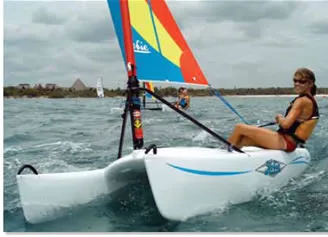
Photo courtesy of Hobie Cat Co.
Eastport Pram
Chesapeake Light Craft expedites boatbuilding for do-it-yourselfers looking to take their garage-built boats for a sail. The company pre-cuts parts, packs kits with all the materials, epoxy, and paint youll need, and leads homebuilders through a thoroughly detailed stitch-and-glue approach to assembly. Kits are available in various stages of completeness, ranging from plans only to the full package, including sail, hardware, running rigging, and paint.
The Eastport Pram is just shy of 8 feet, and the marine plywood and epoxy construction delivers a boat that weighs in, sans sailing rig, at just 62 pounds. Lighter than the comparatively sized Bug, this stiff, durable dinghy, rows like a real boat and sails comfortably with one or two aboard. In keeping with other good tender attributes, the Pram behaves under tow and is equally amicable when propelled by a small outboard or tacked up an estuary under sail.
Kit boatbuilding continues to have a niche following. Theres also an added-value feature worth noting: On one hand, the builder receives a box of pieces and the result of his or her endeavor leads to an aesthetic and utilitarian dinghy. In addition, the DIY skills the builder develops will be useful in other epoxy bonding, brightwork, or mono-urethane application projects. Such talents will benefit many other boat maintenance endeavors.
Whats hard to quantify is the sense of accomplishment derived from sailing a boat that you have built yourself. When the project is tackled in tandem with a child, spouse, or friend, the memories and the boat will last.
Bottom line: With neither sidedecks or a sealed hull, this is not a boat thats easy to recover from a capsize. So once the kids favor on-the-edge sailing in a building breeze, a non swamping, easier-righting boat is probably a better option. The Pram can then be put to use by their appreciative parents or grandparents.
Never in their wildest dreams did Bruce Kirby and Ian Bruce imagine that the Weekender (the Lasers original name) was destined to become an Olympic class sailboat and one of the most popular springboards for top-tier sailors in the world today. Originally envisioned as a car-topper for weekend campers, the cat-rigged, low freeboard sailing dinghy morphed from its original roots into a boat favored by college competitors and revered by generations of agile sailors of all ages. Even frostbiting winter sailors have locked onto the Laser.
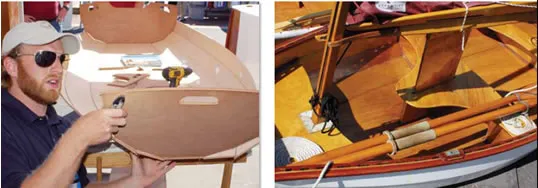
Designed in 1969, the Lasers first few years were anything but smooth sailing. Popularity grew quickly, but along with the limelight came plenty of consternation. Dubbed a surfboard not a sailboat by a growing cross-section of the yachting elite-many parents warned junior sailors to steer as clear of Lasers as they did sex, drugs and rock-n-roll. The campaign failed, and junior sailors in yacht club programs around the country fell into the grip of the new one-design dinghy-discovering the sailboats proclivity to plane.
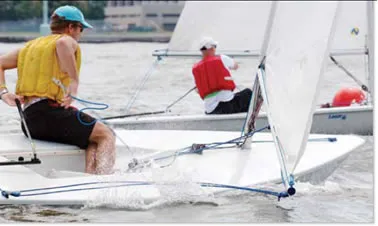
Dyer Dhows languished in boat sheds across the country as a new theme in sailing took hold. Dubbed fast is fun by sailor/engineer Bill Lee, the young Merlin of Santa Cruz, Calif., took the theme to big-boat sailing, merging California culture with the Laser logic of light displacement and planing hull shapes.
Best of all, the Laser embraced the ideal of a tightly controlled one-design class that put people on the water in identical boats and left winning and losing races up to sailing skill and tactics rather than a boats performance edge. For decades, the boat has been the single-handed sailors choice among junior sailing programs, and with the addition of the Radial, 4.7 and M rigs, smaller competitors have also found the boat to be a great sailing platform. Today, theres some lawyer saber-rattling over the sale of the design rights, but the boat remains more popular than ever.
The sleeved sail, two-part spar, daggerboard, and kick-up rudder make the boat a quick-to-rig and fast-to-get underway dinghy. Light-air efficiency is good for a one-design sailboat, but this means that as the breeze builds, the non-reefable sail can become a handful in a hurry. In fact, the boats Dr. Jekyll-and-Mr. Hyde demeanor is what builds talent among Laser practitioners. The big boys block the mainsail and blast off for the layline, while lighter sailors heavy-weather tactics include more nuanced de-powering and feathering. In light air, the tables turn, and the winner is often the sailor who planes quickest on the reaches. The old guards surfboard slam may have held some credence after all.
Bottom line: The Laser is a timeless classic thats easily transported and is built for performance. Its well suited to adrenaline-seeking teens as well as the more fit adult crowd.
Designed in 1947 by Floridian Clark Mills, the utilitarian Optimist could be made out of two sheets of plywood-and from its inception, the Optimist was meant to link kids with the water. Slipping into obscurity in the U.S., the little pram found fertile ground to grow in northern Europe. With just a few tweaks, the Scandinavians took Millss lines and parlayed them into whats become the favored junior sailing trainer for kids from Detroit to Timbuktu. Statistics show that there are about 30 builders worldwide putting out approximately 4,000 boats each year. With about 130,000 boats class registered and an estimated 300,000 total hulls built (amateur and pro), theres plenty of reasons to get excited about an Opti.
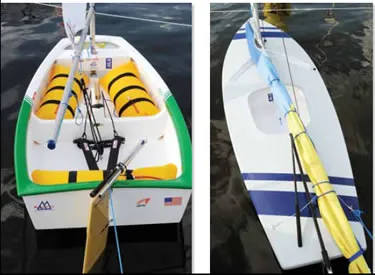
The example weve chosen is the USA-built McLaughlin boat, both a demonstration of high-quality FRP construction and modern manufacturing techniques. Its also a boat that can be purchased in a range of performance-inducing iterations-upgrades designated as club, intermediate, advanced, and professional versions. Like all performance sailboats, stiffness and strength-to-weight ratio is important. But class rules include a minimum weight, so the most competitive hulls meet the mandatory lower limit but use good engineering and building technique to reinforce the daggerboard slot and mast step and produce overall stiffness.
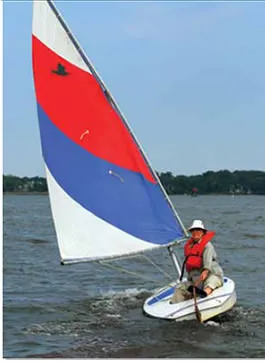
The low mast height and high aspect ratio sprit sail is very versatile, affording young (and small, 65 to 130 pounds) sailors a wide window of decent performance. The flat bottom, slab-sided hull is responsive to crew weight-driven trim changes, and the better the sailor, the more agile they become. Light-air performance is all about minimizing wetted surface and maximizing sail area projection. When the breeze starts to kick up, the sailor becomes the ballast, and the art of hiking, sheet handling, and tiller wiggling come into play.
Under careful adult supervision, two 6- to 8-year-olds can double-hand the friendly little dinghy, or one more-confident child can solo sail it. In fact, introducing kids to sailing with similar proportioned small prams has been a right of passage around for decades. A set of oarlock gudgeons can turn the pram into a functional dinghy thats also adaptable to the smaller Torqeedo outboard (www.torqeedo.com).
McLaughlin also markets a Roto-molded polyethylene version of the Opti and sells DIY kits for those who want to create their own wood version.
Bottom line: The Opti is like a first bicycle without the need for training wheels. The fact that at the last Olympics, over 80 percent of the winning sailors had gotten their start in an Optimist speaks well to the value of messing around in this particular dinghy.

Designed in 1951 by ice boaters Alexander Bryan and Cortland Heyniger, the hard chine Sunfish was the prototype board boat. In 1959, it made the transition into fiberglass, and over the following half-century, more than a quarter-million hulls would hit the water. Simplicity and decent sailing attributes combined with an attractive price to make the Sunfish the most popular one-design dinghy ever raced.
Far more than a platform for racers, these boats are an excellent training tool for sailors of all ages. Also built by Laser Performance, they reflect the fun of summer and put sailors in close contact with the water on which they sail. Its no surprise that the larger fleets coincide with warm water and many see going for a swim to be part and parcel of the low-freeboard experience.
The lateen rig is in keeping with the overall design concept and simplifies rigging. A short stub of a mast is stepped and a single halyard hoists the sail along with tilting V-shaped upper and lower booms.
The total sail area is nearly the same as the Laser, but the halyard hoist versatility of the lateen rig make it a handy beach boat and a little less daunting when the wind begins to build. The clean sail shape on one tack and deformation caused by the mast on the other tack are a slight drawback. The Laser rig is more efficient, but when caught out in a squall, its nice to be able to ease the halyard and dump the sail. Its also handy to be able to leave the boat tethered to a mooring, and the doused sail and short mast make it possible.
Multiple generations of sailors are often found sailing Sunfish, and the boat represents one of the best bargains to be found in the used boat market. When considering a pre owned boat, the potential buyer needs to take a close look at the daggerboard-to-hull junction and mast step, points where previous damage can create hard-to-fix leaks.
Bottom line: The Sunfish is a great beach boat that can turn a hot afternoon into a fun-filled water experience.
There were no losers in this group, and picking winners and runners-up proved a difficult task. The outcome had to be based on assumptions about how these boats would be used. For example, parents with a competitive 9-year-old who swims like a fish, always sprints for the head of the lunch line, and likes to steal bases in Little League probably have an Opti racer in the making. Less competitive junior sailors-future cruisers in the making-will do better learning aboard a Bug. Many newly formed sailing clubs target the boat as their trainer of choice.
The Bravo holds plenty of appeal for those with a lakeside cottage or a favored campground destination. Whether its a solo sail just before sunset or a fun race on Sunday, the quick to set up and put away features are a plus, and for those who feel that two hulls are better-the Bravo will hold plenty of appeal.
Serious competitors can campaign a Laser for life, and whether youre headed for a local district regatta or getting ready for the Olympic trials, the hull, rig, and sail remains identical-sort of like the Monaco Grand Prix being raced in a street legal Mustang.
Bic Opens new little speedster tickled our fancy, and as a trainer/performance boat crossover, it drew a strong nod of approval. Watching the junior sailors smiles as they sailed their Open Bics endorsed our opinion.
And if there is any boat that defines the essence of summer, the Sunfish takes the prize.
- The Art of Building with Thermal-setting Plastics

- Youth Safety Gear Top Picks
- Chesapeake Light Craft
- Hobie Cat Co.
- Las er Performance
- McLaughlin Boat Works
RELATED ARTICLES MORE FROM AUTHOR
Leave a reply cancel reply.
Log in to leave a comment
Latest Videos
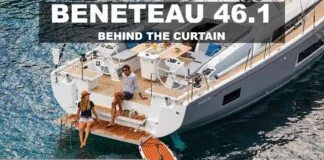
Beneteau 46.1: What You Should Know | Boat Tour

How to Clean Your Sails

C&C 40: What You Should Know | Boat Review

A Simple Solution for Boat Toilet Stink
- Privacy Policy
- Do Not Sell My Personal Information
- Online Account Activation
- Privacy Manager

Please verify you are a human
Access to this page has been denied because we believe you are using automation tools to browse the website.
This may happen as a result of the following:
- Javascript is disabled or blocked by an extension (ad blockers for example)
- Your browser does not support cookies
Please make sure that Javascript and cookies are enabled on your browser and that you are not blocking them from loading.
Reference ID: 3430e7d6-229e-11ef-a729-10b234df8e68
Powered by PerimeterX , Inc.
- Paddle Board

A Guide to Dinghy Boats
Are you looking for an affordable boat for your fishing trips or watersports? The dinghy offers you the best options for a low-cost, versatile watercraft. There are several dinghy designs to suit any watersports activity.
Typically, dinghies are the best choice for watersports like skiing and diving. However, some models are good for cruising or light sailing, with options for motors or sails. A dinghy can range in size, but most of them are suitable for carrying two to six people.
Dinghies are available in models suiting use in freshwater or saltwater, with inflatables, solid boats, and more options. Is a dinghy the right choice for your boat? Let’s unpack everything you need to know about these watercraft.
What Is a Dinghy Boat?
A dinghy is a small boat, usually and inflatable, and most models are around five to ten feet long. A dinghy is easy to transport, and it offers versatile utility for fishing and watersports. You also have options for motors, sales, or you can use oars to propel the boat.
Dinghies can feature fiberglass construction, or they may use inflatable pontoons, similar to a pontoon boat. The inflatable models typically feature design and construction with Hypalon or PVC. These polymers provide UV resistance, tough resistance against punctures, and easy repairs.
The sides on inflatables also act as seats, allowing fishing directly from all sides of the boat. Dinghies are not really built for speed; they usually come with low-powered trolling motors with a 3-hp to 5-hp output. However, they are ideal for moving through estuaries and lakes, allowing for silent movement so you don’t disturb the fish.
What are the best beginner sailing dinghies?
If you’re just getting into sailing, there are several dinghy options for enjoying your time out on the water. Whether you want to sail solo or with a friend, there is a boat for you.
Training Sailing Dinghies
These models are easy to master, giving beginners the chance to master the complexities of sailboats. They are simple to operate, safe, and offer you the best option for learning to master sailing techniques.
Doublehanded Sailing Dinghies
These models cater to two passengers for handling the sail and rigging. They are great for learners, allowing them to take an experienced sailor out on the water to learn the ropes.
Singlehanded Sailing Dinghies
These models have a design for one person. Typically, they are smaller boats, and you’ll already have to know how to sail. However, they are easy to master, and spending time out on the water will familiarize you with the aspects of sailboats.
These dinghies feature double or triple hulls. They are typically the best choice for racing, and they offer excellent stability in all water conditions.
Different Types of Dinghy Models
As mentioned, there are several models of dinghies for different watersports activities. Here are the most common options; we categorized them into sailing dinghies and inflatable dinghies.
Sailing Dinghies
A sailing dinghy is a small sailboat with no fixed keel and a shallow draft. These models are ideal for sailing in lagoons, estuaries, and lakes, navigating shallow waters. The sailing dinghy typically features a fiberglass design, with an open-plan seating area and a mast. These boats usually accommodate anywhere from one to five passengers.

High-Performance Dinghies
High-performance sailing dinghies are another sail-based model that’s ideal for racing. They are fast and cut through the water with ease. You get excellent maneuverability on the water with a low-profile design and an open-plan deck with a mast. The Fireball, International 505, and Thistle are a few examples of leading racing and high-performance dinghies.
Cruising Dinghies
A cruising dinghy is another sail-based model that’s a great choice for cruising out in calm ocean conditions or inland water bodies. They are a recreational vessel equipped with sails and rudders, and you have more passenger capacity than the other sailing models. As a result, they are the ideal choice for family’s that enjoy the sailing lifestyle.
Cruiser-Racer Dinghies
These models are hybrids that come with a focus on performance and stability. They have the ability to race or to cruise, providing excellent stability in the water. They are a great choice for someone that wants to start sailing competitively, and they also work for fun recreational sailing days on the lake with the family. The GP14 is an example of a cruiser-racer offering high-performance standards and stable cruising.
Classic Dinghies
These boats had an original design featuring wood finishes using materials like plywood and cedar. However, modern dinghies feature fiberglass construction. The classic dinghy sailboat focuses on versatility over sailing performance. The Minto is a great example of a classic dinghy.
Inflatable Dinghies
Inflatables are gaining in popularity thanks to the affordable price tag and versatility offered by the boat. Inflatables are easy to carry, and some might even fit on the back of a truck. Inflatables have side pontoons, and many of them are suitable for diving activities or spearfishing. These dinghies usually feature low-powered trolling motors; they don’t have a design for speed.
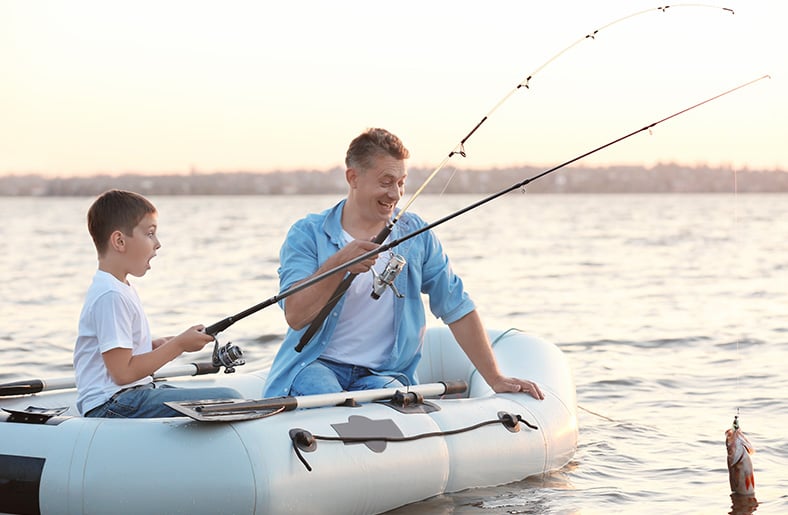
Features and Benefits of Dinghy Boat
Dinghies are versatile and affordable. There are plenty of benefits for choosing this boat beyond just the savings you make over other models.
The dinghy is one of the few boats left that offer a sailing configuration. If you’re into boating on lakes or thinking about sailing competitively, the dinghy is the best choice. Any of the sailing models listed above are a great choice. Pick the boat that offers you the best utility for your sailing needs.
Minimal Noise
Most dinghies are sailing options, so you don’t have to worry about gas fumes from the motor or noise. They offer a serene sailing experience on inland waters. Inflatable models may use a trolling engine for moving through calm, shallow waters when fishing. The low noise and churn produced by the motors won’t scare off the fish. You also have options for poling and oars for moving around without engines.
Trailerable
Dinghies are compact boats with sailing and inflatable models offering you easy trailering. Some of the smaller inflatables can fit in the back of a panel van or on the load bed of your single-cab truck. They offer you easy transport between lakes and estuaries, with a lightweight design that’s easy to launch and trailer.
Options for Inflatables or Fiberglass
As mentioned, the dinghy comes in sailing and inflatable options. Some fiberglass models also feature a wood finish on the deck for an added aesthetic that looks like a classic dinghy.
Ideal as an Excursion Boat for Yachts
Many superyachts use inflatable dinghies allowing the passengers to reach the shore. Yachts can’t enter shallow water, and the dinghy makes the ideal transfer boat for reaching the coast from open water. Most of these models feature low-powered motors.
No Need for Registration
Larger vessels require registration before you can take them out on the water. However, dinghies are small, and they don’t need any registration or licensing before you can take them out on the water. As long as the boat doesn’t have a fixed motor and is less than eight feet in length, you don’t have to worry about doing the paperwork. Regulations differ between California and Florida, so check with your local authorities before taking your boat to the lake or slip.
Lightweight
The dinghy is a lightweight boat. The fiberglass and inflatable models offer you a lightweight watercraft that’s easy to launch and pull from the water. They are also easy to repair, with basic fiberglass or polymer patching.
Easy to Maneuver
The dinghy is a super-maneuverable boat. The sailing models are easy to tack in the wind, allowing for sharp turning radiuses and easy maneuverability on the water.
Complete sailing systems
Most sailing dinghies come with options for sail systems. If you want to learn the art of sailing or teach your kids about sailboats, the dinghy is the ideal starter vessel.
Suitable for use in Shallow Waters
The dinghy usually has a high draft and a shallow keel, allowing for sailing in shallow water, such as lakes. These boats won’t run aground, and the low hull design allows for less friction on the water, increasing speed and performance.
Save on Fuel
Sailing dinghies don’t have motors, so you save on fuel costs for your boating trips. Those inflatable models with trolling motors have low-capacity engines, and they are economical with fuel consumption.
Disadvantages of Dinghy Boat
The dinghy is a great choice for your first boat, especially if you want to tackle the art of sailing. However, they do come with some drawbacks.
Minimal Power and Small Motors
Since most models are sailboats, they rely on the wind for performance. Sure, some models can reach high speeds when the winds are right, but they lack a speed boat’s torque and on-demand power. Even those dinghy models relying on trolling motors don’t move very fast.
Limited Standing Room
The sailing dinghy doesn’t offer you any standing room. Sure, you can stand on the deck, but you’ll have to duck and manage the sail, and that could mean the boat tosses you overboard. The small size of the dinghy also means that you’ll unbalance the vessel if you stand on the deck.
Limited Seating
Dinghies are small boats designed for one to five passengers. Sure, you get bigger models, but these dinghies are more like proper sailboats. The seating may also be somewhat uncomfortable, as most models rely on a cast fiberglass deck with molded seats and no cushions.
No Crossover Function
Most dinghies are for sailing, and they don’t offer you crossover functions for fishing and watersports. It’s impossible to tow a skier, and the sail gets in the way of angling. The inflatable models are okay for fishing in shallow waters or inland water bodies, but the seating setup isn’t comfortable. The low-power trolling motors available for inflatable models don’t reach high speeds, making them unsuitable for watersports.
Limited Storage Space
Most dinghy models, especially sailing types, don’t come with consoles or storage systems. Some inflatables might have storage bins in the bow of the dinghy, but they typically don’t offer much storage space.
Top Dinghy Boat Brands and Models
Intex excursion 5.
The Intex Excursion 5 is a great example of an inflatable dinghy. You can seat up to five people in this model, and it has a rubber design with all the fishing accessories you need to get out on the water and enjoy a few hour’s angling in the lake.

You get four rod-holders, a bench-style seat in the boat’s center, and two inflatable seats.
This model comes with an affordable price tag and oars included with your purchase. There’s also the option of attaching a trolling motor for effortless navigation.
However, the boat is not suitable for standing, so don’t expect to cast far with this model. The boat comes with a three-chambered design and a 1,300-lbs capacity.
The Laser is the best choice for a single-hander sailboat dinghy. This boat is ideal for cruising or competitive racing, and they hold their resale value.

You get options for three rig sizes, the 4.7, Standard, and the Radial model. These boats feature fiberglass design and low hulls for easy navigation through shallow waters.
The RS Vision
This family sailboat makes a fantastic trainer, club racer, or cruising model. This boat can accommodate up to eight sailors, and the new RS Quest model features both trapeze and spinnaker options.
Wrapping Up
Dinghies are the ideal boat for learning how to sail, and they also make inexpensive boats for recreational fishing in inland water or calm ocean conditions.
They are not the most durable boats, and they don’t accommodate many people. However, there are plenty of models to suit your sailing experience or watercraft needs. However, they offer lightweight design, user-friendly operation, and choices for inflatable or fiberglass models.
If you’re looking to learn how to sail, you won’t find a better boat available.

John is an experienced journalist and veteran boater. He heads up the content team at BoatingBeast and aims to share his many years experience of the marine world with our readers.
A Complete Guide to Micro Skiffs: All You Need to Know!
A complete guide to narrow boats: all you need to know, a guide to aluminum fishing boats.
Comments are closed.
Type above and press Enter to search. Press Esc to cancel.

Service Locator
- Angler Endorsement
- Boat Towing Coverage
- Mechanical Breakdown
- Insurance Requirements in Mexico
- Agreed Hull Value
- Actual Cash Value
- Liability Only
- Insurance Payment Options
- Claims Information
- Towing Service Agreement
- Membership Plans
- Boat Show Tickets
- BoatUS Boats For Sale
- Membership Payment Options
- Consumer Affairs
- Boat Documentation Requirements
- Installation Instructions
- Shipping & Handling Information
- Contact Boat Lettering
- End User Agreement
Frequently Asked Questions
- Vessel Documentation
- BoatUS Foundation
- Government Affairs
- Powercruisers
- Buying & Selling Advice
- Maintenance
- Tow Vehicles
- Make & Create
- Makeovers & Refitting
- Accessories
- Electronics
- Skills, Tips, Tools
- Spring Preparation
- Winterization
- Boaters’ Rights
- Environment & Clean Water
- Boat Safety
- Navigational Hazards
- Personal Safety
- Batteries & Onboard Power
- Motors, Engines, Propulsion
- Best Day on the Water
- Books & Movies
- Communication & Etiquette
- Contests & Sweepstakes
- Colleges & Tech Schools
- Food, Drink, Entertainment
- New To Boating
- Travel & Destinations
- Watersports
- Anchors & Anchoring
- Boat Handling
- ← Products & Services
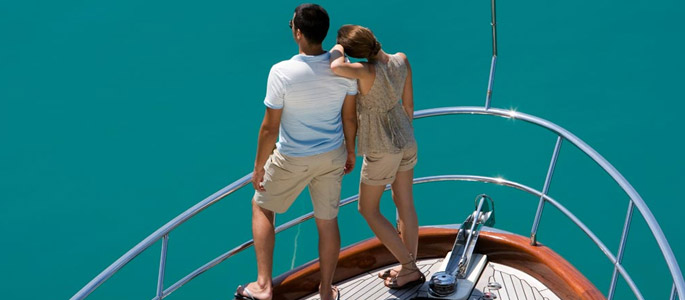
Finance your dream boat
Here’s what you need to know.
Working with leading marine lenders, our partners are able to offer competitive rates and terms to help you purchase a new boat or refinance your existing boat loan. We offer loans for powerboats, sailboats, multi-hull boats, pontoons, and even personal watercrafts.
Use our Boat Loan Calculator to determine a monthly payment that’s right for you, then fill out an Online Loan Application for our lending partner to underwrite.
- If you are applying for a loan for $25,000 or greater, click here to apply online .
Once your application is completed, a representative will evaluate the application to determine the next steps, in an effort to make the closing process as seamless as possible.
Calculate Payments with Our Boat Loans Calculator
Use our boat payment calculator to determine a monthly payment that you can afford when looking to finance a new or used boat.
Simply enter your desired amount, estimated interest rate, and the loan term over which you intend to pay back the loan. Once you've input the information, the calculator will generate your estimated monthly payment on your boat loan. Take this number and plug it into your current monthly budget.
Boat Loan Calculator
Monthly Payment
Total Loan Amount
Your Monthly Payment is:
Your Max Loan Amount is:
Helpful Terms and Phrases
Monthly Payment What you're paying out of pocket every month to repay your loan.
Number of Years How many years you're looking to pay back the loan (term of loan).
Interest Rate Interest rate accompanying this type loan.
Total Purchase Price This is the total cost of your boat purchase. Don't include sales tax in this amount.
Down Payment This is the total out-of-pocket amount you are paying toward your purchase. Standard down payment is 15% but depending on your boat age, loan amount, and loan term the required down payment can be between 10% - 30%.
Deposit This is the total amount you have already paid toward your down payment.
Trade Allowance The total amount that you are given for any vessel that you trade-in as part of this purchase.
Amount Owed On Trade Total loan balance outstanding on the trade-in.
To get started, you will need to complete the Online Loan Application. Our lending partner will do an initial review and credit inquiry and likely will request additional financial information such as tax returns or bank statements to help them make a decision. Once approved, the lender will list any additional items needed prior to closing (for example, a marine survey and executed sales contract). Next, our lending partner will collect information from the seller(s) to finalize the loan closing paperwork. Once readied, our lending partner will send closing documents to the buyer(s) and the seller(s) for completion. Lastly, our lending partner would send the loan proceeds to the seller(s) in accordance with the funding instructions.
Boat loans share some similarities with both vehicle and home mortgage financing. You will need to complete a loan application for our lending partner to underwrite. Similar to a home mortgage, the bank can ask for your personal federal tax returns, proof of assets, and may ask for additional financial information depending on each situation.
Similar to a vehicle loan, the lender has a loan‐to‐value guideline that is based on the book value for used boats and the contract price for new boats. All of the lender's underwriting criteria must be met to offer approval, and these guidelines tend to be more rigorous than vehicle financing. If approved, the lender would outline any additional items needed prior to closing and closing paperwork would be prepared once all of the necessary information has been collected.
You will need to provide basic demographic and employment information, complete a personal financial statement that lists all your assets and liabilities, and provide us with information on the boat you are interested in buying or refinancing. As part of the underwriting process, our lender will likely ask for tax returns and bank statements for non-retirement and retirement assets to verify your income and net worth, a copy of the sales contract, and a marine survey report (on most used boats). At the end of the application, you can securely upload these documents to help speed up the review of your application.
Most applicants can expect to have a decision on their application in 2-4 business days. Our lenders will often ask for financial information before making a decision.
Typically, our lenders will require a boat to be documented with the United States Coast Guard if it meets the Coast Guard's net tonnage standard. If the boat you wish to purchase is eligible to be documented, our finance department or lender will prepare a First Preferred Ship Mortgage as part of the loan closing paperwork and file it with the Coast Guard as the instrument that secures the bank's lien on the vessel. If the boat is not large enough to be documented with the Coast Guard, a formal mortgage would not be prepared; however, the lender would still record its lien against a state title or equivalent document. In either event, the lien would be released once the loan has been repaid.
Our lenders do not issue pre-approvals that are similar to what you get when purchasing a house. You are able to apply without having a sales contract on a boat, and you aren't locked into buying the boat that you apply with, but you do need to list a boat on the application.
The rates and terms are highly dependent on the boat, so we recommend applying with a boat that is similar in age, length, and type to the one you are interested in purchasing, and use a realistic purchase price.
Credit requirements vary by lender, but our lenders generally require applicants to have a credit score above 680 with no major credit issues such as a bankruptcy, foreclosure, settlement or charge-off within the past 3 – 5 years.
Generally, marine financing is subject to higher credit and other underwriting standards than that for vehicles or even home mortgages. Our lenders look for applicants with better credit, but there are other companies that will consider individuals with past credit issues.
Our lender will first review your credit score and history to determine if you meet their credit guidelines then review your financial information. When evaluating your application, our lender will look to see that you currently have the funds to make the down payment without depleting your assets, and verify your net worth and debt-to-income ratio (monthly debt payments divided by monthly income) meets their guidelines. They will also review the boat to ensure the purchase price is in line with the market value of the boat by using third-party valuation guides like NADA, BUC and ABOS.
The loan term available will largely depend on the boat you select. We work with banks that can offer terms up to 20 years, subject to the age and type of boat, as well as the loan amount available from the lender.
Once the lender collects all the required information from the buyer and seller, both parties will receive paperwork that they need to sign and notarize. Once the lender receives the paperwork back from both parties, they will disburse funds in 1-2 business days. The buyer and seller do not need to visit a bank or be in the same place to close the loan. If the boat is currently financed, our lender will disburse the funds directly to the lienholder to pay off the loan, otherwise, the funds will be paid to the seller by check or wire transfer.
BoatUS partners with leading marine lenders that consider various types of collateral, including larger, more expensive vessels. Some restrictions do apply — for example, we cannot accept applications for steel‐hull boats at this time.
Use our Online Loan Calculator to determine your monthly payment or enter the desired monthly payment to see the loan amount. to determine your monthly payment or enter the desired monthly payment to see the loan amount.
We recommend you access the NADA Guides Boat Value Online Tool , powered by J.D. Power.
- Loan amounts from $10,000 for boats model year 1998 and newer
- Multi Hull Boats
- Pontoon Boats
We use cookies to enhance your visit to our website and to improve your experience. By continuing to use our website, you’re agreeing to our cookie policy.
- AROUND THE SAILING WORLD
- BOAT OF THE YEAR
- Email Newsletters
- America’s Cup
- St. Petersburg
- Caribbean Championship
- Boating Safety

2024 Boat of the Year Best Dinghy: RS Toura
- By Dave Reed
- December 21, 2023
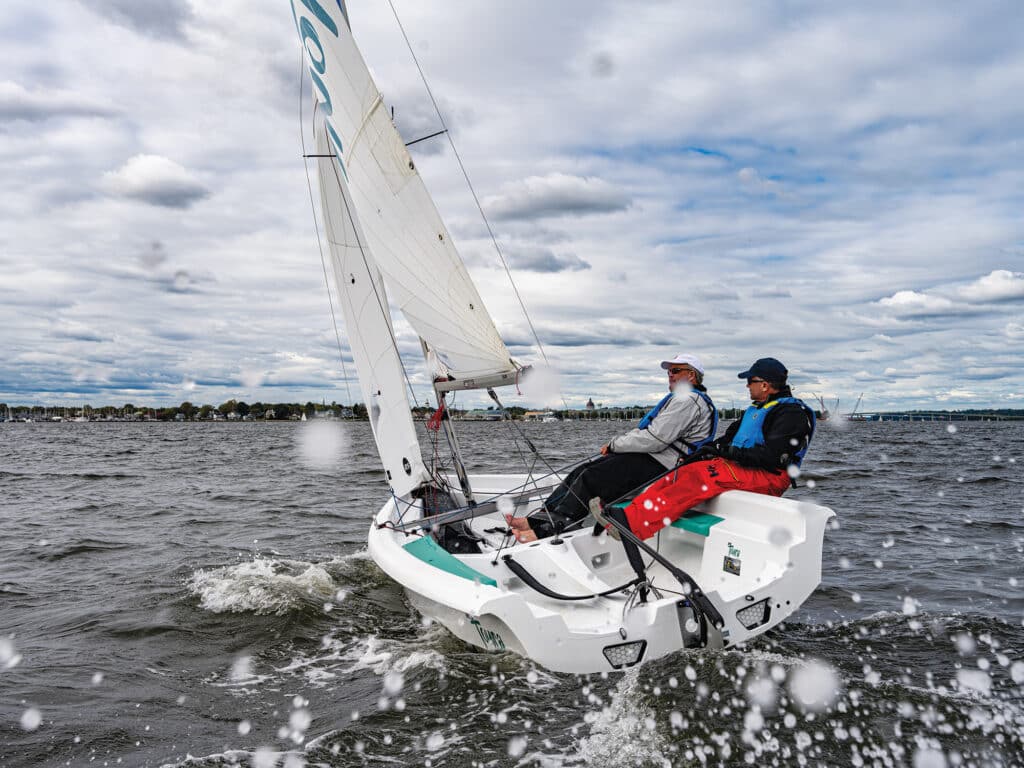
Sailboat racing’s future is inextricably linked to the flow of new sailors who walk through the doors of community sailing centers and yacht clubs. These establishments do the yeoman’s work to attract and retain sailors young and old, and often the biggest challenge is securing boats that deliver a positive sailing experience but can take the abuse. For many such establishments, the saving grace has been the roto-molded trainer, of which RS Sailboats is the dominant builder. It does plastic—and does it extremely well—and the versatile Toura is its best yet.
“This is a fantastic learn-to-sail boat because it checks so many boxes,” Mike Ingham says. “It sails amazingly well, can bounce off a dock or be dragged up a beach, and can fit a lot of people. What really strikes me is how stable and spacious it is, but somehow it performs so much better than I expected. When it comes to innovation, this boat moves the needle for me, no question about it.”
The Toura is the result of a decade’s worth of feedback from sailing programs using RS Sailing’s Quest, its most popular roto-molded trainer, of which there are more than 3,000 in use around the world. “The Quest is an excellent boat,” says RS Sailing’s Todd Riccardi, “but people kept asking for a bigger boat with a little more room.”
That’s a big ask of even the most advanced roto-molding technology because the bigger the boat, the more complex the structure must be in order to keep it stiff and durable yet as light as possible. The Toura might just be at the edge of what’s possible. RS uses what it describes as a three-layer laminate to get a durable shell—an inner layer, a foam core and an outer layer that are applied in stages. But the real structure is from skeletal-like spines that bisect the cockpit and give the boat its rigidity.
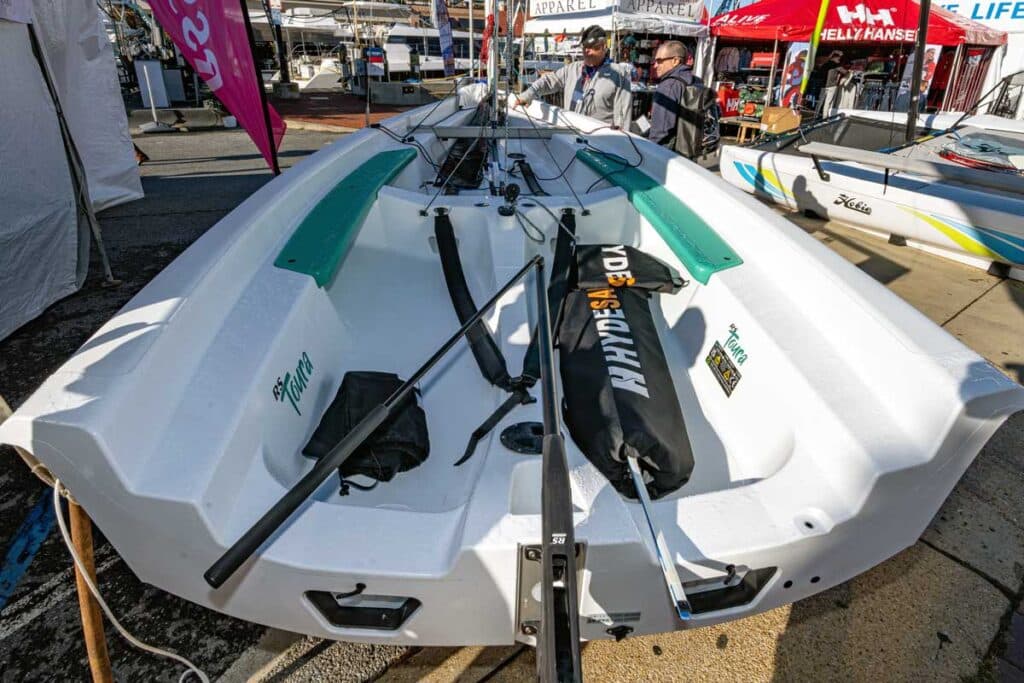
At 15 feet, and with a few inches over 6 feet of beam, the Toura is a substantial dinghy that Riccardi says can comfortably fit as many as six to eight adults and double that amount of kids. Inboard bench seating running the entire length of the boat is how it can fit so many passengers. While that might push the limits of its buoyancy, the judges agreed four large adults would have the right amount of room to casually race and learn the ropes.
RS Sailing has a well-earned reputation for developing and vetting its new boats before bringing them to market, and the Toura is no exception. The boat has many smart features that simplify the learning experience, from launching to capsizing to boathandling and sail trimming. To get the kick-up rudder on and off is a one-button operation. There’s a temporary forestay for safely raising the rig, an adjustable jib-stay purchase at the mast, a single-line mainsail reefing system, and a continuous spinnaker halyard. Riccardi says the boat’s considerable stability is capsize-prevention enough, but should it end up on its side, the square-top main and buoyancy in the bench seating keep it from turtling quickly. In the event of a capsize, however, aluminum grab handles are built into strakes that run along the bottom of the hull.
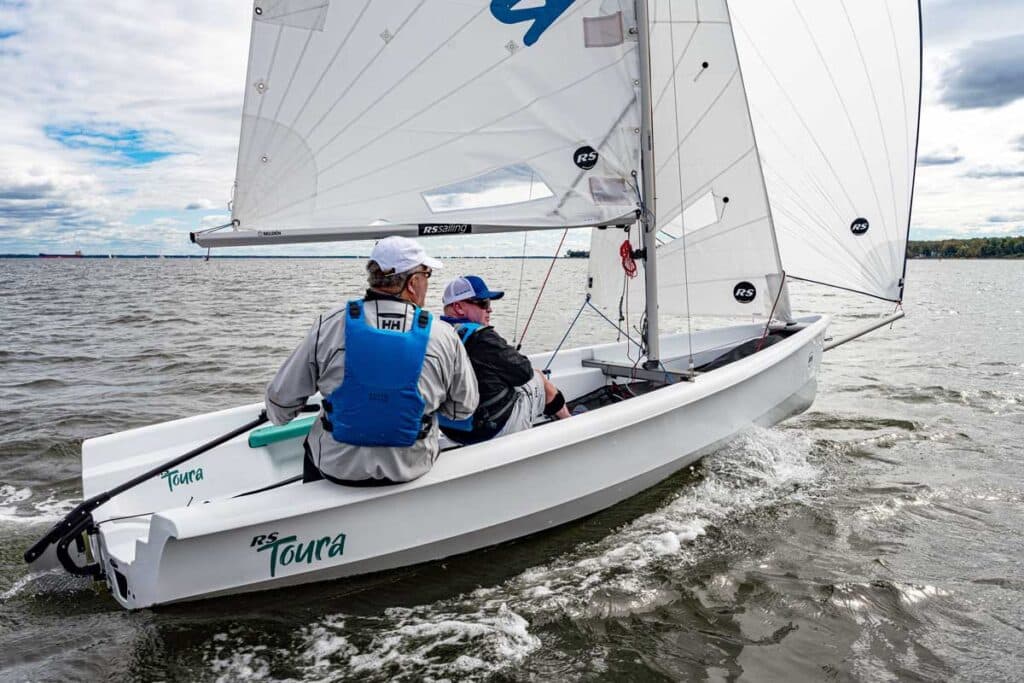
The judges, sailing two-up and three-up, never got anywhere near the point of capsize in the 10 knots of breeze for the test. With Greg Stewart and Chuck Allen first into the boat, they promptly set the spinnaker and took off. “It sails great, both upwind and downwind,” Stewart says. “It has a great feel to the helm, and I pressed it hard a few times and it never spun out. All the rigging was really nice, and the sail controls all worked. My one comment is that the 4-to-1 mainsheet gets pretty loaded because the main is pretty powerful and the cloth is good, so I’d be inclined to add a becket block to the mainsheet to get a bit more purchase.”
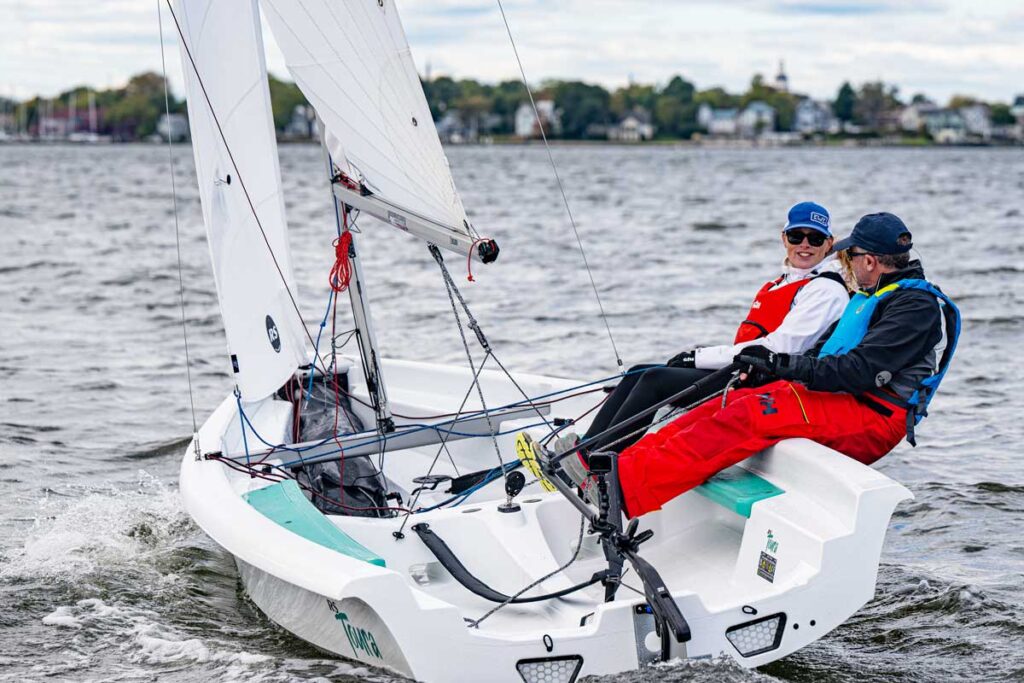
Allen put high scores in his notebook and says he was able to sit comfortably on the seat and use the spine as a foot brace. “We had it going pretty quick and found that with a little heel angle, the chine bites and the boat suddenly feels really stable. Great all-around performance, and with the high boom, the low centerboard trunk, and the vang on top of the boom, it was easy to get across the boat. Downwind with the spinnaker, it was awesome. Every control was easy to pull, and the nonskid had excellent grip.”
- More: 2024 Boat of the Year , Print January 2024 , Sailboats
- More Sailboats

Nautor Swan Has A New Pocket Rocket

Pogo Launches its Latest Coastal Rocket

A Deeper Dive Into the Storm 18

2024 Boat of the Year Best Recreational Racer: Z24
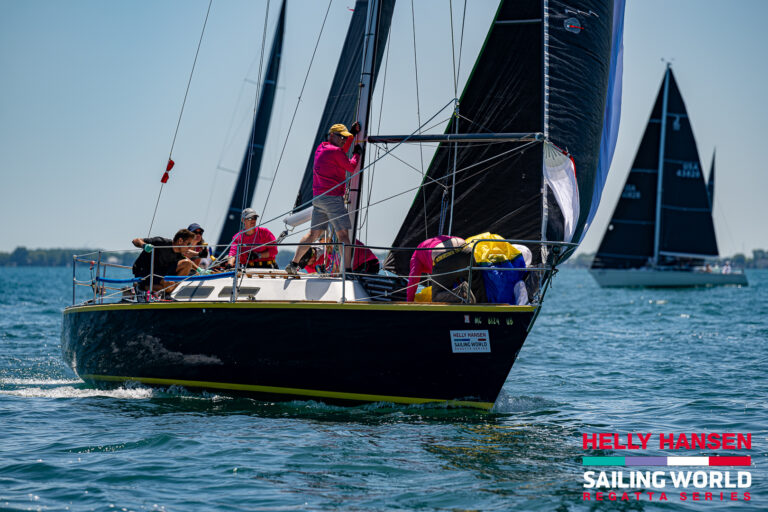
Detroit Delivers For Regatta Series Start
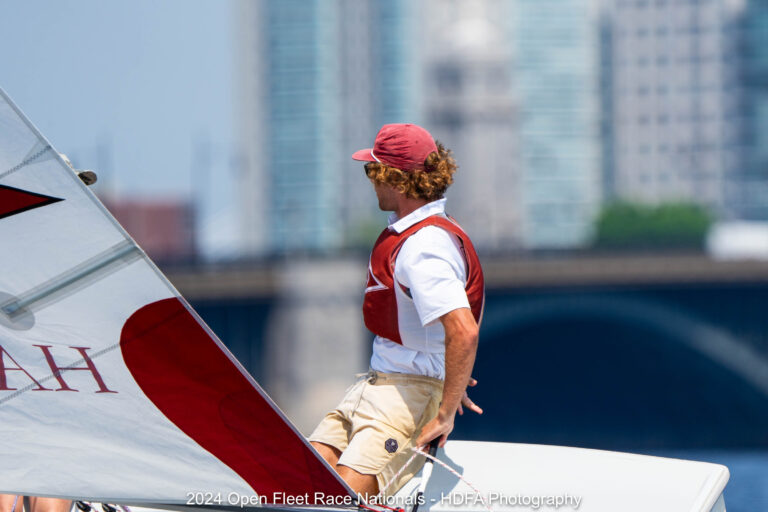
Harvard Wins Dramatic College Sailing Open Fleet Championship
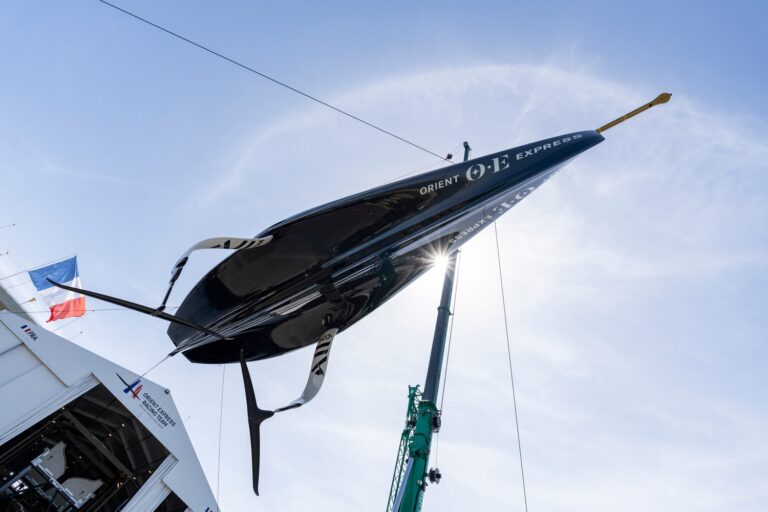
Orient Express Racing Team Joins AC75 Fleet
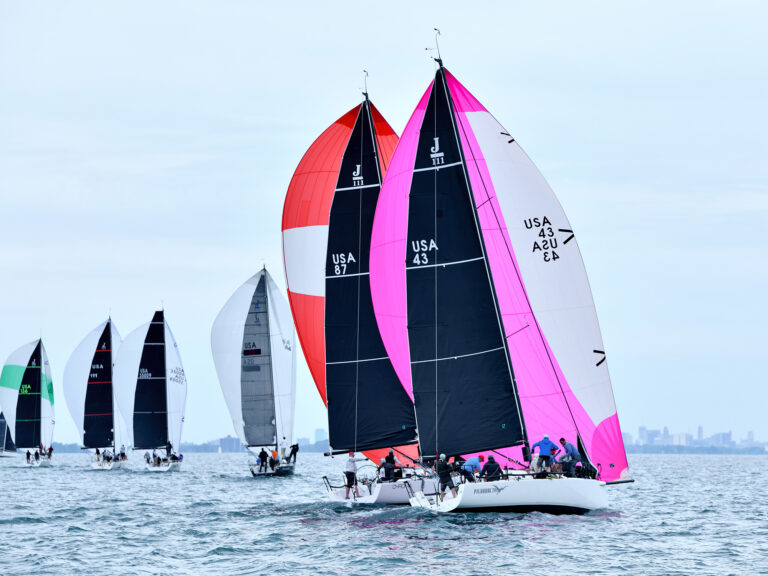
Detroit Racing On the Rise With Regatta Series

- Digital Edition
- Customer Service
- Privacy Policy
- Cruising World
- Sailing World
- Salt Water Sportsman
- Sport Fishing
- Wakeboarding
"Don't let your dinghy become a drag!"

727-771-5066
Strong, light and affordable davits, martek 370 davit system.

MarTek 600 Davit System

MarTek 600 EXT Davit System

#1 Consumer rated for Value and Quality
Featured products.

Rail Mount Extensions (Pair)

Rail Support System (Set)

Davit Cam Cleats (Pair)

6:1 Purchase Set

4:1 Purchase Set
Martek Davits has been designing and fabricating Dinghy Davits over twenty years. Team Mar-Tek’s desire to work with the customers prior to selecting, during the installation, and following up with our industry leading warrantee, has assured a smooth installation accomplished easily by most.
- Accessories (16)
- Dinghy Davits (3)
- Engine Hoist (1)
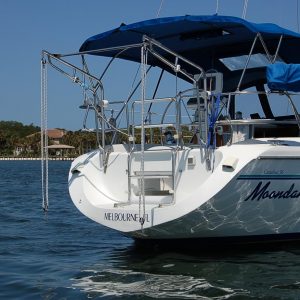

- GET EMAIL ALERTS
- Weather
Search location by ZIP code
Black smoke billows from burning boat on merrimack river in newburyport.
- Copy Link Copy {copyShortcut} to copy Link copied!

GET LOCAL BREAKING NEWS ALERTS
The latest breaking updates, delivered straight to your email inbox.
A 26-foot recreational boat caught fire in Newburyport, Massachusetts, sending up a dark plume of black smoke late Monday morning.
Just before noon, Newburyport Fire was notified of a boat fire at the Newburyport Boat Basin, at 346 Merrimac St. Responding crews found a twin-engine boat on fire. It has been moved away from other boats in the marina to the other side of the Merrimack River to prevent the fire from spreading to other vessels or structures.
Low tide left the burning vessel stranded in the mud. The remnants of the boat will be towed back to shore at high tide.
No injuries were reported.
The cause of the fire will be investigated by Newburyport Fire.
Coast Guard rescues 8 clinging to cooler after boat capsizes off Boca Grande, Florida coast
The U.S. Coast Guard rescued 7 adults and one child Saturday after the 28-foot boat they were on capsized 36 miles west of Boca Grande, off the Southwest Florida coast.
According to the Coast Guard , the boaters sent a distress call reporting their boat was sinking and activated an emergency position indicating radio beacon.
A Coast Guard Jayhawk helicopter was dispatched and zeroed in on the signal of one of the boaters' personal locator beacons, spotted the device's strobe lights and found all eight wearing life jackets while clinging to a cooler.
The aircrew hoisted the boaters from the water onto the helicopter and took them to emergency medical services at the Venice Municipal Airport. No injuries were reported, according to the Coast Guard.
"The boaters in distress carried close to every piece of lifesaving equipment we encourage the public to carry onboard their vessel,” U.S. Coast Guard Petty Officer 3rd Class Santiago Gomez said .
“Life jackets, an EPIRB, a PLB, visual signaling devices and a marine grade radio with VHF-FM channel 16 improve our Coast Guard crews’ abilities to locate mariners in distress and increase the chances of a positive outcome to bring them safely home. Today marks the beginning of the 2024 Atlantic Hurricane Season , and these safe boating practices make a difference year-round.”
80-foot luxury yacht sinks off Florida coast 1 week earlier
Two people were rescued off the Florida coast one week earlier, when the 80-foot yacht they were on sank 3 miles off the St. Augustine Beach coast May 26.
The $1 million luxury vessel reportedly struck a dredge pipe piling and began taking on water.
One person was injured and the boat's owner will be responsible for arranging salvage.
Where is Boca Grande, Florida?
Boca Grande is an affluent coastal community on Gasparilla Island, northwest of Fort Myers in the Gulf of Mexico.
It sits just north of the barrier island of Cayo Costa, where Hurricane Ian made landfall on Sept. 28, 2022.
Boca Grande is known for its white sand beaches , turquoise waters, fishing and state parks.
Boating accidents in Florida
Florida led the nation in registered boats , with 1,035,911 registered in 2023, according to a Florida Fish and Wildlife report.
Collisions with fixed objects were named as the leading cause in 659 boating accidents reported in Florida in 2023. The accidents resulted in 56 fatalities.
More recently, 15-year-old Ella Riley Adler was struck and killed by a boat in a hit-and-run while wakeboarding in Key Biscayne on May 11, 2024.
The driver of the boat was later identified as 78-year-old Carlos Guillermo Alonso , of Coral Gables. Alonso's attorney told USA TODAY he did not know he struck anyone on the water.
Florida boating safety tips
Florida Fish and Wildlife has these safety recommendations for Florida boaters:
- Wear a life jacket
- Be aware of your surroundings
- Designate a sober driver
- Take a Boating Safety Course
- Check your safety gear
- File a Float Plan
- Watch the Weather
- Stay with the boat
- Report boating violations and dangerous or irresponsible vessel operation to the Wildlife Alert Program
- Know and follow the rules
Support local journalism by subscribing to a Florida news organization .
How Zongzi Became the Must-Eat Food During the Dragon Boat Festival
A festive recipe to ward off sea monsters remains a staple of one of China’s biggest cultural events
/https://tf-cmsv2-smithsonianmag-media.s3.amazonaws.com/accounts/headshot/Michelle_Tchea-edit.png)
Michelle Tchea
Freelance writer
:focal(1060x711:1061x712)/https://tf-cmsv2-smithsonianmag-media.s3.amazonaws.com/filer_public/bd/60/bd609837-3c34-401b-8d9c-d79a0554fde9/gettyimages-968349934.jpg)
Pierogies, cepelinai, mandu. Most cultures have their own version of dumplings. The pillows of deliciousness are the ultimate comfort food for many people around the world.
The Chinese have many variations: steamed, fried, grilled on a hot plate and even served piping hot with soup inside. But the king of all dumplings might just be zongzi , a parcel made of sticky glutinous rice wrapped neatly in a bamboo leaf and filled with umami-rich ingredients, like marinated pork, shiitake mushrooms, peanuts and beans. Eaten any time of the day and year by the dumpling-obsessed, they are most commonly enjoyed during one of China’s biggest cultural events: the Dragon Boat Festival.
Unlike stir-fry dishes from China that come with a reputation of being fast, quick and easy, making zongzi is a very labor-intensive process. In the buildup to the Dragon Boat Festival, my Taiwanese mom would prepare all the necessary ingredients. First, she would immaculately wash the bamboo leaves, scrubbing them free from dirt and grime, and continuously rinse the glutinous rice until the water ran clear to remove unnecessary starch, which could make the dumplings claggy. The next step would involve marinating, spicing and chopping all the ingredients for the filling—a mix of fatty pork belly, shiitake mushrooms, peanuts and home-cured salted egg yolks for that extra touch of luxury. With all the ingredients laid out on a kitchen bench, my mom would then spend a couple of hours wrapping the zongzi. Sitting on a small stool with a piece of string hanging from a hook, she twisted the bamboo leaves in her nimble hands to form a pocket to hold the rice, before filling just the right portion-size of meat, peanuts and mushrooms to prevent the zongzi from bursting when steamed or boiled, and tying the bundle up with the string. The final installment of the time-consuming process was the most difficult: waiting for at least four hours for the savory pockets to cook to a tender rice dumpling.
/https://tf-cmsv2-smithsonianmag-media.s3.amazonaws.com/filer_public/1d/1d/1d1d727c-aef3-4024-8cd6-6680b55a80c0/tainan_pork_zongzi_2.jpg)
Even today, my mom’s friends and my aunties drop by spontaneously, handing over their freshly steamed, handmade zongzi—allowing my mom and I to have our own personal collection of aromatic bamboo-infused sticky rice dumplings to be enjoyed throughout what we like to call “zongzi season.”
History of the Dragon Boat Festival
Each year, at the start of the lunar calendar, billions of Asians welcome the Lunar New Year by eating lucky foods like dumplings, noodles and pomelos for wealth, longevity and happiness, respectively. As at most other Chinese celebrations, food plays an important role in the celebrations of the Dragon Boat Festival.
Falling on the fifth day of the fifth month of the Chinese lunar calendar, the Dragon Boat Festival (known in Chinese as duanwu jie ) is usually celebrated at the start of summer. This year’s festival will be on June 10, and as in all years since the early fifth and sixth centuries C.E., scores of people of Chinese descent will be heading out to the nearest body of water for dragon boat races, a competitive water sport with decorative boats and paddles. During the festivities, these large, tetrahedral-shaped dumplings can be found freshly steamed or boiled—hanging by a string from ceilings of bakeries, restaurants and even grocers—enticing passers-by to stop and buy a bunch for family and friends.
/https://tf-cmsv2-smithsonianmag-media.s3.amazonaws.com/filer_public/ae/2f/ae2fa7e7-18e3-42d7-af56-82a5eae71f22/gettyimages-2155824517.jpg)
The origins of the Dragon Boat Festival go back long before the fifth century, to when Qu Yuan (340-278 B.C.E.), generally seen as China’s first known poet, lived and China was made up of independent states all vying for power. A deeply patriotic statesman and chief advisor to the Chu Kingdom , Qu Yuan warned his emperor of a looming military takeover by the imperial Qin dynasty . The emperor’s court saw his warnings as disloyalty, and the emperor sent Qu Yuan to exile. Legend has it that Qu Yuan, disheartened by his government’s lack of trust, took a large stone, tied it to his waist and drowned himself in the Miluo River after the Qin overthrew the Chu capital a few years later.
“The death of Qu Yan occurred on the fifth day of the fifth month,” says Kam Louie, a Sinologist at the University of Hong Kong and Australia’s University of New South Wales. “People were said to have been so grief-stricken that they decorated their boats with dragon heads and tails and raced around the river to try and find his body while drumming and yelling to make a lot of noise to prevent his body from being eaten by fish and other sea creatures.”
/https://tf-cmsv2-smithsonianmag-media.s3.amazonaws.com/filer_public/d1/80/d18076dd-f534-433e-8fc4-17857f8154ed/gettyimages-2155278963.jpg)
Residents also hastily prepared rice balls and threw them into the river to stop fish from eating Qu Yuan’s body. This ritual continued for many years, evolving over time into dragon boat racing and the eating of zongzi. The folktale is one of the first stories Chinese children learn about in school.
“Despite its supposed beginnings of suicides and other dramatic events, the duanwu festival is a colorful, joyful and fulfilling affair,” says Louie, an avid dragon boat racer. “The festival is now seen as a cheerful and noisy carnival that’s still practiced today and has spread from China to Southeast Asia.”
The even longer history of zongzi, and its many variations
While zongzi are heavily associated with the Dragon Boat Festival, historically, the sticky rice dumplings date back to the earliest agricultural settlements of ancient China. According to Luo Shuwei, a historian and researcher at Tianjin Academy of Social Sciences in China, zongzi were first called tongzong (loosely translated as “dumplings in a tube”), and were eaten as a seasonal food to mark the start of summer. History books show that during the Spring and Autumn Period of ancient Chinese history, from around 770 to 476 B.C.E., farmers would wrap sticky rice in wild rice leaves, fill the rice-lined leaves with braised meats or wild vegetables, and take them to the rice fields as a humble snack to help them power through the day.
/https://tf-cmsv2-smithsonianmag-media.s3.amazonaws.com/filer_public/dc/ec/dcec8cca-180a-4ef1-87ca-5ba96f2ed2eb/gettyimages-2155809069.jpg)
Helen Xu, owner of Re’em Yarra Valley , a boutique hotel in Victoria, Australia, tells me that when she was growing up in Yiwu, Zhejiang Province, China, zongzi were eaten during special occasions, as well as being offered to ancestors during yearly rituals at the temple. “My grandma made all sorts of zongzi whenever there was a wedding, and the whole village would call upon my waipo [grandma] and order her square zongzi, which would be filled with sweet bean paste and given out as wedding gifts,” says Xu.
Across China’s many provinces, the number of varieties of zongzi is unknown, but my own aunties tell me that there are at least 40 easily identifiable types, which vary in wrapping (bamboo or sweet leaf), cooking technique (steaming or boiling), and, of course, filling (pork, mushroom or legumes, and sweet, salty and even a combination of the both). In Beijing, glutinous rice or millet surrounds a sweet red bean paste filling, and in Shanghai, a traditional zongzi is made with either soy-marinated rice or fillings like salted ham and pork. Zongzi relatives are popular beyond China, too. In Vietnam, zongzi are called banh chung ; they are square-shaped and filled with mung beans instead of meat.
“My grandma’s rice dumplings were made up of at least four pieces of bamboo leaves,” says Xu. “Only a very skilled person could make them, as it requires a perfect square, and some of them weighed about one kilo, which were so hard to wrap neatly. The first one I made when I was a kid, all of the rice spilled out of the wrapping.”
/https://tf-cmsv2-smithsonianmag-media.s3.amazonaws.com/filer_public/08/4f/084f309e-9c05-45ec-9773-8f20f7b61ae5/gettyimages-2155595802.jpg)
My own mother toggles between two popular versions from Taiwan and makes them both each year to feed my insatiable appetite for the festive food. The southern Taiwanese zongzi is my favorite, because unlike the ones found in the north, the rice is not first stir-fried in oil before being wrapped in the bamboo leaf, so the flavors are somewhat cleaner and lighter and allow the bamboo leaf to permeate through to the rice nicely. My mom never deviates too far from the traditional Taiwanese filling of soy-marinated mushrooms, pork and a sprinkle of boiled peanuts.
Ivy Chen, a cookbook author who offers classes in Taipei to home cooks who want to perfect their skills, says that her favorite zongzi are those from the southwestern Taiwanese city of Tainan, where she was born and still lives.
“As a little child, making zongzi was more of a family reunion and special feast than a celebration of the Dragon Boat Festival,” she says. “I remember growing up in Taiwan and helping my mum make zongzi when I was 10 years old, with the fried shallots and black bean sauce filling our kitchen as the dumplings were being steamed.”
Chen’s favorite filling is glutinous rice with split mung beans. “Every family has their own recipe and traditions given that Chinese culture has spread so widely over Asia,” she says.
Mastering the art of making zongzi
For many professional chefs who have mastered flambé, soufflé and grilling on an open flame, wrapping a zongzi is still one of the trickiest techniques in the kitchen. I have yet to succeed at it at home, despite eating zongzi for more than three decades.
As a veteran teacher, Chen has her warnings. “Don’t press the rice too tight in the cone shape of the bamboo leaf wrap,” she says. “The rice will expand when cooking in the water, so if you overfill or press too hard on the rice, the zongzi will become too dense and firm to eat.”

Winston Zhang is the Shanghai-born co-owner and chef at Akaiito, a Japanese restaurant in my hometown of Melbourne, Australia. “I don’t personally make it, but zongzi is 100 percent one of my favorite foods,” he says. “My partner can make very transitional Shanghai-style zongzi, which are super delicious. She always makes a lot and shares them with friends to celebrate the Dragon Boat Festival.”
For Zhang, the mention of zongzi conjures up sensory-filled memories of his grandmother making them during the Dragon Boat Festival. “She would start to prepare it at least two weeks prior from leaf, rice to filling. The smell of zongzi cooking would always fill the room, and I would always make sure I was there to try the first bite!” he says. Zhang says he can easily find regional varieties of zongzi vacuum-packed in Asian supermarkets in Australia. That said, “Nothing can compete with homemade zongzi,” he says. “They are fresh and full of love.”
Jane Low, chef at Old Palm Liquor in Melbourne, wishes she had learned her grandmother’s zongzi-making technique before she died, so that she could carry on her legacy.
“It is important to retain the romanticism surrounding many Chinese dishes and their ties to cultural or historical events,” Low says. “Whether they are factual or lore, the visual and delicious traditions of stories past are a gentle reminder of our culture and history that has been passed down many generations.”
Ivy Chen’s Tainan Pork Zongzi
Makes 36 pieces
Ingredients:
- 2.6 pounds long-grain glutinous rice
- 18 ounces peanuts, shelled
- 36 pieces chestnut (optional)
- 1/3 cup dried shrimp
- 36 pieces dried shiitake mushroom
- 72 pieces dried bamboo leaves
- 20 ounces pork belly
- 36 pieces salted duck egg yolk
- 2 tablespoons cooking oil
- 1 cup fried shallots
- 6 tablespoons soy sauce
- 2 tablespoons rice wine, plus more for egg yolks
- 2 tablespoons sugar
- 36 pieces of cotton twine, 28 inches long
Directions:
To make filling
- Rinse and soak glutinous rice and peanuts separately in water for at least two hours. Drain well.
- Pre-cook peanuts in water for 30 minutes, and retain the cooking water. This pre-cooking is for the softness of peanuts; you can skip it if crunchy peanuts are preferred.
- Rinse and soak chestnuts in water for one hour if using dried ones. Drain well. Retain the soaking water for braising the pork and other ingredients. Pick off any shell that is stuck on the chestnuts.
- Soak dried shrimp in water for ten minutes. Rinse and drain well.
- Rinse and soak dried shiitakes in water for one hour and drain well. Retain the soaking water for braising the pork and other ingredients.
- Bring a big pot of water to a boil over high heat. Blanch bamboo leaves in boiling water until the color changes and they become soft, about 40 seconds. Wash the leaves with a sponge in water, and drain well.
- Cut pork into 36 pieces and set aside.
- Preheat the oven at 250 degrees Fahrenheit for ten minutes.
- Arrange salted duck egg yolks in a baking tray. Splash a bit of rice wine over egg yolks and bake for three minutes. This is just to remove the gamey flavor. Do not over bake, or the yolks will be dry.
- Heat the oil in a pot, add pork and stir-fry until the color changes.
- Add the dried shrimp and shiitakes, and cook for three minutes. Add the fried shallots, chestnuts (if using), soy sauce, two tablespoons rice wine, sugar, and chestnut/shiitake soaking water, plus two cups more water or enough to cover all the ingredients. Bring the pot to a boil, turn to low heat and simmer for ten minutes.
- Remove shiitakes, pork and chestnuts to another bowl and cool.
- Add rice and peanuts in the braised sauce; stir-fry over medium-low heat until sauce is absorbed. Allow to cool.
To wrap zongzi
- Start with two pieces of bamboo leaves. Overlap the smooth sides on top of each other and face toward you. Place the thick vein of the top leaf toward your right hand (for right-handed cooks, reverse for left-handed), and the thick vein of the bottom leaf toward your left hand.
- Hold the leaves horizontally. Fold the leaves at 1/3 point from your right-hand side to the left, and overlap over the other 2/3 part to make a cone shape.
- Place three tablespoons of rice in the cone and stuff pork, chestnuts, shiitake and salted egg yolk inside, then cover with rice loosely to the top edge of the cone.
- Fold the leaves tightly to cover the rice, then fold the protruding leaves over to the top triangle side to form a pyramid. Now you have four triangle sides.
- Tie the cotton twine on a hook. Take one piece of cotton twine, and wrap the zongzi at the middle of every triangle side against the grain of leaves, and tie a knot to secure the shape.
To cook zongzi
- Put the zongzi in a deep pot and fill with water to about eight inches over the zongzi.
- Bring the water to a boil over high heat and allow to simmer for three hours. If the water reduces under the zongzi during cooking, add more boiling water.
- Always keep the water level above the zongzi.
- If zongzi are cooked in a pressure pot, keep the water level just covering the zongzi. Follow the instructions of the pressure pot, and cook for about 40 minutes.
To make dipping sauce
- 4 tablespoons soy sauce paste
- ½ tablespoon sugar
- 1 cup water
- ½ tablespoon glutinous rice flour
Mix the above ingredients in a saucepan, bring to a boil and cook until thickened. Cool, and add fresh garlic purée if desired.
Get the latest Travel & Culture stories in your inbox.
/https://tf-cmsv2-smithsonianmag-media.s3.amazonaws.com/accounts/headshot/Michelle_Tchea-edit.png)
Michelle Tchea | READ MORE
Michelle Tchea is the owner of Chefs Collective and the author of five bestselling books on food, wine and global cuisines. Her work has been published by Time , Conde Nast Traveler and Travel + Leisure .
8 people, including a child, found clinging to cooler after boat capsizes
by SOPHIE PENDRILL | WPEC Staff
BOCA GRANDE, Fla. (WPEC) — On Saturday, a Coast Guard Air Station Clearwater crew rescued a child and seven adults clinging onto a cooler after their boat capsized near the Boca Grande shore.
The U.S. Coast Guard reported that the group had sent a distress call when their 28-foot boat started taking on water.
The Jayhawk helicopter aircrew found the missing boaters thanks to one of the boaters' Personal Locator Beacon, which was displaying strobe lights.
It was reported that the boaters were found 36 miles from shore clinging to a cooler in the water, all of them wearing life jackets.
See also: Martin County brush fire that sparked evacuations nearly 90% contained, MCFR reports
The Coast Guard helicopter aircrew successfully rescued each person from the water and transported them to Venice Municipal Airport for emergency services.
- Log in/Log out (Opens in new window)
- All content
- Rural Alaska
- Crime & Courts
- Alaska Legislature
- ADN Politics Podcast
- National Opinions
- Letters to the Editor
- Nation/World
- Film and TV
- Outdoors/Adventure
- High School Sports
- UAA Athletics
- National Sports
- Food and Drink
- Visual Stories
- Alaska Journal of Commerce (Opens in new window)
- The Arctic Sounder
- The Bristol Bay Times
- Legal Notices (Opens in new window)
- Peak 2 Peak Events (Opens in new window)
- Educator of the Year (Opens in new window)
- Celebrating Nurses (Opens in new window)
- Top 40 Under 40 (Opens in new window)
- Alaska Spelling Bee (Opens in new window)
- Alaska Craft Brew Festival
- Best of Alaska
- Spring Career Fair (Opens in new window)
- Achievement in Business
- Youth Summit Awards
- Three Barons Renaissance Fair Giveaway
- Sully's Rising Fest Giveaway
- Teacher of the Month
- 2024 Alaska Summer Camps Guide (Opens in new window)
- 2024 Graduation (Opens in new window)
- Alaska Visitors Guide 2024 (Opens in new window)
- 2023 Best of Alaska (Opens in new window)
- Alaska Health Care (Opens in new window)
- Merry Merchant Munch (Opens in new window)
- On the Move AK (Opens in new window)
- Senior Living in Alaska (Opens in new window)
- Youth Summit Awards (Opens in new window)
- Alaska Visitors Guide
- ADN Store (Opens in new window)
- Classifieds (Opens in new window)
- Jobs (Opens in new window)
- Place an Ad (Opens in new window)
- Customer Service
- Sponsored Content
A broken distress call as waves swamped their boat near Seward, then silence
From left: Joshua Green, Caleb Green, and Hayden Green. (Courtesy Tim Green)
U.S. Coast Guard officials say they tracked an aluminum boat carrying four people in rough seas miles from Seward for hours before what started as a daylong fishing trip turned into a disaster last week.
The 22-foot Hewescraft was taking on water in Aialik Bay, where the group spent the night in a sheltered cove after dangerous conditions and foul weather prevented them from getting home the day before. Mariners in the area described 10- or 12-foot waves and winds gusting to 30 mph.
The Coast Guard was checking in with the boat every half-hour for five hours with no reports of trouble, a spokesman said this week.
But then, just before 7:45 a.m. last Wednesday, came the broken radio transmission with “need help” as the only words watchstanders could make out, according to Lt. Cmdr. Mike Salerno, spokesman for the 17th Coast Guard District.
A Coast Guard helicopter that launched from Kodiak arrived just over two hours later, Salerno said.
By then, the boat had capsized near the mouth of Aialik Bay, leaving one man dead and three others missing.
The body of Soldotna resident Hayden Green, 29, was recovered by a tour boat about three hours after the distress call went out, authorities have said. The helicopter crew spotted the vessel and asked the Major Marine Tours catamaran carrying 80 passengers to bring Green’s body to shore before diverting to Seward to refuel, officials said.
Troopers identified the three missing as Joshua Green, 60, of Seward; his son Caleb Green, 29, of Anchorage; and Melanie Porter, 60, of Seward. Hayden Green was Josh Green’s nephew.
Concerns surface about Coast Guard future
Local officials say the incident reflects the potential for trouble in a community that attracts scores of visitors to its waters every summer, especially given questions surrounding the future of the Cutter Mustang, the Coast Guard vessel home-ported in the city since 1986.
Bob Barnwell, a Seward City Council member and experienced mariner, said that conversations with officials in Washington, D.C., have indicated Seward could go without a home-ported vessel for several years.
“They have no idea what boating in Gulf of Alaska is like,” he said. “I just think having a boat in proximity to this area is fundamentally important. They said the helicopter out of Kodiak is available.”
The U.S. Coast Guard Cutter Mustang is docked Tuesday, August 2, 2016, in Seward Boat Harbor. (Erik Hill / ADN)
The 110-foot patrol vessel responds to rescues as well as fuel spills and other calls.
Asked why the Mustang didn’t respond to last week’s incident, Salerno said Coast Guard patrol boats rotate between scheduled operational periods, maintenance periods, and “ready” status. In this case, the Cutter Naushon home-ported in Homer was the “ready” cutter and was sent to the search area, he said.
The Coast Guard plans to decommission the Mustang and replace it, officials said, though they could not provide a timeline.
Salerno said this week that he has no specifics on decommissioning plans. The agency is modernizing and replacing the aging patrol boats with 154-foot fast cutters, he said.
Local officials say they’ve heard different updates from Coast Guard and other federal officials.
Losing a local Coast Guard vessel, even for a short amount of time, is concerning, said Kat Sorensen, Seward’s city manager. Without a cutter physically based in Seward, residents and visitors would need to always rely on helicopters and vessels based in other coastal communities like Kodiak or Homer.
“I definitely think it is a concern for a community that spends so much time on the water and has so many people from all across the world coming up to spend time on the water,” Sorensen said. “We are, as a community, grateful and happy with the Coast Guard presence we have in Seward.”
Check-ins every 30 minutes before final call
Josh Green’s brother this week said he and his brother shared the 22-foot Ocean Pro that went down at the mouth of Aialik Bay.
The Green family moved to Alaska in 1974. Josh Green and his siblings graduated from Anchorage’s East High School. Green retired as an Anchorage School District administrator but was teaching special education students in Seward, his brother Tim said.
Former wrestlers at Bartlett High School described Josh Green as a beloved coach who reached hundreds of young people. A GoFundMe established to help Green’s widow had raised more than $11,000 by Thursday.
The group was probably fishing for halibut and rockfish, maybe trolling for feeder kings, Tim Green said this week. His brother had just met Porter through a mutual landlord, he said: “Like he did with many people, even strangers, he invited her fishing.”
Coast Guard officials say they were alerted to a potential problem by a family member. Hayden Green’s fiance realized the boat was overdue and reached out to his father, who called the Coast Guard, according to Tim Green.
The Coast Guard “immediately began trying to locate the vessel,” Salerno wrote in an email this week. They made radio contact just after 2 a.m. Wednesday “and confirmed the vessel and four passengers were not in distress and not requesting any assistance. At this time the Coast Guard maintained radio contact with the vessel every 30 minutes while they awaited favorable weather to transit back to Seward.”
The last clear message the Coast Guard received from the boat came at 7:10 a.m. Wednesday, Salerno said: There had been no changes and the boat was safely anchored.
Tim Green said that’s when his brother told them that he had motored out to test the conditions but it was still rough. Then he missed the next radio check-in.
The distress call came at 7:43 a.m., according to the Coast Guard.
Another mariner in the area last week told Tim Green he saw more logs than he’s ever seen. Green said it’s possible the boat hit a log that sheared off the propeller, cutting the power and leaving the boat at the mercy of the waves.
He said he’s spent 40 years going in and out of Seward to hunt and fish and his brother was well aware of taking personal responsibility for safety.
But, Green said, he’s also personally witnessed the vital role the Coast Guard plays. Some years ago, he watched the agency rescue hypothermic sailors near Seward within an hour of a call for help.
“That’s something they wouldn’t have been able to do out of Homer,” he said.
Zaz Hollander
Zaz Hollander is a veteran journalist based in the Mat-Su and is currently an ADN local news editor and reporter. She covers breaking news, the Mat-Su region, aviation and general assignments. Contact her at [email protected].
Three men arrested following assault linked to flying of Tricolour on boat in Co Antrim
Boat in portballintrae harbour was later set alight and extensively damaged.
The boat in Portballintrae harbour which was set alight and extensively damaged. Photograph: Steven McAuley/McAuley Multimedia
Three men have been arrested following an assault linked to the flying of a Tricolour on a boat in Co Antrim. Police say they are treating the incident as a sectarian hate crime after a fight broke out on the pier outside a boat club in the Beach Road area of Portballintrae at 7.45pm on Monday. The boat was later set alight and extensively damaged.
Officers attended the scene and arrested the men, aged 25, 30 and 63, on suspicion of a number of offences, including criminal damage and assault occasioning actual bodily harm.
One man required hospital treatment for his injuries.
A Police Service of Northern Ireland (PSNI) spokesman confirmed on Tuesday that the 63-year-old was released on bail, while the other two men remain in custody.
I Am Not an Alcoholic: ‘I would like a non-alcoholic Guinness,’ says the man. ‘Do you want a colouring book and crayons as well?’
:quality(70)/cloudfront-eu-central-1.images.arcpublishing.com/irishtimes/4DY34Q45SZHENAJJFBFUPJN3GY.jpg)
Newborn baby found in London has brother and sister also abandoned
:quality(70):focal(511x807:521x817)/cloudfront-eu-central-1.images.arcpublishing.com/irishtimes/6WGSGDKRYKLPRPOHMZIUY47FIM.jpg)
The battle for the hearts and minds of working class voters: Sinn Féin scrap it out on the doorsteps
:quality(70)/cloudfront-eu-central-1.images.arcpublishing.com/irishtimes/367HC6L3KRF3XOE6ZEOVADYYHY.jpg)
Netanyahu grapples with coalition threat over Gaza ceasefire plan
:quality(70)/cloudfront-eu-central-1.images.arcpublishing.com/irishtimes/SWBQKA2MBRBSDJKTGDZ2JQJ7ZE.jpg)
The altercation took place over “a flag that was displayed on a boat”, he said. “We are treating this report as a sectarian-motivated hate crime, and we are keen to hear from anyone who was in the area at the time and noticed what happened.”
Coleraine and Ballycastle coast guard rescue teams were also tasked to the incident, along with the Northern Ireland fire service who were attending the fire at Portballintrae harbour.
Recreational water-users have been advised to avoid the area due to the risk of pollution from the fuel on board the damaged boat
- Sign up for push alerts and have the best news, analysis and comment delivered directly to your phone
- Join The Irish Times on WhatsApp and stay up to date
- Listen to our Inside Politics podcast for the best political chat and analysis
Seanín Graham
Seanín Graham is Northern Correspondent of The Irish Times
IN THIS SECTION
Leaving cert student accused of tristan sherry murder sent for trial to special criminal court, broadcaster paul byrne resolves high court case against virgin media, high court begins hearing challenge to long-stalled supermac’s motorway plaza, man jailed for 12 years over ‘sadistic and humiliating’ violence against pregnant wife, girl (15) with cerebral palsy secures further settlement of €1.59m over letterkenny birth, limerick election candidate sought €360,000 in ‘go-away money’, galway developer claims, fintan o’toole: there’s one fundamental reason we have a housing crisis, ammi burke ordered to pay opponents’ court of appeal costs, ireland risks losing out on investment in tech sector, state agencies warn, latest stories, sweden vs ireland - euro 2025 qualifier live, family’s heartache after ashes handed back with screws and staples amid remains, ireland vs hungary - live updates, frank mcnally: it’s june, and on irish roads farm machinery is bustin’ out all over.
- Terms & Conditions
- Privacy Policy
- Cookie Information
- Cookie Settings
- Community Standards

IMAGES
VIDEO
COMMENTS
Sailing schools, clubs and training centers use a variety of boats with beginners, including singlehanders such as the Pico, Hartley 10 and the RS Quba, the latter having three rigs catering from entry level to more experienced sailors. There's also a range of larger training dinghies from builders such as RS, Topper, Laser and Hartley Boats.
Mar 15, 2024. Original: Aug 5, 2016. A rigid-bottom inflatable with a powerful outboard is the tender of choice for many cruisers. Before choosing which inflatable dinghy is right for you, there are many factors to consider. Some sailors claim that the inflatable boat has killed the traditional rowing sailing tender.
Generally speaking, fully inflatable dinghies that measure around 10-feet in length support a 5-8 horsepower outboard, which is sufficient for the basics. For a more capable inflatable, look for a 10-25 horsepower outboard. Just be cautious, as too much power can flip a lightweight dinghy.
The Happy Cat Hurricane is an 18-foot inflatable sailing catamaran built of high-quality rubber. The boat is designed for recreational adventure sailing and racing, as well as portability. Sailing ...
A sailing dinghy is a small boat typically designed for one to four individuals. It features a single mast with a mainsail and often has additional sails like jibs or spinnakers. The compact size and maneuverability of dinghies make them excellent vessels for racing or recreational sailing purposes. 2.
While the Wanderer is a great boat for sailing, a potential downside to this dinghy is the need to have multiple crew onboard. While sailing a Wanderer can undoubtedly be done solo, for most sailors, having some extra hands on deck will make sailing the 2-3 person Wanderer dinghy much more pleasant.
A crew of two can manage with a much smaller dinghy than a family of six. As well, four adults require a bigger boat than two adults and two small children. Knowing the total number and maximum weight of your crew is important information for choosing a dinghy that will be comfortable and safe. 2.
The boats weighs 68kg for the 3.3m or 74kg for the 3.5m, while the sailing components add just 15kg. Both are also available in carbon versions (a NZ$4,000 upgrade). The slight catch may be the ...
When choosing an inflatable dinghy for your sailboat, understanding which options match your cruising style and stowage capacity will help you make the right decision. Where you'll store your dinghy plays a major role in what options are available to you. A sturdy pair of davits on the transom open the door to any style dink your heart desires.
Sailboat Dinghy. Adding the ability to sail your dinghy moves it from the tool category into the toy category. We all like to have water toys, and if you can practically turn your dinghy car into a water toy, too, that's pretty cool. But, sailing a dinghy comes with an entirely new set of problems. It will need a sail rig, a keel of some sort ...
"Tender" seems like the wrong word for these tough little boats. I like their reference to Pudgys as the F150 of dinghies! "Maybe she's not the best rowing dinghy, or the best sailing dinghy, but she is multi-purpose and functional." Exceptionally multi-purpose, considering a kit can be added to provide for use as a life raft.
A yacht dinghy is highly recommended as it provides a comfortable mooring for disembarkation and a real guarantee of assistance in case of need. Reliability and lightweight are the key words that characterize the tender boats and dinghy models available. Yacht dinghies serve you both as lifeboats or support boats to get the pilot, crew and ...
Understanding trade-offs is the key to selecting the right dinghy. Each type of dinghy has both strong points and limitations. Charter companies love the durability and ease of repairs that comes with fiberglass dinghies. From the main boat they are easy to get in and out of. In addition, they carry loads easily and stand up well to the wear ...
Tiwal 3R 2023 Best Dinghy. Stated purpose: Recreational sailing, one-design and rally racing. Crew: One to two. Praise for: Performance, comfort, portability. Est. price as sailed: $8,900. The ...
These tough, abrasion-resistant hulls have a bumper boat tolerance thats a big plus when it comes to kids learning to sail. Best of all, owners can start with a learn-to-sail rig and upgrade to a more performance-oriented mast and sail package (41 or 56 square feet) that kicks performance into the fast lane.
WaterTender 9.4 Dinghy. 4.3. 74 Reviews. Model # 11985504 Mfg # WT94CW-WM. $749.99. Buy a Minn Kota Transom Mount Trolling Motor, get $200 off select West Marine Dinghies. Add items to cart to apply promo. Shop Transom Mount Trolling Motors | Shop West Marine Dinghies. -.
Best Dinghy for Bluewater Sailboats; Hypalon vs PVC, Fiberglass vs Aluminum.Patrick Childress Sailing Videos/Sailing Tips #24. How to choose a new Dinghy. W...
Sleek lines and rugged thermo-formed polyethylene construction are the core of our traditional styled dinghy. Custom designed by boating enthusiasts for outstanding stability compared to similarly shaped dinghies, this boat represents great performance and value in a 10' dinghy. The broad beam and clean hull styling assure a comfortable, stable ...
The classic dinghy sailboat focuses on versatility over sailing performance. The Minto is a great example of a classic dinghy. Inflatable Dinghies. Inflatables are gaining in popularity thanks to the affordable price tag and versatility offered by the boat. Inflatables are easy to carry, and some might even fit on the back of a truck.
When buying boat davits and dinghy lifts, you can consider things like: Weight: Weight is important when planning a davit-hanging system, as selecting davit arms rated for a maximum of 300 pounds doesn't mean it's safe to carry a 600-pound dinghy. Research: Finding the best system may take some research, but there are solutions to fit every boat.
We offer loans for powerboats, sailboats, multi-hull boats, pontoons, and even personal watercrafts. Use our Boat Loan Calculator to determine a monthly payment that's right for you, then fill out an Online Loan Application for our lending partner to underwrite. If you are applying for a loan for $25,000 or greater, click here to apply online.
Sailing World Magazine's Best Dinghy of 2024 is the RS Toura, a 15-foot rotomolded plastic dinghy designed for sailing schools and community boating, yacht clubs and adult and junior sailing ...
Don't let your dinghy become a drag! Skip to content. Martek Dinghy Davits-Consumer Rated #1 for Value and Quality. For specs/info call 727-771-5066 or email [email protected]. Main Menu. ... My grandson and I installed the davits in one afternoon on our 36' Islander sailboat. They look and operate great. My next project will be to install ...
NEWBURYPORT, Mass. —. A 26-foot recreational boat caught fire in Newburyport, Massachusetts, sending up a dark plume of black smoke late Monday morning. Just before noon, Newburyport Fire was ...
Coast Guard rescues 8 clinging to cooler after boat capsizes off Boca Grande, Florida coast. The U.S. Coast Guard rescued 7 adults and one child Saturday after the 28-foot boat they were on ...
To cook zongzi. Put the zongzi in a deep pot and fill with water to about eight inches over the zongzi. Bring the water to a boil over high heat and allow to simmer for three hours. If the water ...
BOCA GRANDE (CBS12) — On Saturday, a Coast Guard Air Station Clearwater crew rescued a child and seven adults clinging onto a cooler after their boat capsized near the Boca Grande shore. The U.S ...
Sailing schools, clubs and training centres use a variety of boats with beginners, including singlehanders such as the Pico, Hartley 10 and the RS Quba, the latter having three rigs catering from entry level to more experienced sailors. There's also a range of larger training dinghies from builders such as RS, Topper, Laser and Hartley Boats.
The U.S. Coast Guard Cutter Mustang is docked Tuesday, August 2, 2016, in Seward Boat Harbor. (Erik Hill / ADN) The 110-foot patrol vessel responds to rescues as well as fuel spills and other ...
The boat was later set alight and extensively damaged. Officers attended the scene and arrested the men, aged 25, 30 and 63, on suspicion of a number of offences, including criminal damage and ...